Remote Technologies RTI0100 Home Theater Universal R/C User Manual
Remote Technologies Inc Home Theater Universal R/C Users Manual
Users Manual
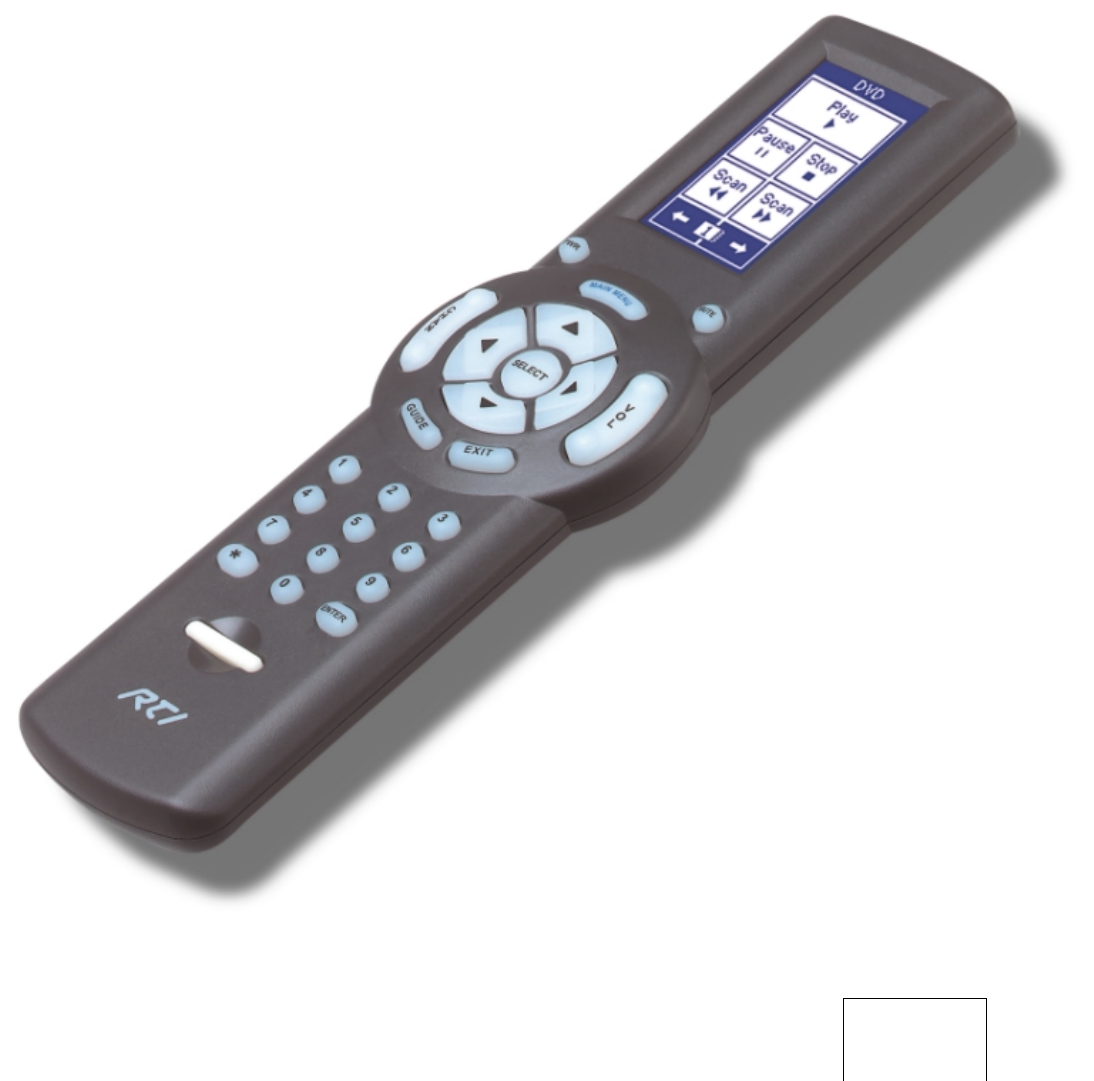
TheaterTouch
System Controller
User’s Guide and Programming Manual
T
Th
he
e
P
Po
ow
we
er
r
O
Of
f
A
A
T
To
ou
uc
ch
hs
sc
cr
re
ee
en
n
I
I
n
T
T
h
h
e
P
P
a
l
l
m
O
O
f
f

TheaterTouch System Controller
FEDERAL COMMUNICATIONS COMMISSION NOTICE
This equipment has been tested and found to comply with the limits for a Class B digital
device, pursuant to Part 15 of the FCC Rules. These limits are designed to provide
reasonable protection against harmful interference in a residential installation.
This equipment generates, uses, and can radiate radio frequency energy and, if not installed
and used in accordance with the instructions, may cause harmful interference to radio
communications. However, there is no guarantee that interference will not occur in a
particular installation.
If this equipment does cause harmful interference to radio or television reception, which can
be determined by turning the equipment off and on, the user is encouraged to try to correct
the interference by one or more of the following measures:
• Reorient or relocate the receiving antenna.
• Increase the separation between the equipment and the receiver.
• Connect the equipment into an outlet on a circuit different from that to which the
receiver is connected.
• Consult the dealer or an experienced radio/TV technician for help.
This device complies with Part 15 of the FCC Rules. Operation is subject to the following two
conditions: (1) this device may not cause harmful interference and (2) this device must accept
any interference received, including interference that may cause undesired operation.
For environmental reasons, your TheaterTouch universal system controller
uses “environmentally sound” nickel-metal hydride rechargeable batteries.
The batteries do not contain any poisonous heavy metals that can damage
the environment.
In the interest of recycling, please do not dispose of these batteries in the
household waste at the end of their useful life. Instead, dispose of them at
an appropiate collection site.
Copyright © 2000
Remote Technologies Incorporated
All rights reserved.
Part No. 70-210009-19
Printed in the United States

TheaterTouch System Controller
Remote Technologies Incorporated • 7630 Executive Dr. • Eden Prairie, MN • 55344-3677 USA
www.rticorp.com • Tel: 612-937-2600 • Fax: 612-937-7527
SAFETY SUGGESTIONS
Read Instructions. Read all safety and operating instructions before operating the unit.
Retain Instructions. Keep the safety and operating instructions for future reference.
Heed Warnings. Adhere to all warnings on the unit and in the operating instructions.
Follow Instructions. Follow operating instructions and instructions for use.
Heat. Keep the unit away from heat sources such as radiators, heat registers, stoves, etc.,
including amplifiers that produce heat.
Power Sources. Connect the unit only to a power supply of the type described in the
operating instructions, or as marked on the unit.
Power Cord Protection. Route power supply cords so that they are not likely to be walked
on or pinched by items placed on or against them, paying particular attention to the cords at
plugs, at convenient receptacles, and at the point at which they exit from the unit.
Nonuse Periods. Unplug the power supply from the outlet when the unit is to be left unused
for a long period.
Water and Moisture. Do not use the unit near water—for example, near a sink, in a wet
basement, near a swimming pool, near an open window, etc.
Object and Liquid Entry. Do not allow objects to fall or liquids to be spilled into the
enclosure through openings.
Cleaning. The unit should be cleaned only as recommended by the manufacturer.
Servicing. Do not attempt any service beyond that described in the operating instructions.
Refer all other service needs to qualified service personnel.
Damage Requiring Service. The unit should be serviced by qualified service personnel
when:
• The power supply cord or the plug has been damaged.
• Objects have fallen or liquid has been spilled into the unit.
• The unit has been exposed to rain.
• The unit does not appear to operate normally or exhibits a marked change in
performance.
• The unit has been dropped, or the enclosure damaged.
WARNING !
TO REDUCE THE RISK OF FIRE OR ELECTRIC
SHOCK, DO NOT EXPOSE THE UNIT TO RAIN OR
MOISTURE.

TheaterTouch System Controller
VI
LIMITED WARRANTY AND DISCLAIMER
Remote Technologies Incorporated warrants its products for a period of one (1) year from
the date of purchase from Remote Technologies Incorporated or an authorized Remote
Technologies Incorporated dealer.
This warranty may be enforced by the original purchaser and subsequent owners during the
warranty period, so long as the original dated sales receipt or other proof of warranty
coverage is presented when warranty service is required.
Except as specified below, this warranty covers all defects in material and workmanship in
this product. The following are not covered by the warranty:
Damage resulting from:
1. Accident, misuse, abuse, or neglect.
2. Failure to follow instructions contained in your User’s Guide.
3. Repair or attempted repair by anyone other than Remote Technologies
Incorporated.
4. Failure to perform recommended periodic maintenance.
5. Causes other than product defects, including lack of skill, competence or
experience of user.
6. Shipment of this product (claims must be made to the carrier).
7. Being altered or which the serial number has been defaced, modified or removed.
Remote Technologies Incorporated is not liable for any damages caused by its products or
for its failure of its products to perform, including any lost profits, lost savings, incidental
damages, or consequential damages.
Remote Technologies Incorporated is not liable for damages based upon inconvenience, loss
of use of the product, loss of time, interrupted operation, commercial loss, any claim made
by a third party or made by you for a third party.
Remote Technologies Incorporated’s liability for any defective product is limited to repair or
replacement of the product, at our option.
If your TheaterTouch system controller needs service, please contact Remote Technologies
Incorporated by telephone, fax or E-mail for return information (See Chapter 10). Please do
not return products to Remote Technologies Incorporated without return authorization.
All rights are reserved. No part of this document may be photocopied, reproduced, or
translated without the prior written notice of Remote Technologies Incorporated.
The information contained in this document is subject to change without notice. Remote
Technologies Incorporated shall not be liable for errors contained herein or for consequential
damages in connection with the furnishing, performance, or use of this material.
Microsoft and Windows are registered trademarks of Microsoft Corporation. Other brands
and their products are trademarks or registered trademarks of their respective holders.
TheaterTouch and the RTI logo are property of Remote Technologies Incorporated.

TheaterTouch System Controller
VII

TheaterTouch System Controller
VIII
Table of Contents
Federal Communications Commission Notice .......................................................................IV
Safety Suggestions.............................................................................................................V
Limited Warranty and Disclaimer......................................................................................... VI
CHAPTER 1. WELCOME................................................................................................... 1
Note .................................................................................................................................. 1
Unpacking and Inspection.................................................................................................... 1
Important ........................................................................................................................... 1
Product Contents................................................................................................................2
Software Requirements....................................................................................................... 2
CHAPTER 2. INTRODUCTION.......................................................................................... 3
Features ............................................................................................................................ 3
Important Notes.................................................................................................................. 4
Cleaning............................................................................................................................. 4
Batteries and Charger......................................................................................................... 5
Getting Started................................................................................................................... 6
Remote Reference.............................................................................................................. 7
The Touchscreen Display .................................................................................................... 8
The Control Panel Page ...................................................................................................... 8
CHAPTER 3. THEATERTOUCH DESIGNER
SOFTWARE ........................................ 15
Installing TheaterTouch Designer ........................................................................................15
Programming Overview ......................................................................................................15
TheaterTouch Designer Screen...........................................................................................16
Touchscreen Grid ..............................................................................................................18
Design Hints......................................................................................................................19
Getting Help......................................................................................................................19
CHAPTER 4. THEATERTOUCH DESIGNER BASICS.................................................. 21
How to Add a Page............................................................................................................21
How to Delete a Page........................................................................................................21
How to Add Buttons...........................................................................................................22
How to Delete Buttons .......................................................................................................22
How to Add Text to Buttons................................................................................................23
How to Place a Bitmap.......................................................................................................24
How to Link Pages.............................................................................................................25
How to Remove Page Links................................................................................................26
How to Add Commands to Buttons......................................................................................26
How to Delete Commands from Buttons ..............................................................................28
How to Save a File.............................................................................................................28
How to Open an Existing File..............................................................................................28
How to Preview your File....................................................................................................29
How to Setup Communications............................................................................................30
How to Send a File to the TheaterTouch..............................................................................31

TheaterTouch System Controller
IX
CHAPTER 5. THEATERTOUCH DESIGNER ADVANCED FEATURES...................... 33
How to Rename a Page .....................................................................................................33
How to Duplicate a Page....................................................................................................33
How to Merge Pages .........................................................................................................34
How to Use the PageWizard...............................................................................................35
How to Change Button Styles .............................................................................................35
How to Select Buttons........................................................................................................36
How to Cut or Copy Buttons ...............................................................................................36
How to Paste Buttons ........................................................................................................36
How to Move a Button........................................................................................................37
How to Resize a Button......................................................................................................37
How to Place a Custom Button...........................................................................................37
How to Use the Macro Editor..............................................................................................38
How to Delete a Macro ......................................................................................................43
How to Edit an IR Command in a Macro..............................................................................44
How to Use the Channel Macro Wizard................................................................................47
How to Edit the Remote Properties.....................................................................................50
How to Edit Button Properties.............................................................................................54
How to Edit the Properties of Multiple Buttons......................................................................59
How to Print Screenshots...................................................................................................62
How to Print System Configuration Reports .........................................................................62
How to Check Memory Usage ............................................................................................63
How to Create a “Self-Downloading .EXE”...........................................................................64
How to Use the “Send” Command.......................................................................................64
CHAPTER 6. IR LIBRARY MANAGER............................................................................ 65
Infrared Codes ..................................................................................................................65
How the TheaterTouch Learns IR Codes.............................................................................66
Hints for Learning IR Codes................................................................................................67
How to Open the IR Library Manager..................................................................................68
How to Create a New IR Library.........................................................................................68
How to Open an Existing IR Library.....................................................................................70
How to Add a New Remote to an IR Library ........................................................................71
How to Use the New Remote Wizard...................................................................................72
How to Align a Donor Remote Control.................................................................................73
How to Capture Infrared Commands ...................................................................................75
How to Test Infrared Commands ........................................................................................77
How to Edit Infrared Commands .........................................................................................78
CHAPTER 7. IMAGE EDITORS....................................................................................... 81
The Difference Between Custom Buttons and Bitmaps..........................................................81
Button Bitmap Editor Screen...............................................................................................82
Custom Button Editor Screen..............................................................................................82
Toolbar.............................................................................................................................83
Tool Palette.......................................................................................................................87
Up Image-Down Image Tool (Custom Button Editor Only):....................................................90
New Bitmap Size Dialog Box (Button Bitmap Editor Only):.....................................................92
CHAPTER 8. TROUBLESHOOTING .............................................................................. 93
Display is Dim, Blank or Unreadable....................................................................................93
Communication Problems ...................................................................................................93

TheaterTouch System Controller
X
Infrared Problems..............................................................................................................95
Unable to Learn Commands................................................................................................96
Macro Problems................................................................................................................96
CHAPTER 9. SERVICE AND SUPPORT........................................................................ 97
Updates and New Products ................................................................................................97
Contacting Remote Technologies Incorporated ....................................................................97
RTI Technical Support........................................................................................................97
Shipment of Remote for Service..........................................................................................99
SPECIFICATIONS .......................................................................................................... 100
APPENDIX ...................................................................................................................... 102
Software License Agreement............................................................................................102
Software License.............................................................................................................102

Chapter 1 • Welcome
1
Chapter 1. Welcome
Congratulations on your purchase of the TheaterTouch universal system controller.
The TheaterTouch combines the power and flexibility of a graphic LCD touchscreen
with an ergonomic design that permits effortless one-handed operation. This design
overcomes the need for compromise between form and function. Sleek and perfectly
balanced, the TheaterTouch is infinitely flexible and expandable.
TheaterTouch takes complete control of the home theater, replacing all other remotes.
It features an intuitive, easy to read LCD that can display custom buttons, text,
graphics and symbols. In addition to the backlit display, 25 “Hard” keypad buttons
allow easy access to frequently used functions.
Programming is easy and convenient thanks to the built-in infrared learning ability
and the Windows® based software. TheaterTouch is capable of both infrared and radio
frequency output. A separate RF to IR converter is available for transmission through
walls and cabinets. The converter will also monitor the power status of most A/V
equipment thru the use of voltage and video sensors.
NOTE The TheaterTouch and TheaterTouch Designer software are compatible with infrared
(IR) commands with carrier frequencies between 15kHz and 460kHz, as well as those
commands that do not use a carrier. This covers the vast majority of remotes
available to date, including Bang & Olufsen® (most of which use 455kHz) and
Vidikron® (some of which use 333kHz).
Despite every effort to make the TheaterTouch universal system controller work with
all IR-systems, some IR-controlled products are unable to be learned by the
TheaterTouch due to incompatible frequencies or non-standard IR formats. The
TheaterTouch cannot learn non-IR formats such as RF and ultrasonic.
UNPACKING AND INSPECTION
After unpacking your new TheaterTouch universal system controller, save all of the
packing materials in case you ever have to ship the unit.
Thoroughly inspect the TheaterTouch and packing materials for signs of damage.
Report any damage to the carrier immediately. Report any equipment malfunctions
to Remote Technologies Incorporated or an authorized Remote Technologies
Incorporated dealer.
IMPORTANT
After unpacking your new TheaterTouch universal system controller for the first time,
charge each battery pack for at least 12 hours.

TheaterTouch System Controller
2
PRODUCT CONTENTS
Contents within the box include the following items:
• Owner’s Manual
• Warranty and Registration card
• TheaterTouch™ System Controller
• Two (2) rechargeable Nickel Metal-Hydride battery packs
• Smart battery charger
• Wall-mount power supply for battery charger
• TheaterTouch Designer™ software CD-ROM
• Serial cable for programming
SOFTWARE REQUIREMENTS
TheaterTouch Designer software minimum system requirements:
• Windows 95, Windows 98,Windows NT 4.0 or higher operating
system
• IBM or compatible PC with 486DX2/66Mhz or higher
processor
• 16 Megabytes (MB) of RAM
• 8 Megabytes of free disk space for minimum installation
(16 MB recommended)
• A mouse is required
• VGA monitor (256 color Super VGA recommended)
• CD-ROM drive
• Open RS-232 serial port
• Optional printer for printing setup reports

Chapter 2 • Introduction
3
Chapter 2. Introduction
The TheaterTouch is a programmable touchscreen computer that is designed to
provide wireless control of audio/video and automation systems. Like other
“universal” or “learning” remote controls, the TheaterTouch allows you to consolidate
the functions of many independent infrared remote controls into one unit. The
TheaterTouch also incorporates a unique programmable user interface, allowing it to
provide a simple, intuitive, and customized interface for any system. Before using the
TheaterTouch, please read and follow all instructions in this manual.
FEATURES
The TheaterTouch provides superior quality and reliability as well as these specific
features:
• A replacement for all of your system’s remote controls. The TheaterTouch can
reproduce all of the commands of almost any other infrared remote control.
• A programmable graphic display. The TheaterTouch uses powerful Windows
based software that makes it easy to place buttons, text, graphics and symbols
anywhere on the display.
• A backlit LCD with digital matrix touchscreen. When you want to perform a
command, simply touch the display where that command is displayed. The
touchscreen never needs calibrating.
• 25 backlit “hard” keypad buttons that allow easy access to frequently used
functions.
• Two detachable, low-profile rechargeable battery packs. The TheaterTouch can
run continuously for several hours between charges. Because the remote is
normally used only a few minutes per session, the unit typically will run for a
week or more between charges. A built-in low battery indicator warns you
when it’s time to recharge the battery.
• A macro function. This feature allows the TheaterTouch to perform a series of
commands by pressing a single button. For example, you can create a macro
called “Movie” that turns on the TV, sets the correct channel, turns on the
VCR, dims the lights, and starts playing a movie.
• Two output options for controlling your equipment: infrared (IR), radio
frequency (RF), and the ability to use both in the same system.
• Automatic power on and off. The TheaterTouch turns itself off whenever it is
not used for a pre-set amount of time. Touching any area of the display or a
hard button will turn it on again, also a built in tilt sensor can turn the unit on
when it is picked up.

TheaterTouch System Controller
4
• A serial port for communication with the TheaterTouch Designer programming
software.
• Non-volatile flash memory. The TheaterTouch will not lose any programmed
data when the batteries are exchanged.
• One-year parts and labor warranty.
IMPORTANT NOTES
Please read these important notes about the TheaterTouch:
• The TheaterTouch should be placed in an area where it is around normal room
temperature (between 60°F to 90°F). If the temperature is too hot, the display
appears dim. If the temperature is too cold, the display appears dark and may
respond slowly.
• Do not use sharp objects on the touchscreen. It is designed to operate with a
touch of your finger.
• Do not let the TheaterTouch get wet. It should not be handled with wet hands
or placed in an area where it could get wet.
• Do not subject the TheaterTouch to smoke, dust, or vibrations. The display may
be damaged from excessive shock or vibration.
• Use only the power supply that is provided with the TheaterTouch. Using the
wrong type of power supply may result in battery leakage or other damage.
• Do not disassemble the unit. The TheaterTouch contains high voltage circuits
that may cause injury if contacted.
CLEANING
Occasional cleaning may be required, depending on use.
To clean your TheaterTouch:
1. Remove the battery pack from the TheaterTouch.
2. Lightly dampen a lint-free cloth with water or mild detergent and wipe the
touchscreen, keypad and outer surfaces.
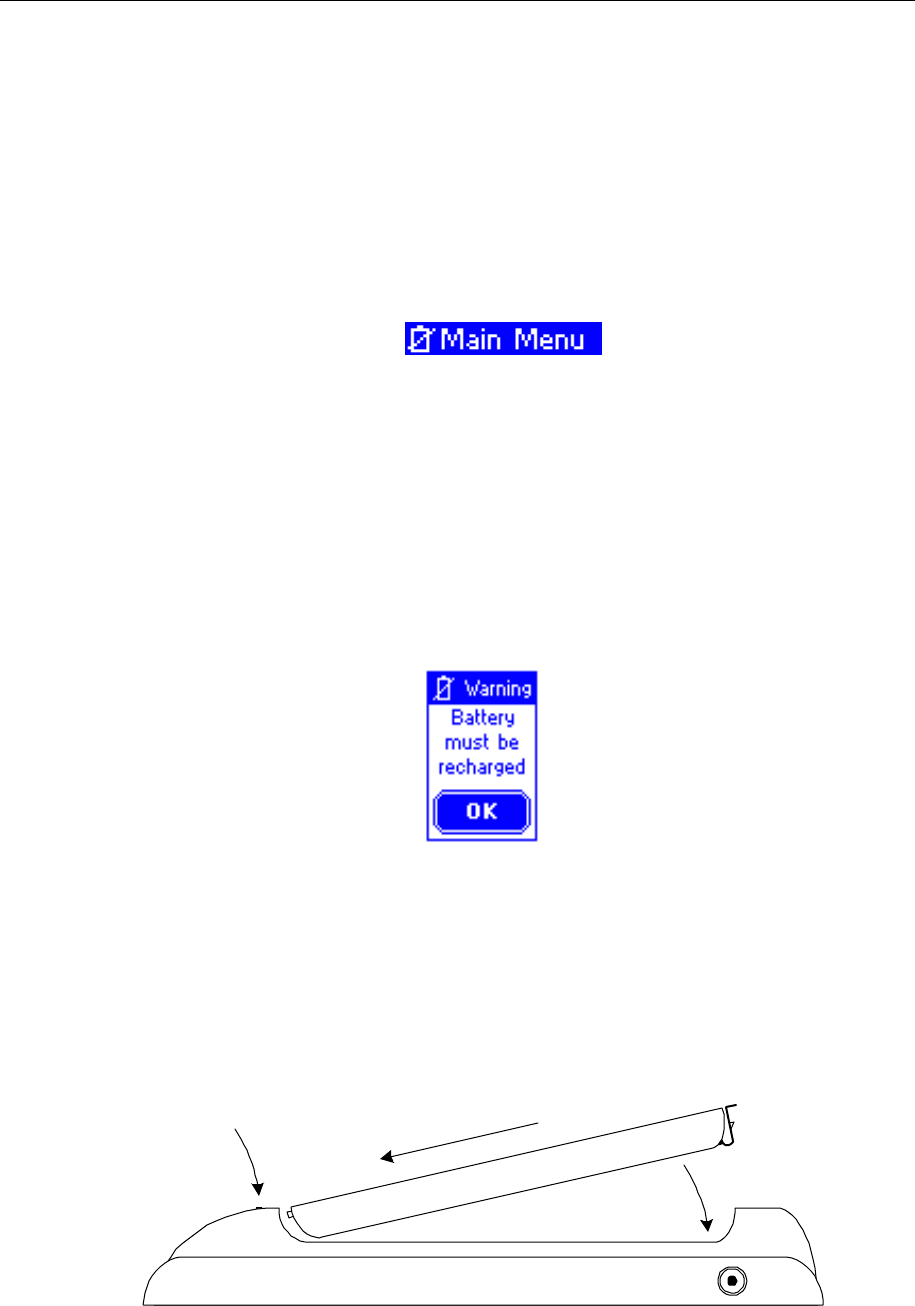
Chapter 2 • Introduction
5
BATTERIES AND CHARGER
The following recommendations will assure the best battery performance.
1. Operate the unit until you receive a Low Battery warning in the upper left
hand corner of display.
2. At that point, you will have approximately 10 - 20 minutes of run time
remaining before the unit shuts down. At any point after the Low Battery
icon appears, you can exchange the depleted battery with a charged
battery from the charger. If you operate the battery past a usable level,
you will receive a warning stating Battery must be recharged.
Recharge the TheaterTouch batteries for about 3-4 hours. (The light on the battery
charger will stop flashing and stay on when the charge cycle is completed).
The batteries can remain in the charger indefinitely without damage to the batteries.
Charging Status
Light (1)
(2)
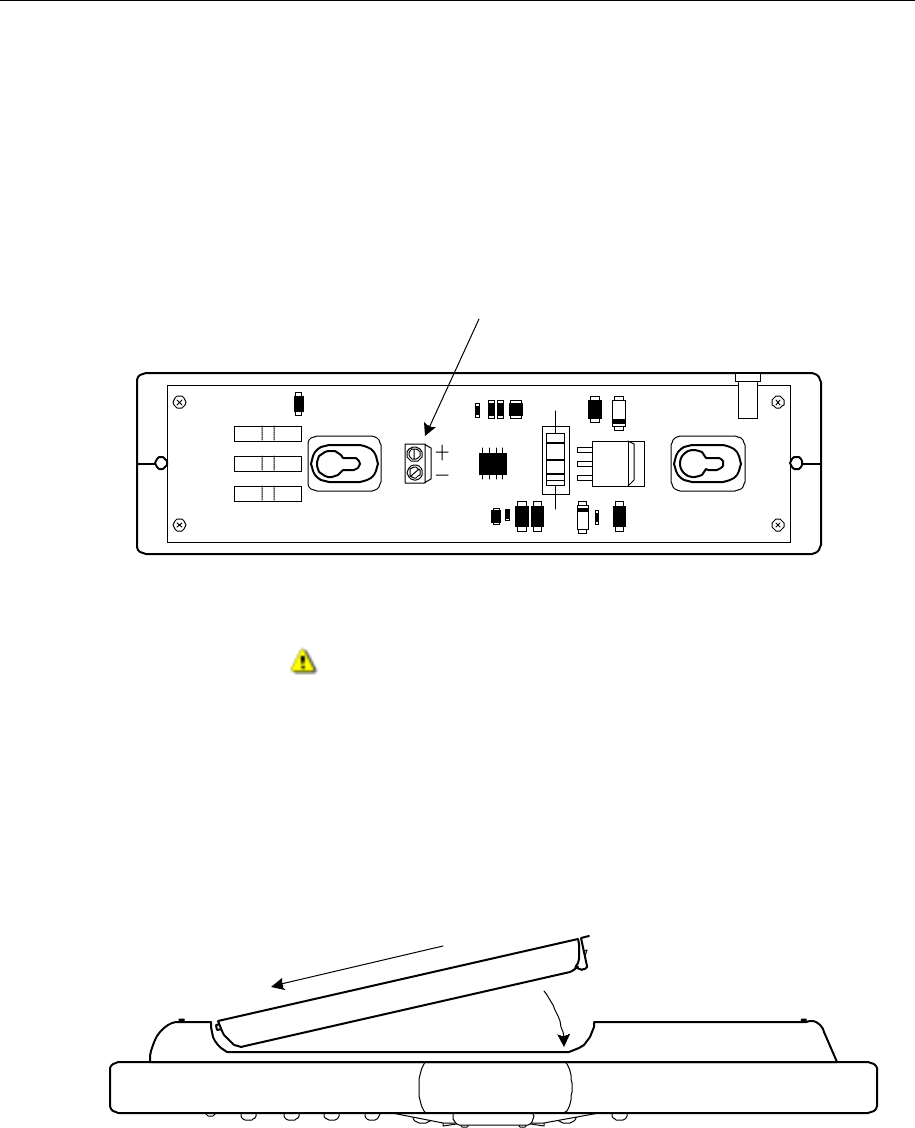
TheaterTouch System Controller
6
Custom Installation Note:
The TheaterTouch battery charger’s power can be hardwired through the back of the charger
for permanent mounting on a wall or other flat surface. This is done by removing the
bottom plate of the charger and hard wiring the wall mount power supply directly to the
terminal strip. Replace the bottom plate before mounting.
Use only the original power supply.
J2
Power Connection - (J2)
9VDC 0.5A
Battery Charger with bottom plate removed.
GETTING STARTED
Start by snapping a fully charged battery on the back of the TheaterTouch. This is done by
inserting the end of the battery with the contacts in first, and then gently pushing the end
with the clip until it snaps into place.
(1)
(2)
The TheaterTouch is powered-up by touching any area of the display or any keypad button as
well as picking up the unit if the tilt sensor is active.
Warning! Watch the polarity.
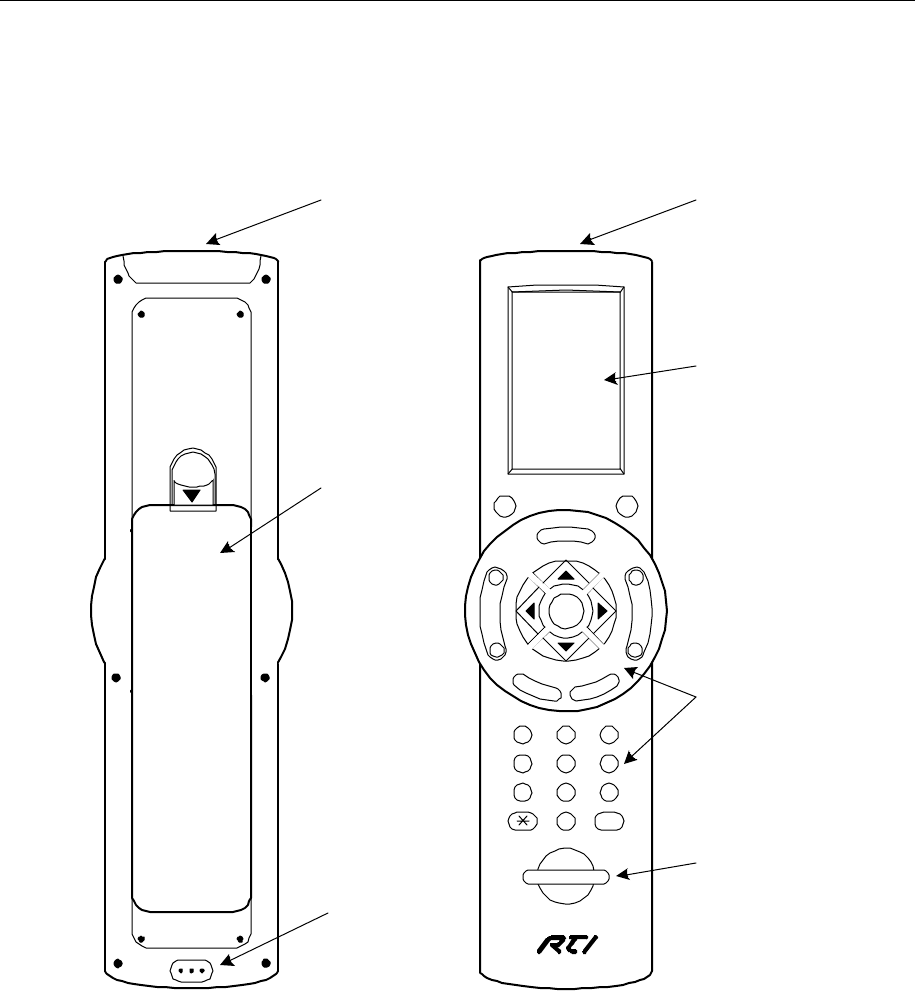
Chapter 2 • Introduction
7
REMOTE REFERENCE
Transmitting and
Learning Window
Touchscreen
Backlight Key
Programmable
Keypad Buttons
PWR MUTE
12 3
456
78 9
0ENTER
SELECT
C
H
A
N
V
O
L
EXIT
GUIDE
MAIN MENU
Transmitting and
Learning Window
Serial
Port
Rechargeable
Battery Pack
FrontBack
(Glows in the Dark)
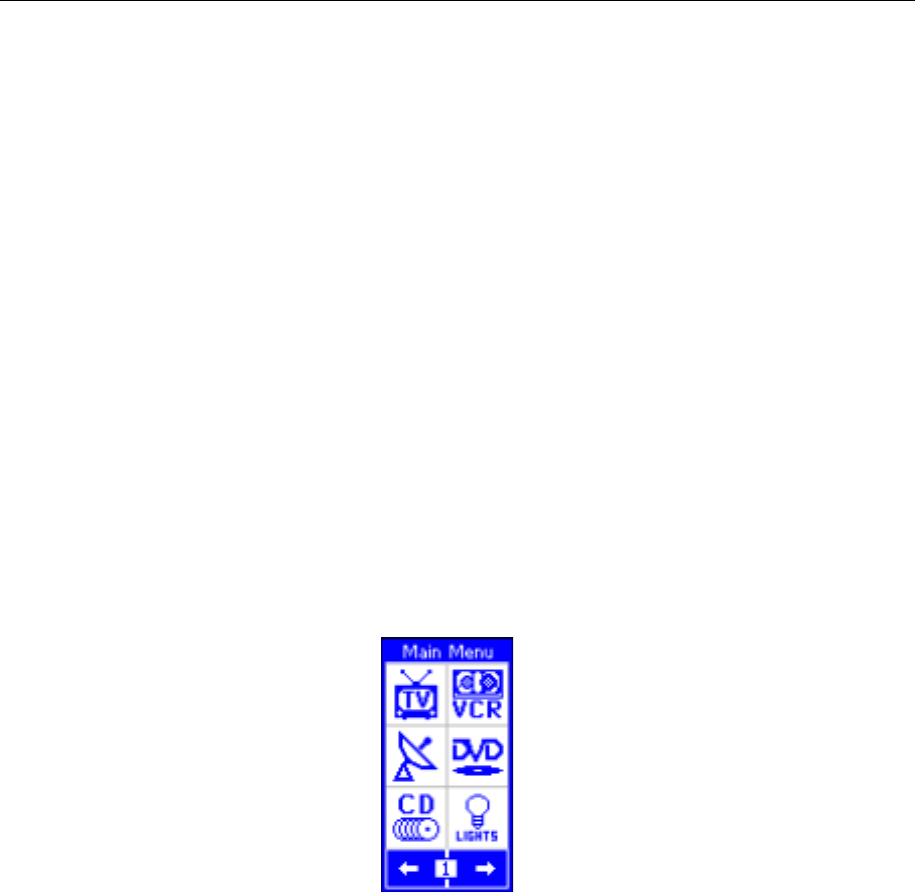
TheaterTouch System Controller
8
THE TOUCHSCREEN DISPLAY
The TheaterTouch touchscreen display is organized as a series of pages and frames. A
page can consist of up to 12 frames of information having one frame displayed on the
screen at a time.
Normally each frame on a page contains objects (buttons, text, graphics, and symbols)
that are related in some way. For instance, they may all display information
necessary for controlling a particular VCR.
By default, the TheaterTouch has one Main Menu page—all other pages are
considered submenus. Any page can contain a button that will display any other
page when selected.
Normally the Main Menu page is used to display the names of the submenus (e.g.,
the equipment being controlled). The submenus may consist of one or more pages.
The TheaterTouch will support 63 pages plus the Main Menu page; each page can
consist of up to 12 frames.
A representation of a programmed Main Menu page is shown below.
Pressing the Main Menu key at any time will return you to this page (unless a
different page is assigned using the TheaterTouch Designer software).
THE CONTROL PANEL PAGE
The Control Panel page can be displayed by pressing the backlight key for at least 3
seconds.
You can also access the Control Panel page by assigning a “Control Panel” page link
to a button using the TheaterTouch Designer software.
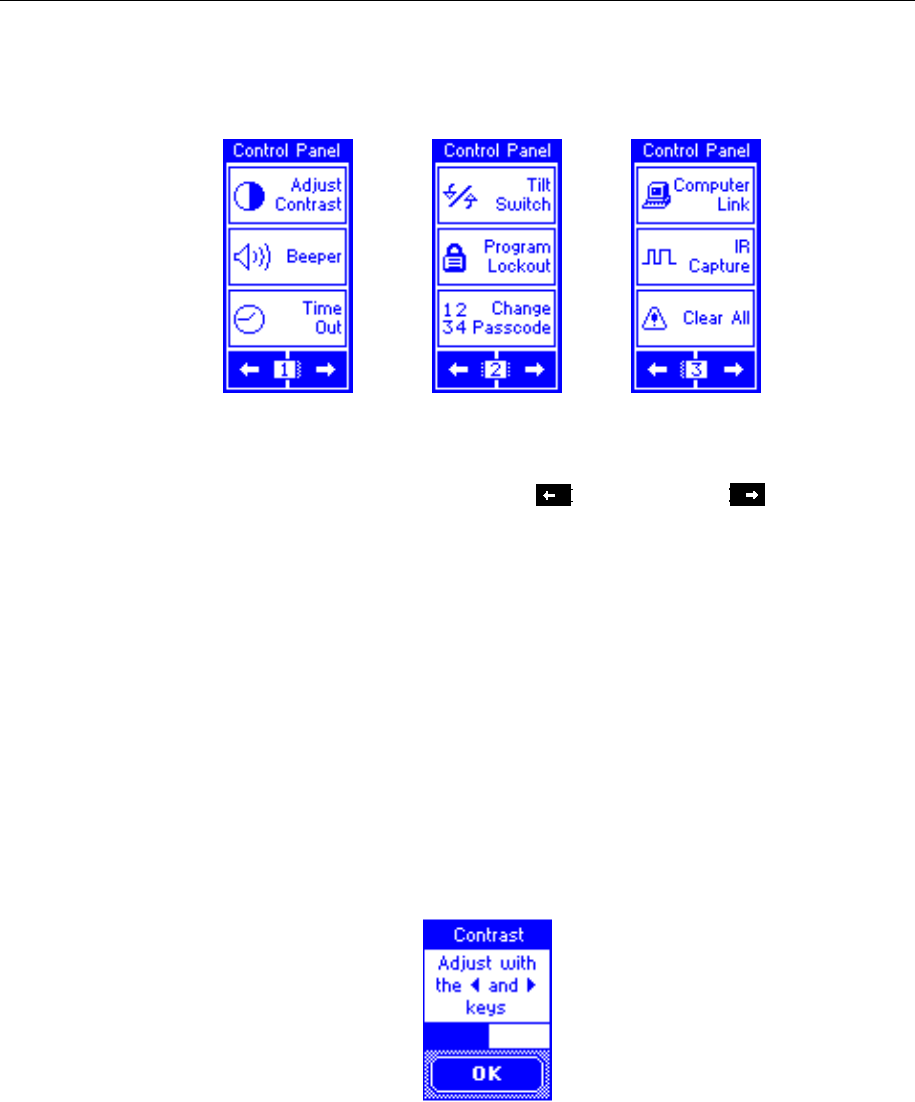
Chapter 2 • Introduction
9
The Control Panel consists of the following three frames:
To change frames, press the frame Left or frame Right buttons on
the bottom of the touchscreen.
To return to your TheaterTouch program, press the Main Manu key.
ADJUST CONTRAST
This button displays a window that allows you to adjust the LCD contrast.
Press the Left Arrow or Right Arrow keypad buttons to adjust. Press the OK
button in the window to close.
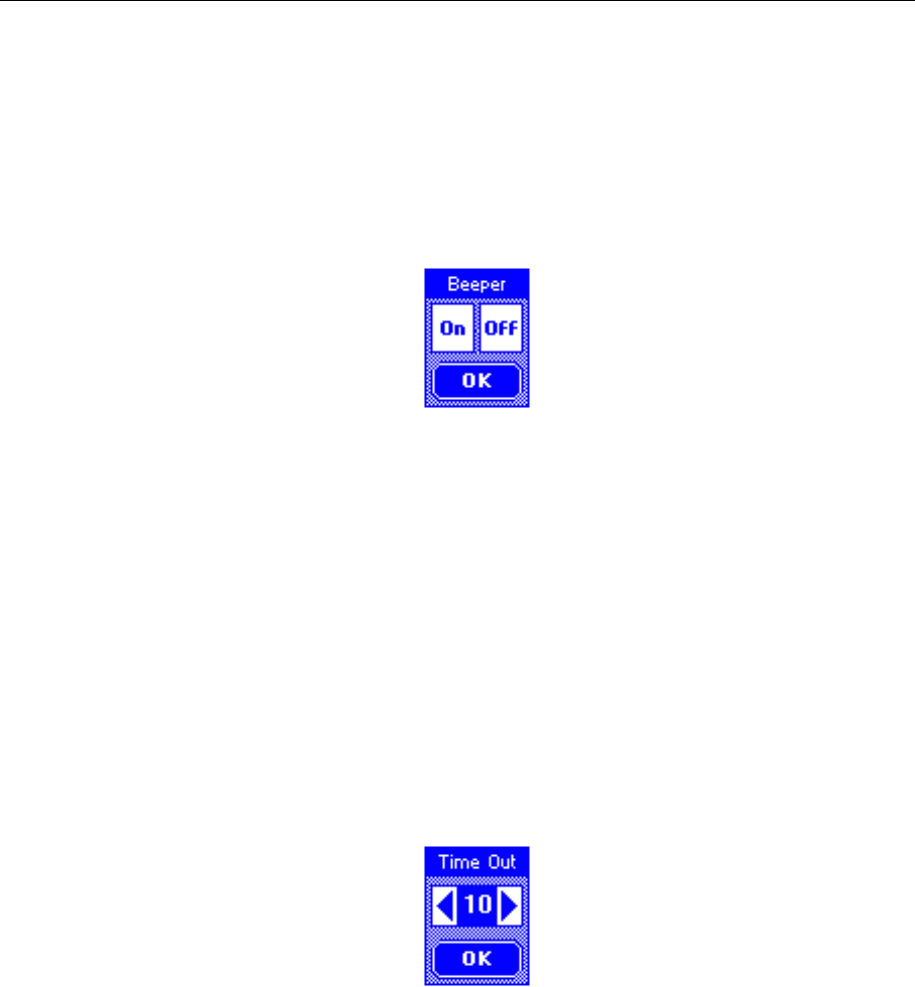
TheaterTouch System Controller
10
BEEPER
This button displays a window that allows you to turn the audible beep on or
off. The beeper provides feedback that a button was pressed. Press the OK
button in the window to close.
TIME OUT
This button displays a window that allows you to adjust the amount of time
the unit stays awake after the last button press. The time is variable from 1
second to 60 seconds (default is 10 seconds). Press the arrows to the left or
right of the Time Out setting to adjust the time. Press the OK button in the
window to close. During Sleep mode, the TheaterTouch uses virtually no
battery power.
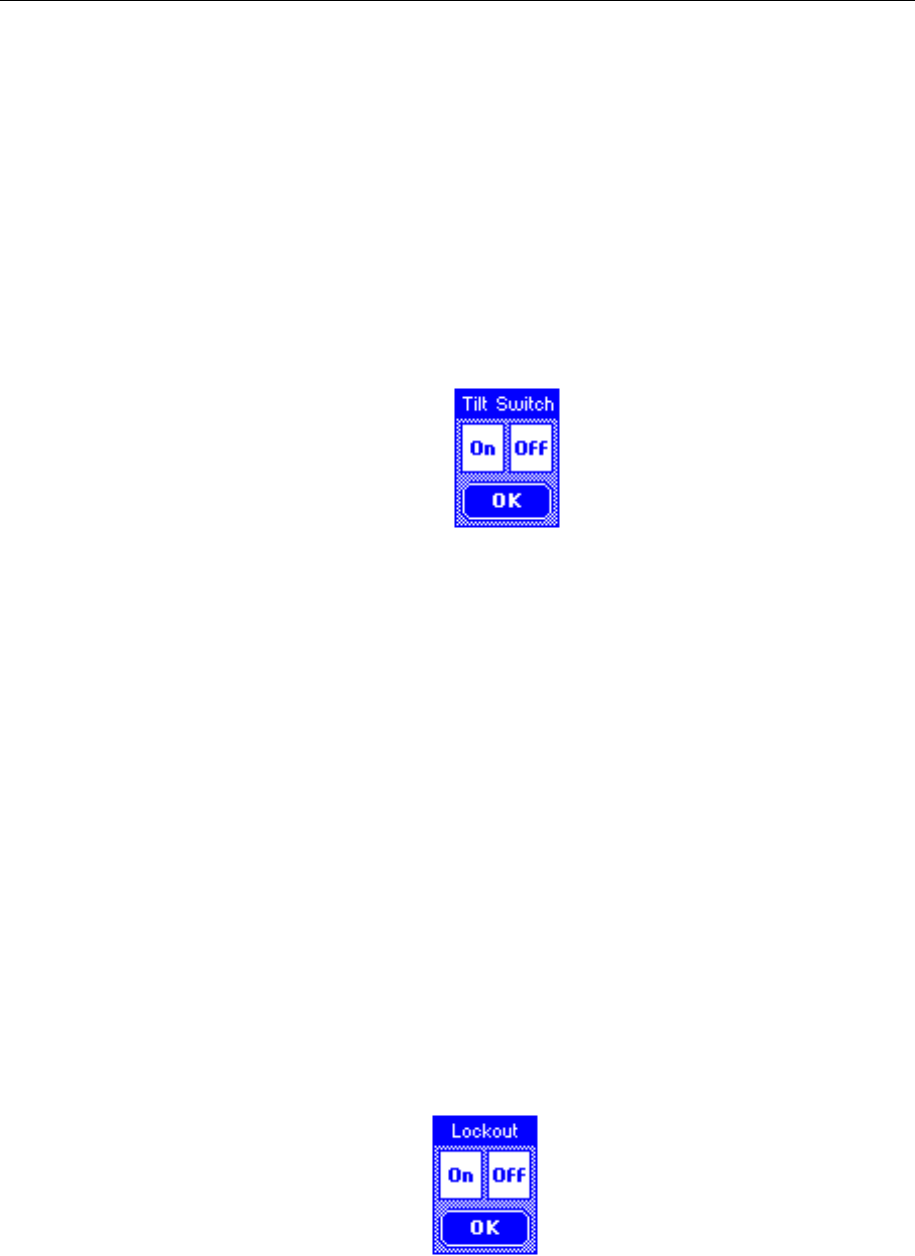
Chapter 2 • Introduction
11
TILT SWITCH
This button displays a window that allows you to adjust the settings for the
built in tilt switch, which is a device that turns the remote on when tilted
passed a 45 degree angle.
On means the tilt switch is active and will turn on display and backlight when
picked up.
Off means the tilt switch is inactive.
Press the OK button in the window to close.
PROGRAM LOCKOUT
This button displays a window that allows you to turn the program lockout
feature on and off. This is used to lockout un-authorized users from the
Computer Link mode, so that the program cannot be altered.
If the Lockout feature is enabled, you will need to enter the current passcode
before you can change this setting.
On means the Computer Link mode is locked and can only be accessed with
the passcode.
Off means the Computer Link mode is unlocked and can be accessed without
a passcode.
Press the OK button in the window to close.
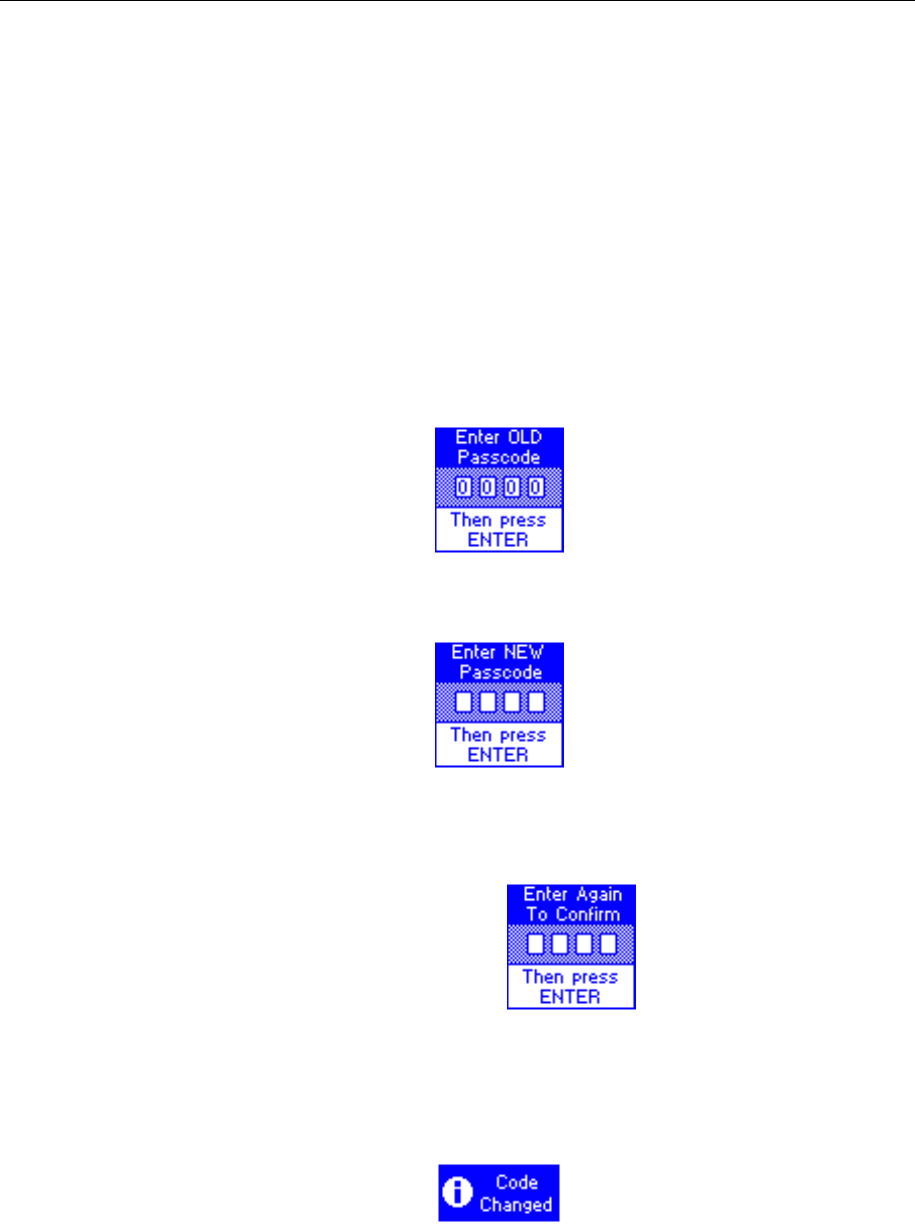
TheaterTouch System Controller
12
CHANGE PASSCODE
This button displays a window that allows you to set the passcode that is used
to limit access to the Computer Link mode and Clear All function on the
control panel page, as well as the Button Lockout function that is available on
all buttons.
When you press the Change Passcode button, the screen will prompt you to
enter the old passcode using the hard keys, then press the Enter key on the
keypad.
(The default code is 0000).
Now enter a new four-digit passcode, then press Enter.
You will be prompted to enter the new four-digit passcode again for
confirmation, then press Enter.
When new code is entered successfully, the Code Changed window
will pop up to let you know you have changed the passcode.
Do not forget the passcode!
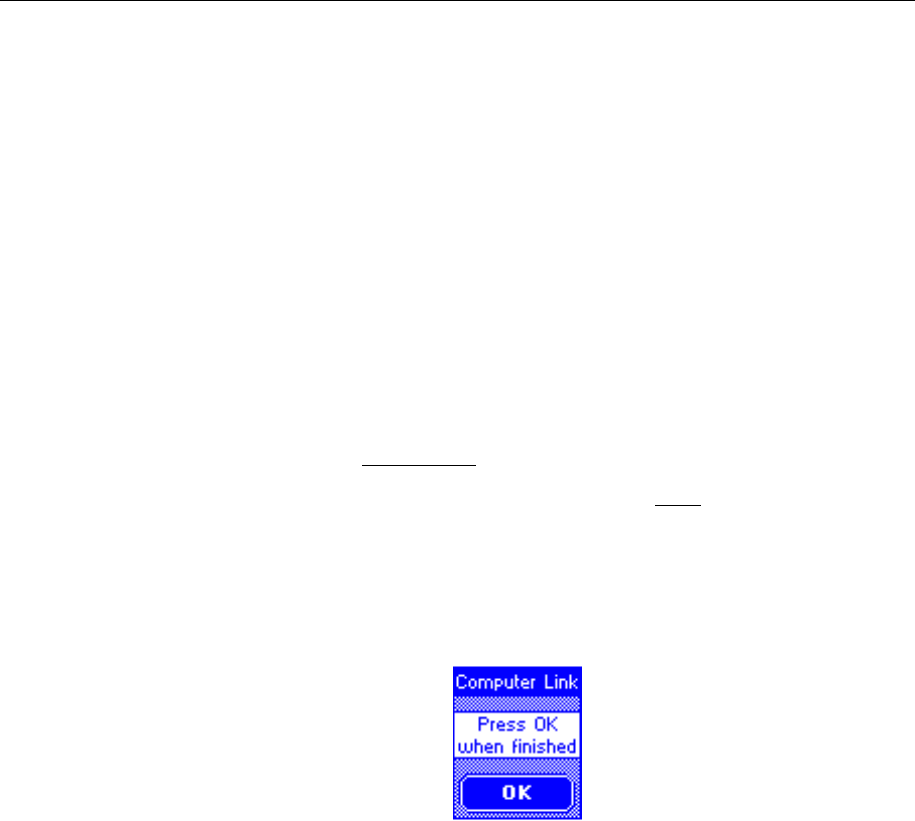
Chapter 2 • Introduction
13
COMPUTER LINK
This button displays a window that allows you to put the TheaterTouch into
Computer Link mode.
This is used for RS-232 communications between a personal computer and the
TheaterTouch for loading a program into the TheaterTouch or extracting a
program from the TheaterTouch.
The two options available for the transfer of a program in the TheaterTouch
Designer software are:
♦ Send File to Remote, which sends the new program from the software
to the remote, overwriting the existing program.
♦ Receive File from Remote, which extracts a copy of the program from
the remote to the software, leaving the program in the remote intact.
Press the OK button to close the window after the transfer is complete.

TheaterTouch System Controller
14
IR CAPTURE
This button displays a window that allows the TheaterTouch to align, learn,
and test infrared commands from donor remotes. Used together with the
TheaterTouch Designer Infrared Library Manager software you can create a
custom database of infrared commands.
The use of the IR Capture command is described in chapter 6 “IR Library
Manager”.
To exit IR CAPTURE mode, press the Main Menu button on the remote.
CLEAR ALL
This button displays a window that will allow you to erase the current
program in the TheaterTouch remote. When the button is pressed, you will be
prompted to enter the current passcode. If the proper code is entered, the
entire program in the TheaterTouch will be erased.
WARNING
This will erase the complete program in the TheaterTouch with no way to
restore it, except by reloading the program from the TheaterTouch Designer
software!
If you inadvertently press the CLEAR ALL button, simply press the ENTER
button without entering the passcode and you will be returned to the Control
Panel page.

Chapter 3 • TheaterTouch Designer Software
15
Chapter 3. TheaterTouch Designer
Software
TheaterTouch Designer allows you to create the entire graphical interface for a RTI
TheaterTouch System Controller on your computer. Once the interface has been
created, it is downloaded to the TheaterTouch using the included programming cable.
Existing programming can also be extracted, modified, and re-sent to any
TheaterTouch system controller.
Software updates will be available for download at www.rticorp.com
INSTALLING THEATERTOUCH DESIGNER
1. Close any open programs.
2. Place the TheaterTouch Designer compact disc into the CD- ROM drive.
3. If the installation doesn’t appear automatically, click Start and choose
Run, type d:\setup\setup.exe (For d, type the letter for your CD-ROM
drive). Click OK.
4. Follow the on-screen instructions.
PROGRAMMING OVERVIEW
Here is an overview of the process of programming a TheaterTouch from scratch.
Instructions on carrying out these tasks can be found in chapters 4 and 5.
1. Create a new page and add buttons for each source component in a
system.
2. Place a button on the main menu to access each one of the source
components.
3. Use the Assign Page tool to link the buttons on the main menu to their
respective source component pages.
4. Assign infrared codes and other commands to buttons using the
Command Library.
5. Create macros using the macro editor (if needed).
6. Check the Remote Properties.
7. Save the file.
8. Send the file to the TheaterTouch using the communications commands.
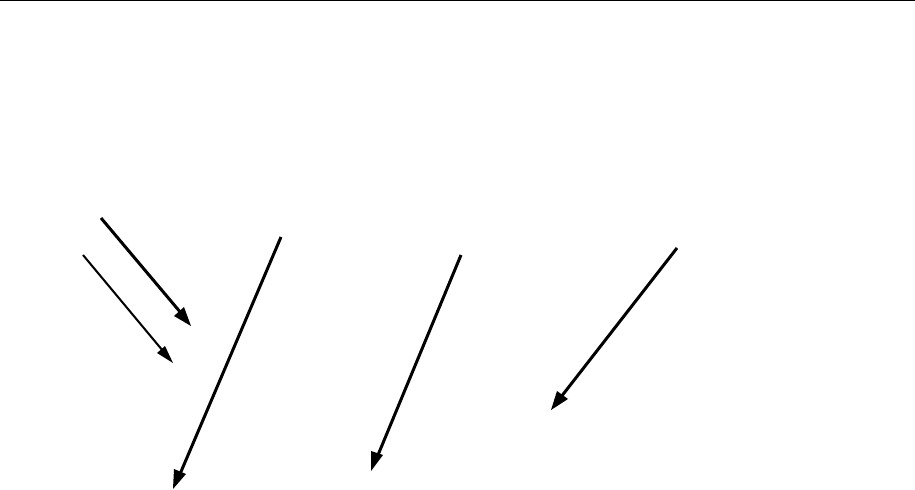
TheaterTouch System Controller
16
THEATERTOUCH DESIGNER SCREEN
Menu Bar
Toolbar Page List Touchscreen
grid Design Window
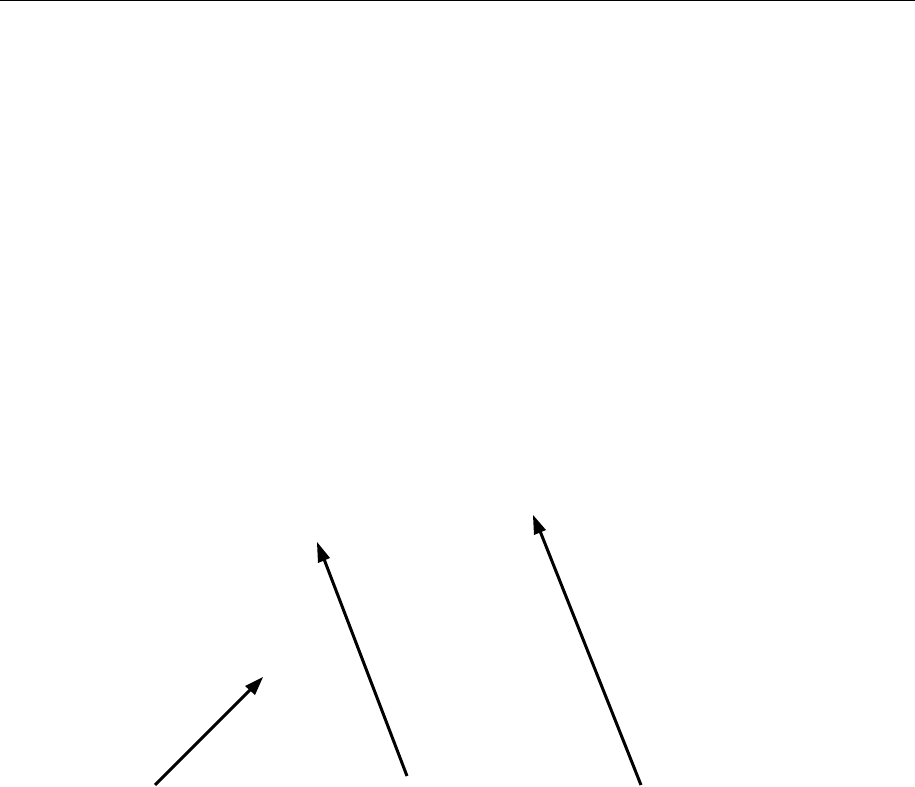
Chapter 3 • TheaterTouch Designer Software
17
Frame Left and
Right arrows
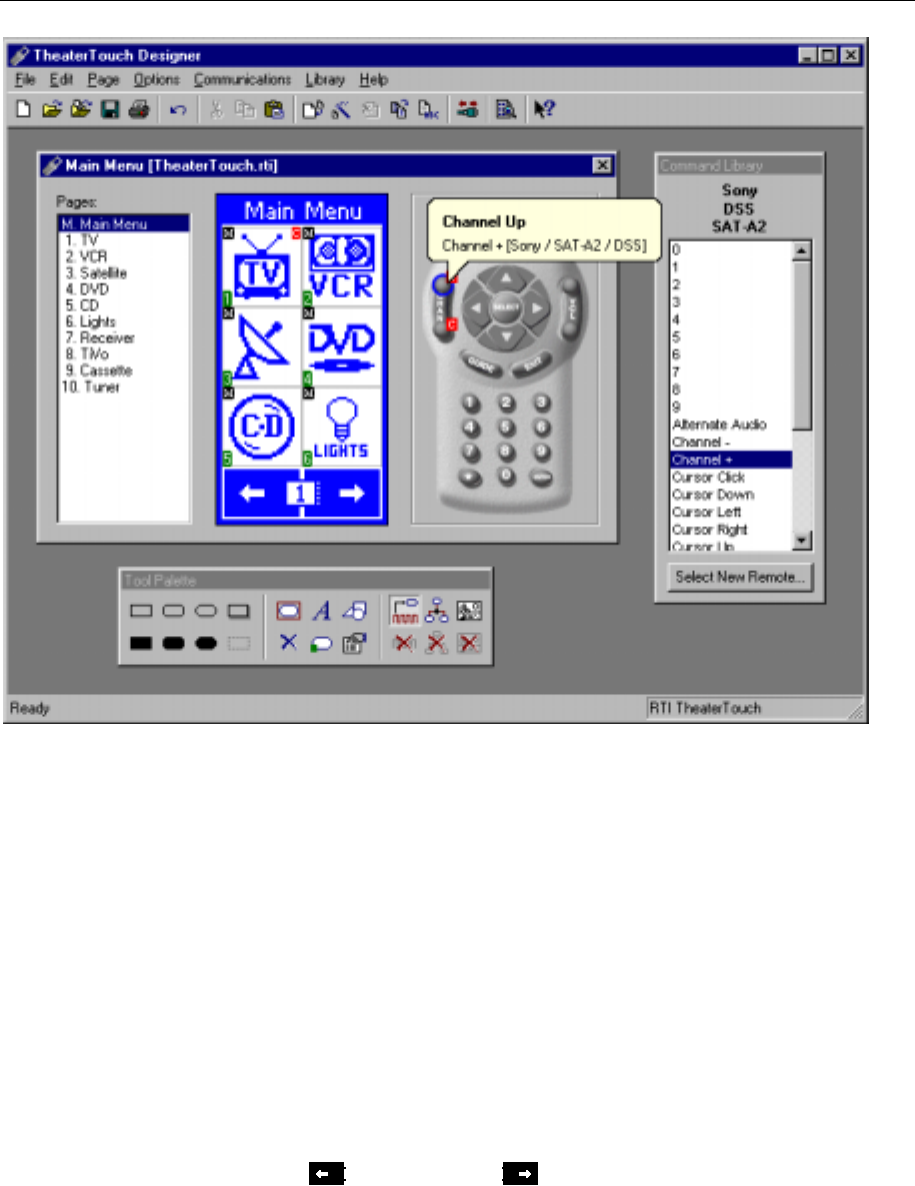
TheaterTouch System Controller
18
TOUCHSCREEN GRID
The touchscreen grid is where the buttons, text, graphics and symbols are placed.
Click on the frame Left or frame Right buttons at the bottom of the
touchscreen grid to place buttons on other frames.
Tool Palette Keypad Buttons
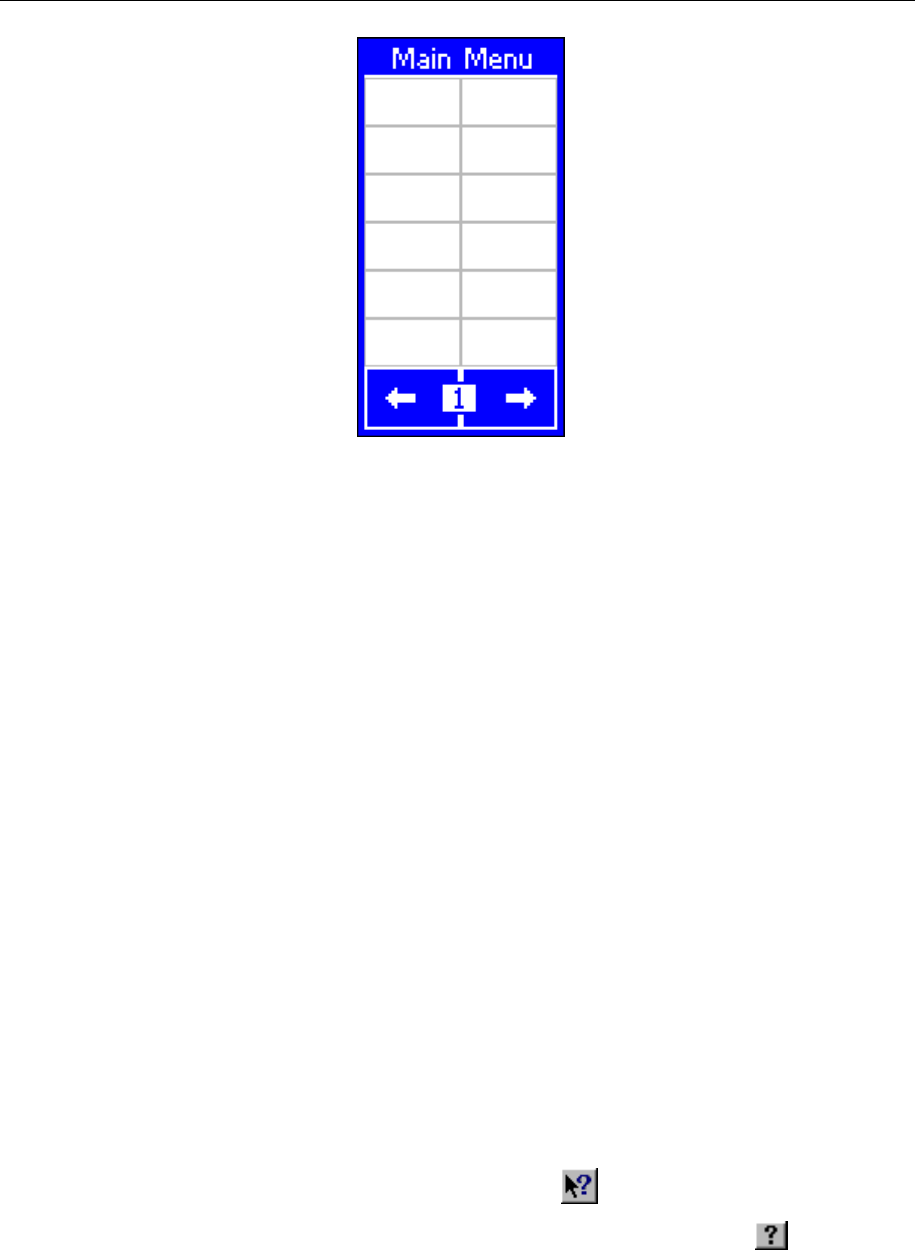
Chapter 3 • TheaterTouch Designer Software
19
DESIGN HINTS
1. Be consistent with the location of similar buttons. For example, if you
have a DVD player and a VCR in your system, try to make the transport
controls (Play, Pause, Stop, etc.) on both pages look similar.
2. It’s not necessary to re-create each donor remote in its entirety on the
TheaterTouch. Think of the functions the user will be using daily.
3. Use macros to hide complex command sequences from the user. For
example, instead of presenting the user with only the key pad for
changing channels on their TV, make a set of macros for CBS, HBO, etc.
that send the proper channel numbers automatically. The Channel Macro
Wizard makes it easy to create this type of macro.
GETTING HELP
TheaterTouch Designer includes an extensive on-line help system. If you need help
with any tool or command, click the What’s this? button on the Toolbar.
If you need an explanation of any item in a dialog box, click the Help button in
the dialog’s title bar, and then click on the control you would like to learn about.

TheaterTouch System Controller
20
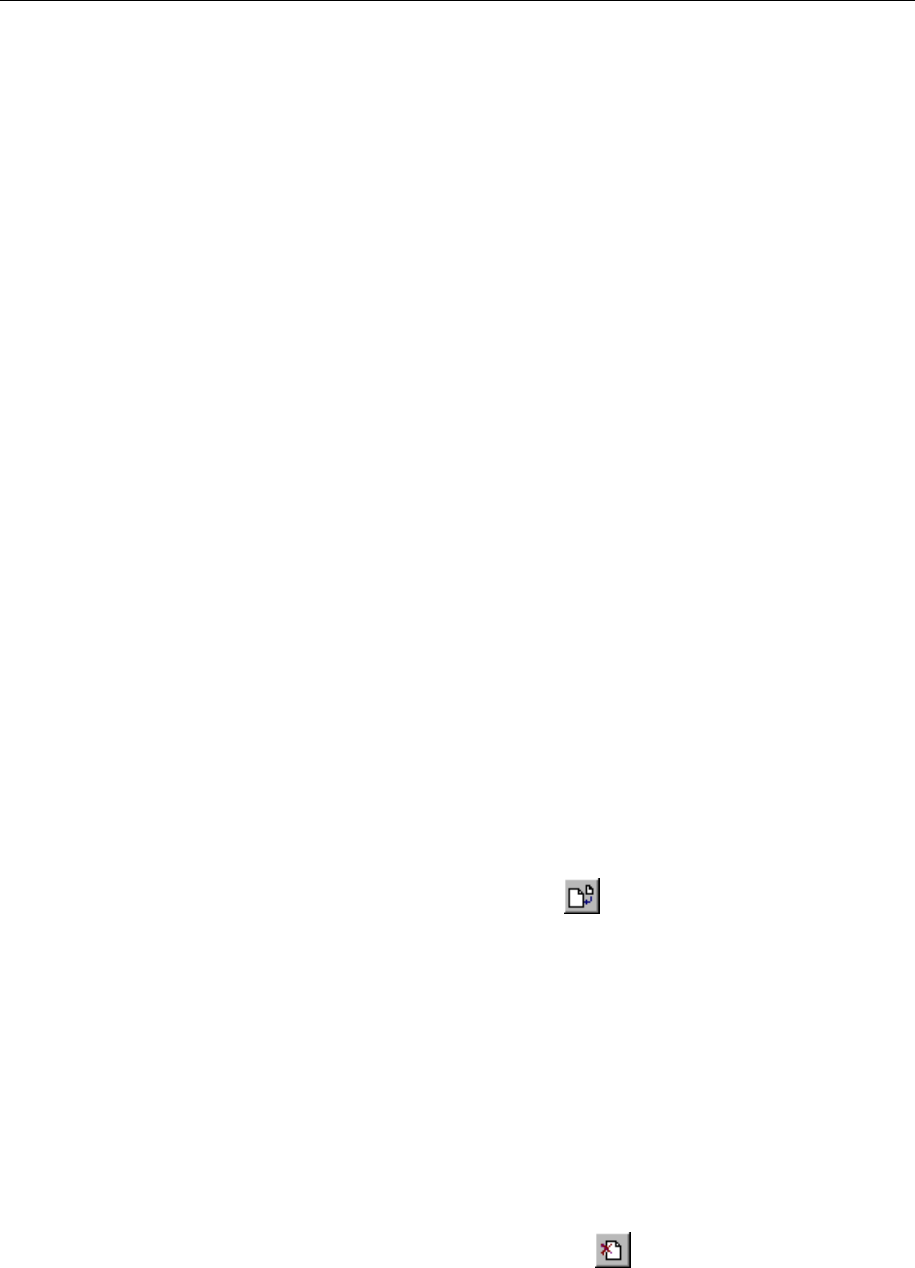
Chapter 4 • TheaterTouch Designer Basics
21
Chapter 4. TheaterTouch Designer Basics
The TheaterTouch system controller is divided into two sections: the touchscreen and
the keypad. You can assign commands, macros and page links to any button you
create on the touchscreen or on the keypad buttons.
The keypad button layout of the TheaterTouch follows the pages, not the frames, so all
12 frames of a page will have the same commands, macros and page links on the
keypad buttons. Each frame of the touchscreen can have different commands, macros
and page links.
PAGES
The individual screens on the TheaterTouch system controller are called pages. Pages
on the touchscreen can contain buttons, links to other pages, a title, text, commands,
and macros.
The page links, commands and macros associated with the keypad buttons on the
TheaterTouch are also stored with each page.
Each page can have up to 12 frames on the touchscreen, and usually has the controls
for just one component. Each frame is accessed by scrolling left and right with the
arrows at the bottom of the TheaterTouch touchscreen. With TheaterTouch Designer,
you can add and delete pages, duplicate pages, etc.
All TheaterTouch pages have a page title. The page title is the name that appears in
the title bar above the Touchscreen grid and in the Page List.
HOW TO ADD A PAGE
1. Click the Create New Page Command on the Toolbar.
2. Enter a name for the page in the New Page Title dialog, this is usually the
name of the component, such as: CD, Satellite, Lights and so on.
3. Click OK.
Repeat this procedure for each page you wish to add.
HOW TO DELETE A PAGE
1. Select the page to be deleted from the Page List.
2. Click the Delete Current Page Command on the Toolbar.
3. Click Yes in the Delete Page confirmation box.
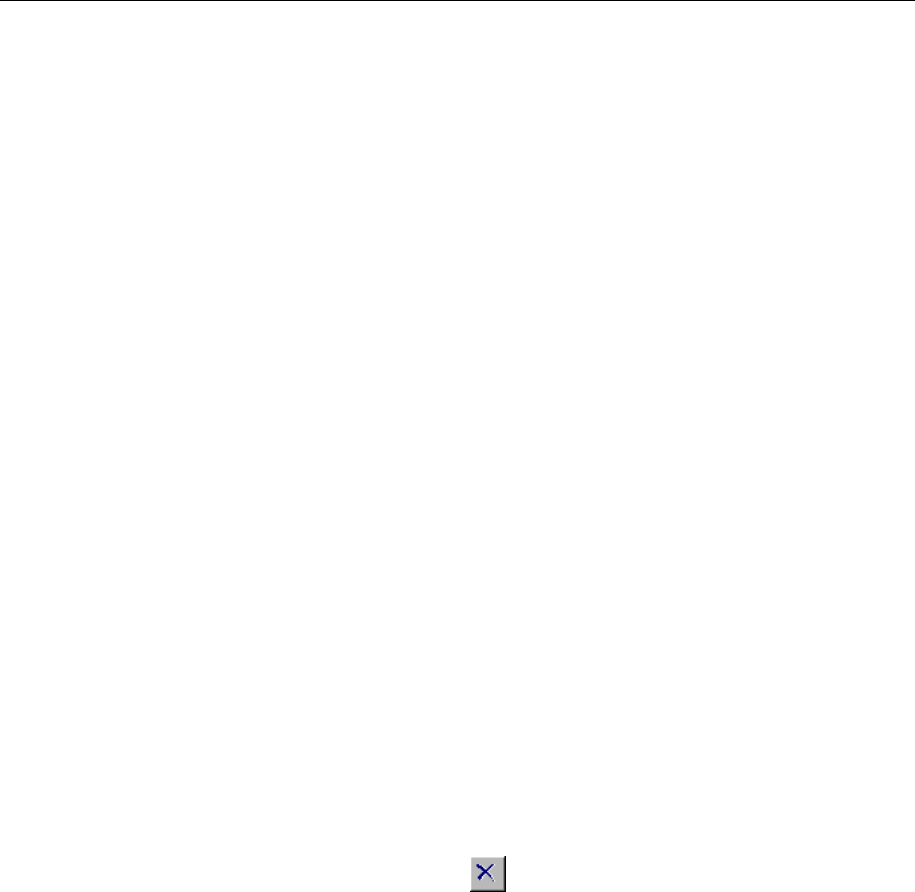
TheaterTouch System Controller
22
BUTTONS
Buttons are the functional elements of the TheaterTouch system controller. Each
button can be associated with commands, macros, and page links. Creating buttons in
the touchscreen grid consists of making the button itself and then adding text,
bitmaps, or symbols to them.
HOW TO ADD BUTTONS
1. Select a page from the Page List, and then the frame on that page with the
frame left and right arrows on the bottom of the touchscreen grid.
2. Select the style of button from the button drawing tools on the left side of
the Tool Palette.
3. Place the mouse cursor over the cell in the touchscreen grid where one
corner of the button will be.
4. Click and hold the left mouse button and drag the mouse to the opposite
corner of where the button will be.
5. Release the left mouse button when the button has the desired shape and
size.
Repeat this procedure for each button you wish to add.
HOW TO DELETE BUTTONS
1. Select the Delete Button tool from the Tool Palette.
2. Place the mouse cursor over the button to delete.
3. Click the left mouse button.
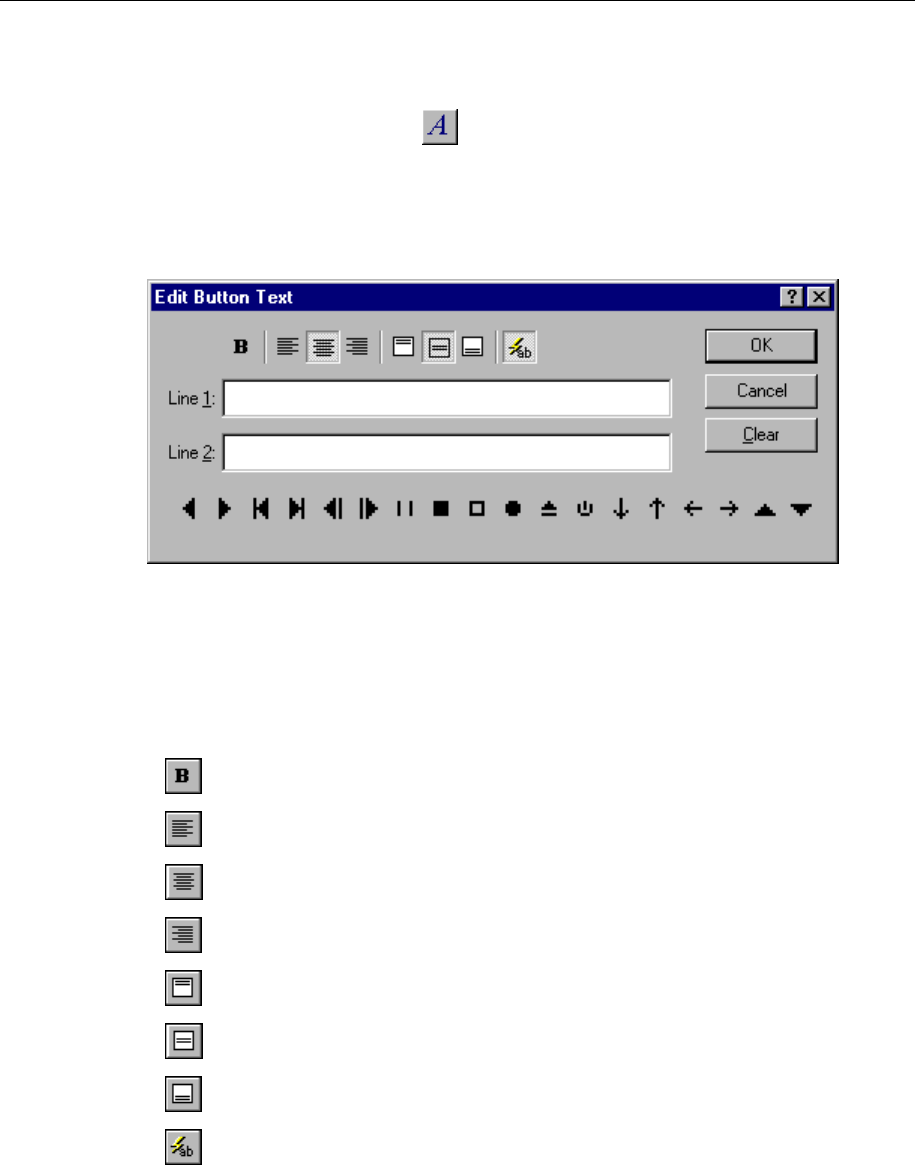
Chapter 4 • TheaterTouch Designer Basics
23
HOW TO ADD TEXT TO BUTTONS
1. Select the Edit Text tool from the Tool Palette.
2. Place the mouse cursor over the button you want to add or edit text on.
3. Click the left mouse button.
4. Enter the text in the Edit Button Text dialog and click OK.
You can use any of the options in the Edit Button Text dialog to customize the
button.
Make the text bold.
Justify the text to left side of the button.
Center the text horizontally in the button.
Justify the text to the right side of the button.
Shift the text to the top of the button.
Center the text vertically in the button.
Shift the text to the bottom of the button.
Enable the auto-complete feature, which will automatically finish typing
the name for commonly used buttons.
Click on any of the symbols at the bottom the dialog box to insert them into the active
line.
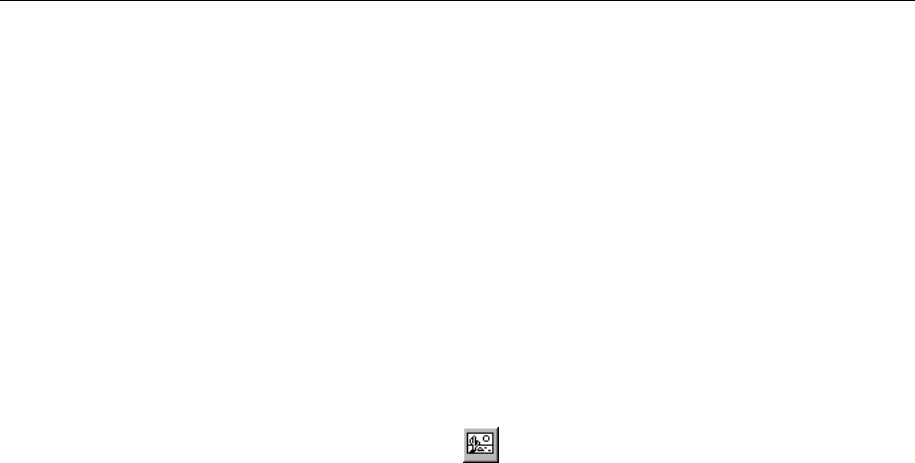
TheaterTouch System Controller
24
HOW TO PLACE A BITMAP
The Bitmap Library window allows you to assign bitmaps to buttons in your file or to
create new bitmap buttons by dragging the bitmaps from the Bitmap Library to the
Touchscreen grid. Hold the mouse over any bitmap in the Bitmap Library window to
see its title and the Bitmap Library it is stored in.
If you drop the bitmap onto an empty section of the Touchscreen grid, a new button
is automatically created with the default style, and the bitmap is placed on that
button.
If you drop the bitmap onto an existing button, any text or bitmap already on that
button is replaced with the bitmap that you drop.
1. Select the Place Bitmap tool on the Tool Palette.
2. When the Bitmap Library window appears, drag any bitmap from the
Bitmap Library onto the Touchscreen grid.
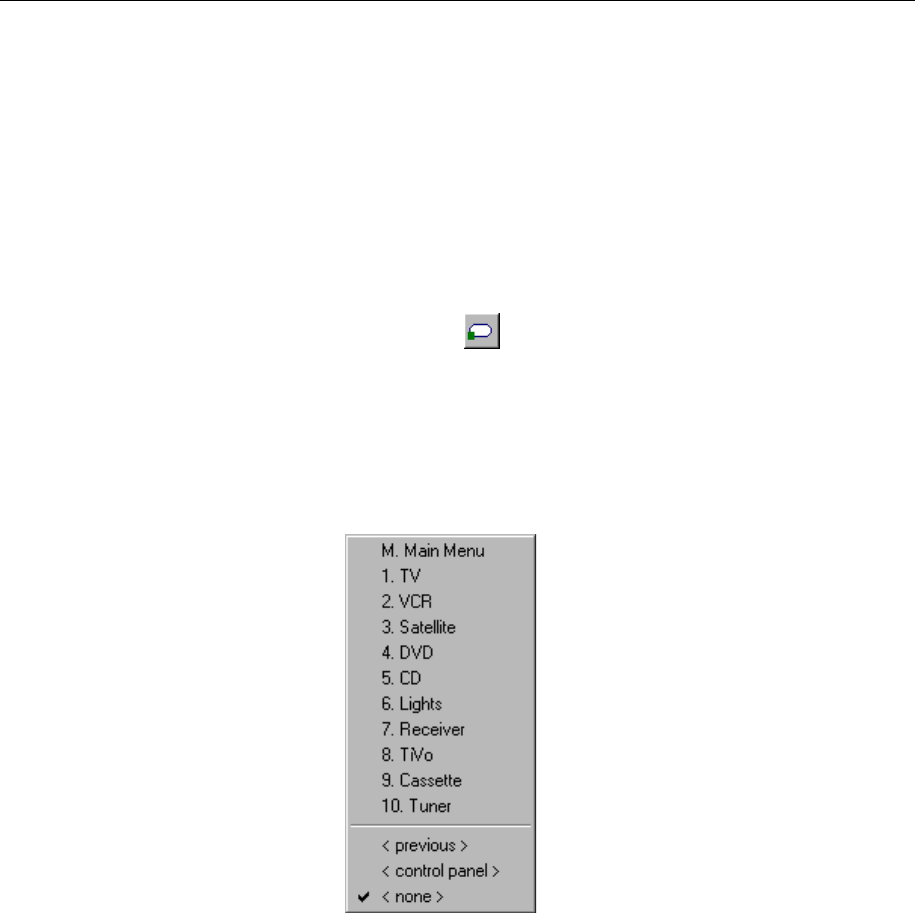
Chapter 4 • TheaterTouch Designer Basics
25
HOW TO LINK PAGES
The TheaterTouch Designer software gives you the ability to link pages. When a button
with a page link is pushed on the TheaterTouch, the linked page becomes active, in
essence turning the page.
Page links are indicated by a small green box containing the number of the linked-to
page in the lower left corner of the button.
1. Select the Assign Pages tool from the Tool Palette.
2. Place the mouse cursor over the button to which you wish to assign a
page.
3. Click the left mouse button.
4. Select the page name you wish to link to from the pop-up menu.
5. Notice the green square in the lower left corner of the button corresponds
to the linked page in the list.
Two additional options are available for linking:
♦ <previous> will take you back to the last page that was displayed.
♦ <control panel> will switch to the built-in Control Panel page.
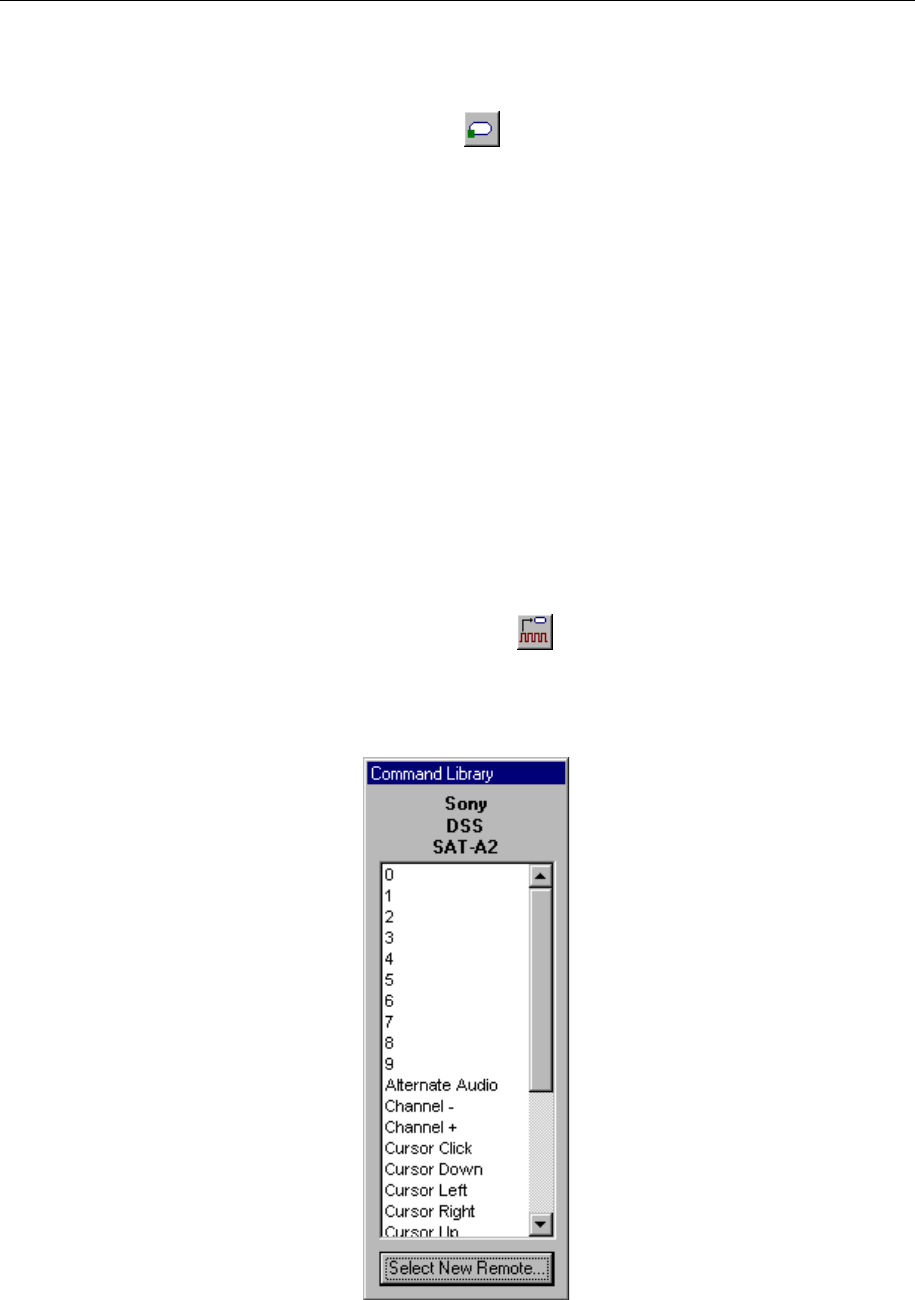
TheaterTouch System Controller
26
HOW TO REMOVE PAGE LINKS
1. Select the Assign Pages tool from the Tool Palette.
2. Place the mouse cursor over the button from which you wish to remove
the page link.
3. Click the left mouse button.
4. Select the <none> item from the bottom of the pop-up menu.
HOW TO ADD COMMANDS TO BUTTONS
IR commands are indicated by a small red box with the letter ‘C’ in the upper right
corner of buttons.
1. Select the Command Library tool from the Tool Palette.
2. Click the Select New Remote button in the Command Library window to
select a different remote than displayed.
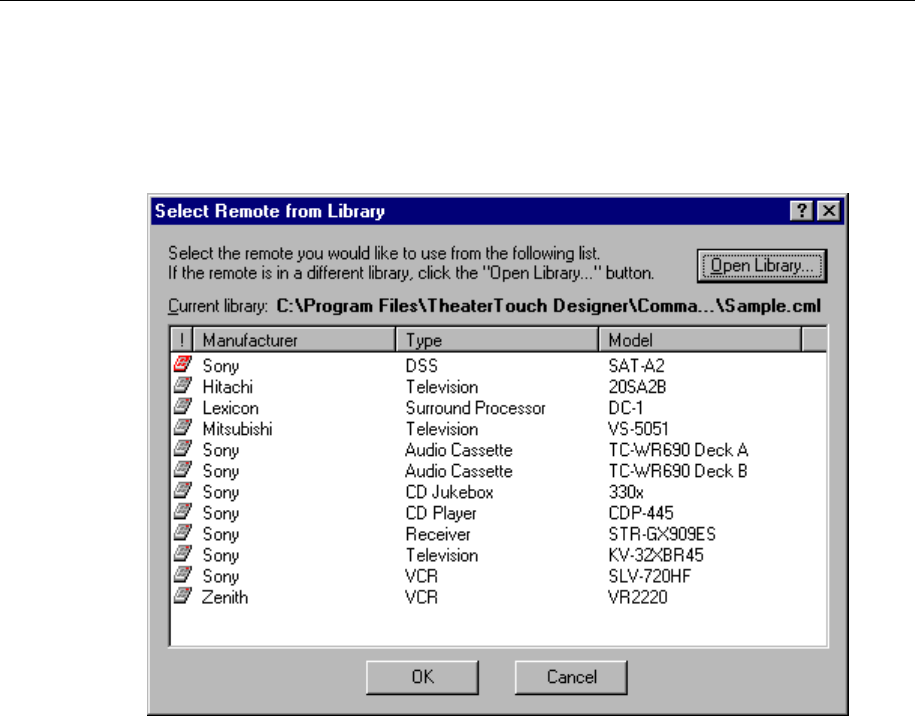
Chapter 4 • TheaterTouch Designer Basics
27
Remotes are listed by manufacturer, type, and model in the Select Remote from
Library window; use this to select the remote you would like to assign codes from.
Remotes that have already been used in the current remote file will be moved to the
top of the list and their icon will turn red for easy identification.
3. If the remote is in a different library or no library is open, click on the
Open Library command button to find the library you are looking for.
4. Click on the remote you would like to assign codes from and the
Command Library will open again.
5. Place the mouse cursor over the function in the Command Library that
you want to assign.
6. Click and hold the left mouse button.
7. Drag the mouse cursor to the button on which you want to place the
command.
8. Release the left mouse button.
If you drag a command to a spot on the touchscreen grid where there are no buttons,
TheaterTouch Designer will automatically create a button and insert the text for that
command.
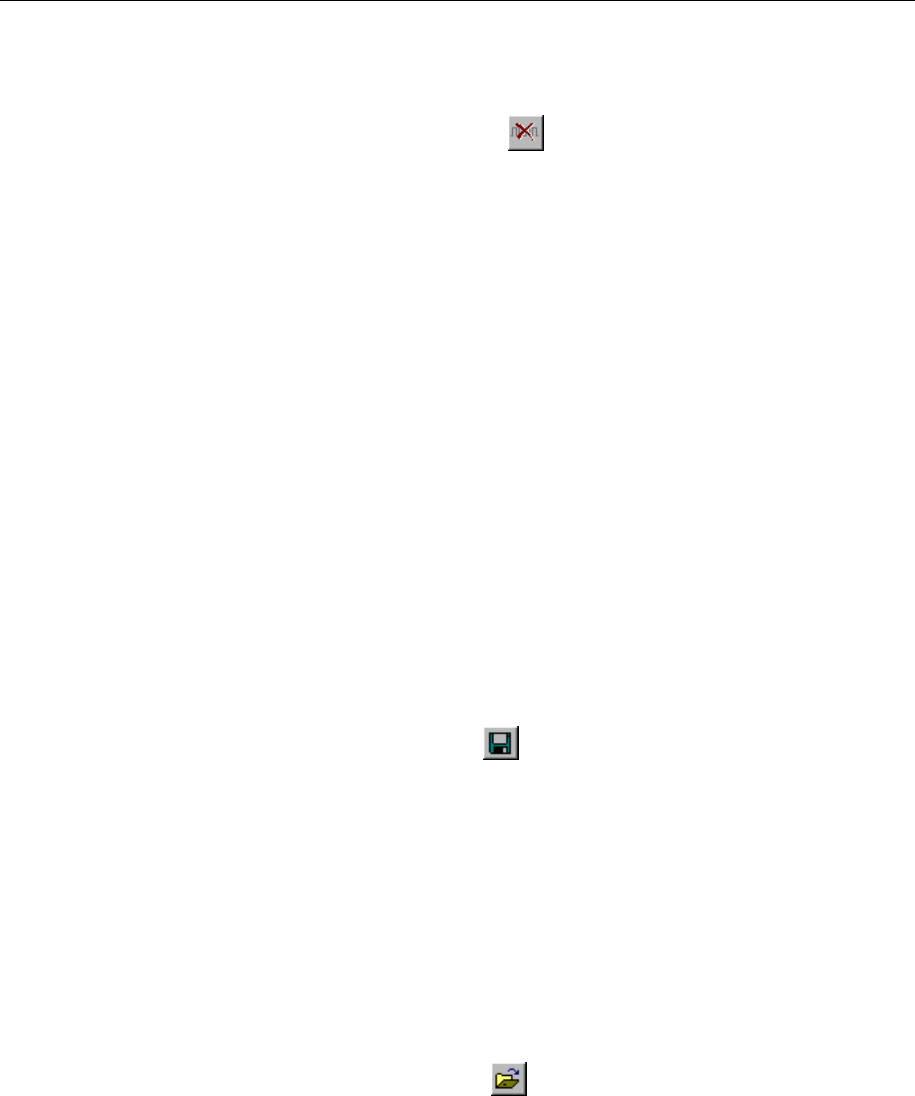
TheaterTouch System Controller
28
HOW TO DELETE COMMANDS FROM BUTTONS
1. Select the Delete Command tool from the Tool Palette.
2. Place the mouse cursor over the button with the command you wish to
delete.
3. Click the left mouse button.
HOW TO SAVE A FILE
The files created with TheaterTouch Designer hold all the elements that make up an
individual remote file. They have the extension .rti and may be stored in any
directory.
Default directory is: [C:\Program Files\TheaterTouch Designer\My Remotes]
Note: If a file already exists on the disk, the current copy is backed up in a file
with the extension .rtb and the new file is saved with the .rti extension.
1. Click the Save File Command on the Toolbar.
2. Specify the name and directory for the file when saving for the first time
and click Save.
HOW TO OPEN AN EXISTING FILE
1. Click the Open File Command from the Toolbar.
2. Click on the file you wish to open.
3. Click Open.
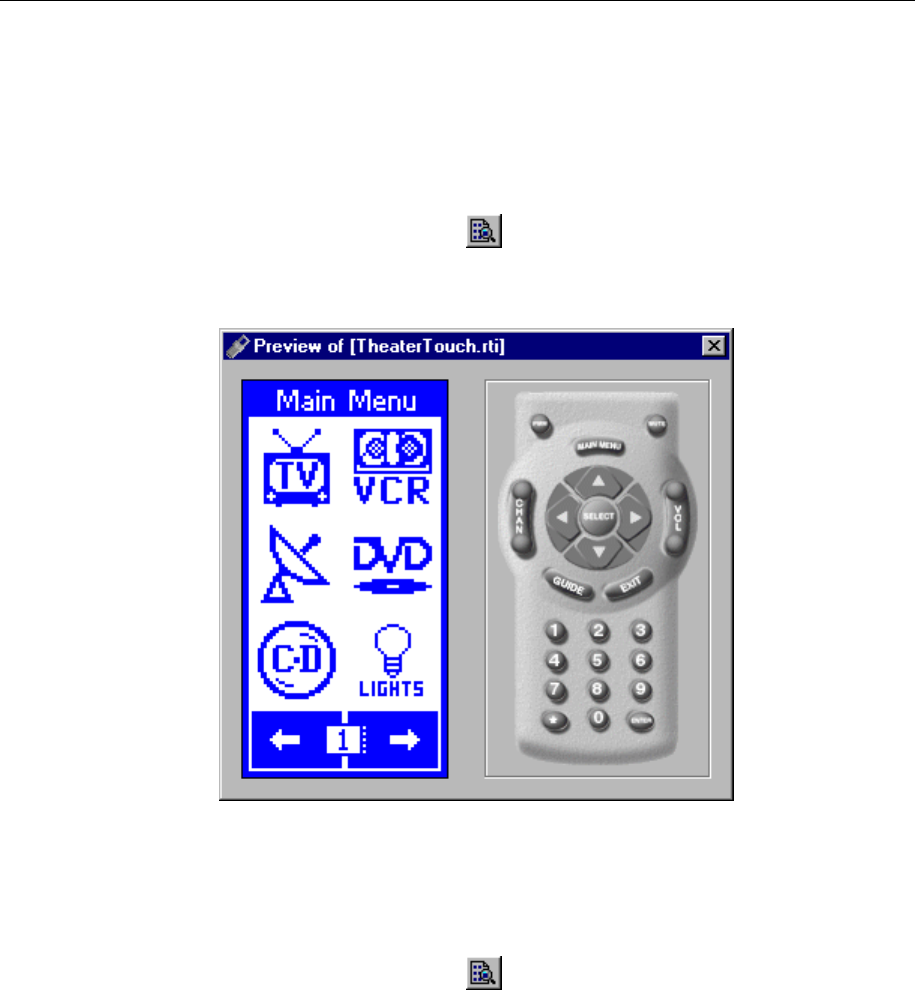
Chapter 4 • TheaterTouch Designer Basics
29
HOW TO PREVIEW YOUR FILE
The Preview mode in TheaterTouch Designer allows you to see exactly what your file
will look like when it is sent to the TheaterTouch remote.
Click the Preview Mode Command from the Toolbar.
Use the mouse to press the buttons in the preview window. The buttons will
push-in just like they would on the TheaterTouch, and if they are linked to another
page, the linked page will become the current page in the Preview Window.
Click the Preview Mode Command from the Toolbar again when you are
finished testing your file.
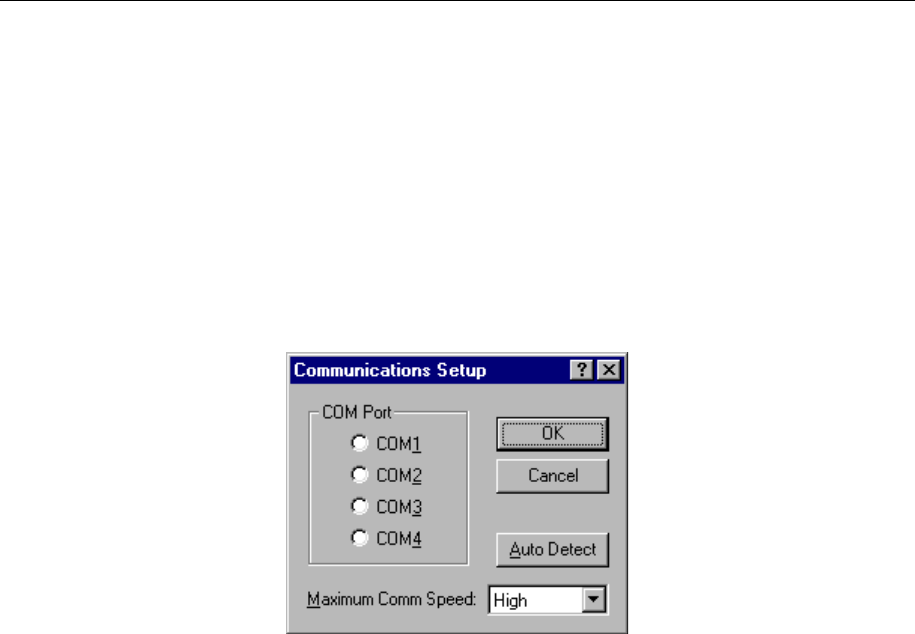
TheaterTouch System Controller
30
HOW TO SETUP COMMUNICATIONS
The Communications Setup dialog box is for setting up communications between the
TheaterTouch and your PC.
To open the Communications Setup dialog box:
Choose Set COM Port from the Options menu.
Com Port group box - Choose the COM Port that the TheaterTouch is connected
to.
Auto Detect - Click this button to have TheaterTouch Designer attempt to
automatically locate the correct COM port. The TheaterTouch must be connected
to the computer with the programming cable and in Computer Link mode.
Maximum Comm Speed - Choose a lower speed from this list if you are having
problems communicating with the TheaterTouch system controller. The default is
High.

Chapter 4 • TheaterTouch Designer Basics
31
HOW TO SEND A FILE TO THE THEATERTOUCH
1. Click the Communications Command on the Toolbar.
2. Choose Send File.
All buttons, commands, bitmaps, and macros are sent. Any existing program in
the TheaterTouch is replaced with the file you send.
All communications take place on the COM port selected with the Set COM Port
command from the Options menu.

TheaterTouch System Controller
32
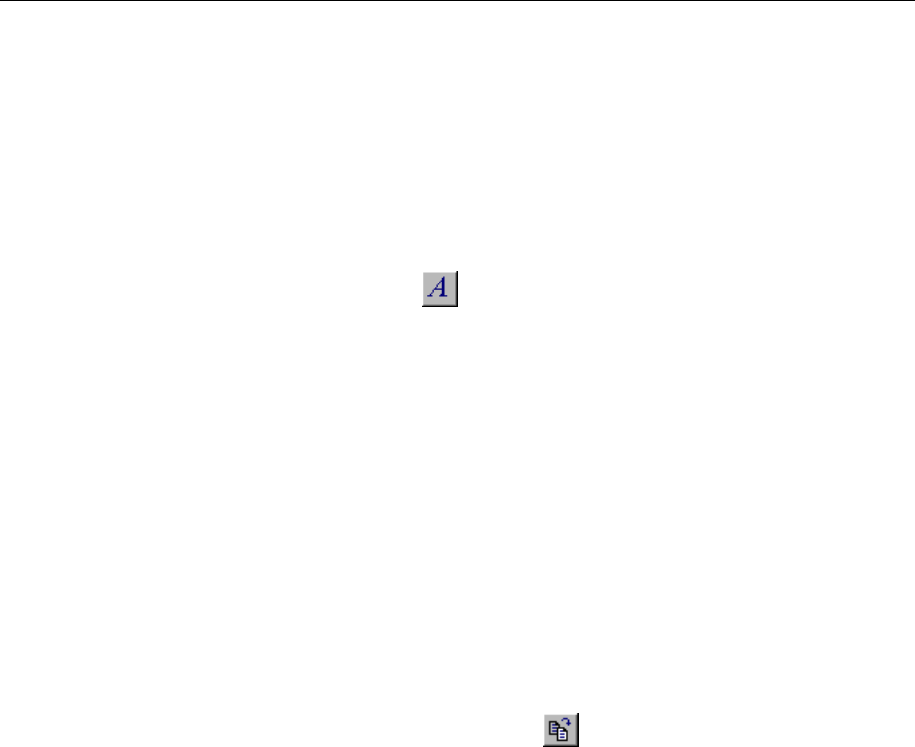
Chapter 5 • TheaterTouch Designer Advanced Features
33
Chapter 5. TheaterTouch Designer Advanced Features
HOW TO RENAME A PAGE
1. Make sure the desired page is displayed in the touchscreen grid.
2. Select the Edit Text tool from the Tool Palette.
3. Place the cursor over the page title area at the top of the touchscreen grid
and click the left mouse button.
4. Specify the new page title and click OK.
HOW TO DUPLICATE A PAGE
Pages can be instantly duplicated. This is useful when pages share common buttons
like channel macros or transport controls. One page can be created with these
buttons and duplicated as many times as needed.
1. Make sure the desired page to be duplicated is displayed in the
touchscreen grid.
2. Click the Duplicate Page Command on the Toolbar.
3. Give the new page a different name and click OK.
The new page appears at the end of the page list.
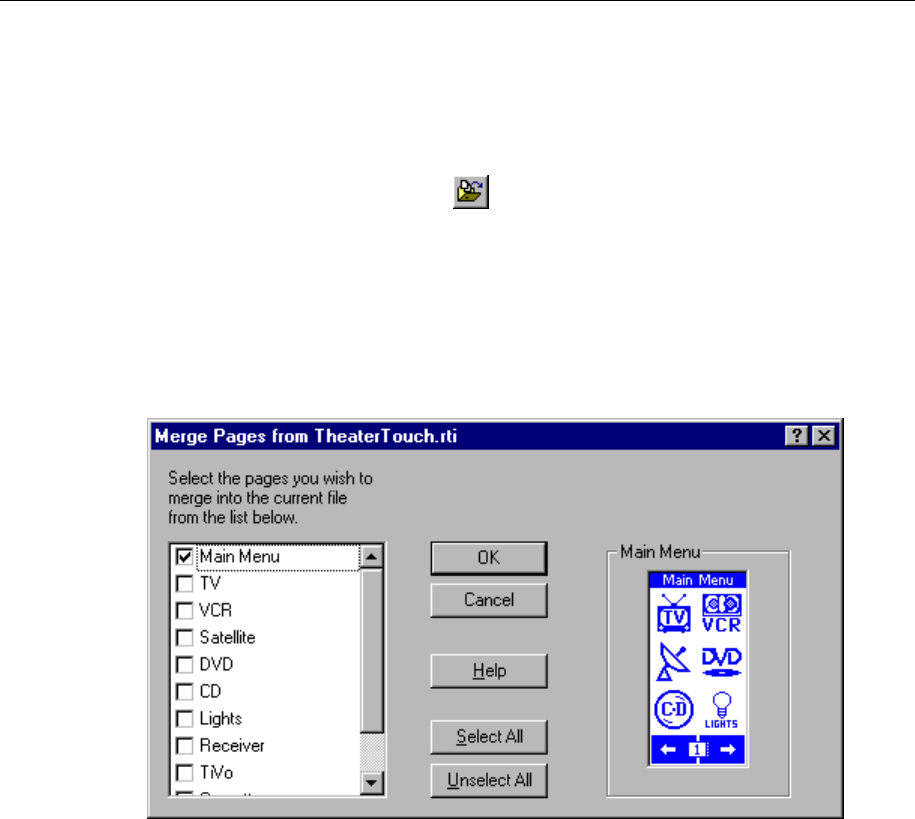
TheaterTouch System Controller
34
HOW TO MERGE PAGES
The Merge Pages dialog makes it possible to move groups of pages from another .rti
file to the current remote file.
1. Click the Merge Pages tool on the Toolbar.
2. Select the remote file from which you wish to merge pages from. Choose
from the list located in the Select file to merge from dialog box and click
Open.
3. Place a check next to each page you would like to merge into the current
file.
4. You can click the frame left and frame right arrows to see the individual
frames on a page.
5. When finished selecting pages, click OK.
All of the marked pages in the list are placed at the end of the current file.
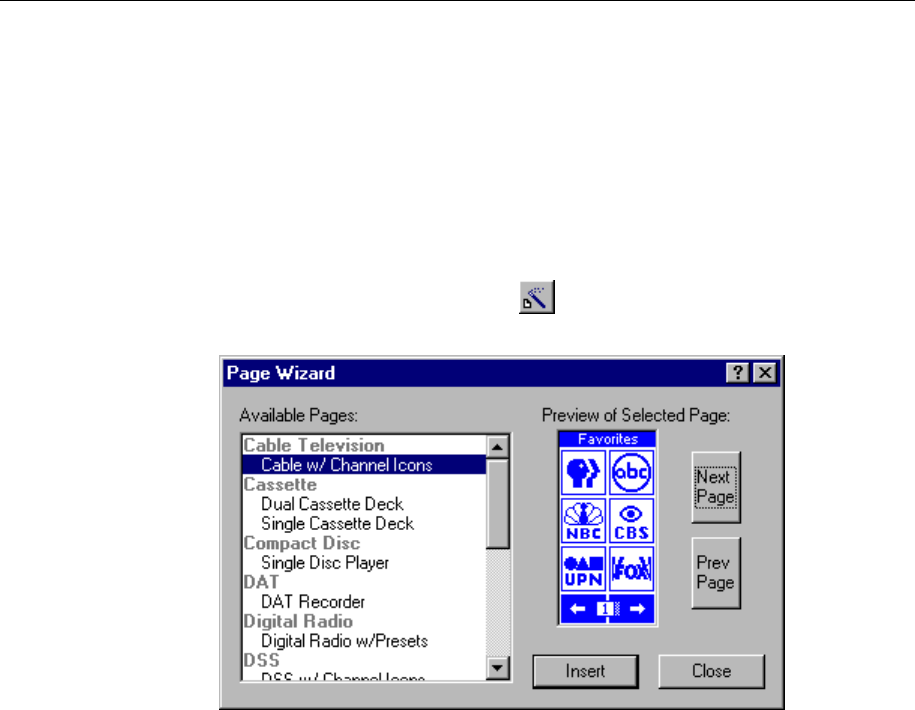
Chapter 5 • TheaterTouch Designer Advanced Features
35
HOW TO USE THE PAGEWIZARD
TheaterTouch Designer comes with a library of pre-built pages for many common types
of equipment that you can insert into your file and customize as desired. The page
library is accessed through the PageWizard tool.
To add a pre-built page to your file:
1. Click the Page Wizard Command on the Toolbar.
2. Scroll through the list of available pages and select the one you want. You
can use the Next Page and Prev Page buttons to see previews of all the
pages if there are more than one.
3. Click the Insert button to add the page(s) to your file.
4. Click the Close button to close the dialog box.
The new page(s) appear at the end of the page list.
Use the editing tools to customize the button style to fit the rest of your file and to
place commands, page links and macros on the buttons.
HOW TO CHANGE BUTTON STYLES
1. Select the style of button from the Tool Palette.
2. Place the mouse cursor over the button you wish to change.
3. Click the left mouse button.
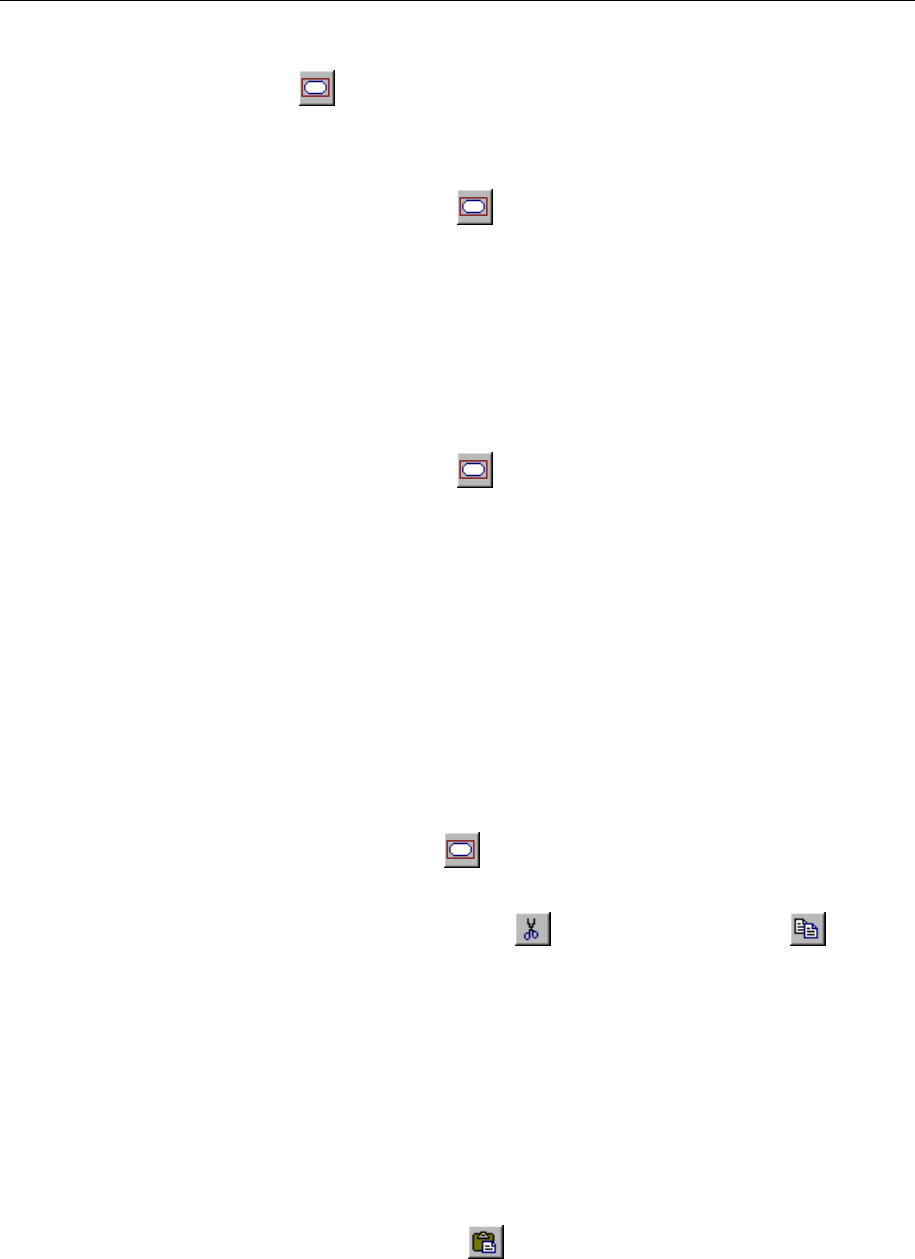
TheaterTouch System Controller
36
HOW TO SELECT BUTTONS
The Select Button tool is used to select buttons for cutting, copying, moving,
resizing, or property editing. When buttons are selected, they are painted in red.
To select a single button or a group of buttons next to each other:
1. Click the Select Button tool on the Tool Palette.
2. Place the mouse over one corner of the button(s) and click the left mouse
button.
3. Draw a rectangle around the buttons you wish to select in the design
window (either in the touchscreen area or the keypad buttons).
To select multiple buttons at one time that are not next to each other:
1. Click the Select Button tool on the Tool Palette.
2. Hold down the Ctrl key on your keyboard.
3. Click the buttons you wish to select (either in the touchscreen area or the
keypad buttons).
Note: Many TheaterTouch Designer commands can be used on selections as well as
individual buttons. Click the right mouse button on a selection for a list of available
commands.
HOW TO CUT OR COPY BUTTONS
1. Use the Select Button tool from the Tool Palette to select the
button(s).
2. Choose either the Cut Command or the Copy Command from
the toolbar.
3. The button(s) are now on the clipboard.
HOW TO PASTE BUTTONS
1. Select the page you want to paste the button(s) on from the page list.
2. Choose the Paste Command from the Toolbar.
3. Drag the button(s) to the proper place on the page.

Chapter 5 • TheaterTouch Designer Advanced Features
37
HOW TO MOVE A BUTTON
1. Use the Select Button tool from the Tool Palette, to select the
button(s).
2. Hold down the left mouse button to drag the selection to a new location.
3. Release the left mouse button to place the buttons.
HOW TO RESIZE A BUTTON
Existing buttons on the touchscreen grid may be re-sized using TheaterTouch Designer.
The text on a button may be clipped if the size is reduced, but any associated
command or macro will not be lost.
1. Use the Select Button tool from the Tool Palette to select the button.
Note that to resize a button, only one button can be selected. If the
selection can be resized, small boxes will appear in the red border on all
four sides.
2. Position the mouse over the edge of the button that you would like to
resize.
3. Click the left mouse button.
4. Drag the mouse to change the size.
5. Release the mouse button when you have the desired size.
HOW TO PLACE A CUSTOM BUTTON
The Custom Button Library Browser allows you to select and place Custom Buttons
onto the Touchscreen grid.
1. Select the Place Custom Button tool from the Tool Palette.
2. Select the library in which the custom button you want is located by
clicking the Open Library button, selecting the library and clicking Open.
Default directory is: [C:\Program Files\TheaterTouch Designer\Custom Buttons]
3. Click on a button name and a preview of the button will appear in the
Custom Button Library Browser.
4. Click OK to insert the custom button on the Touchscreen grid and close
the Custom Button Library Browser.
5. Drag the custom button to the proper place on the page.
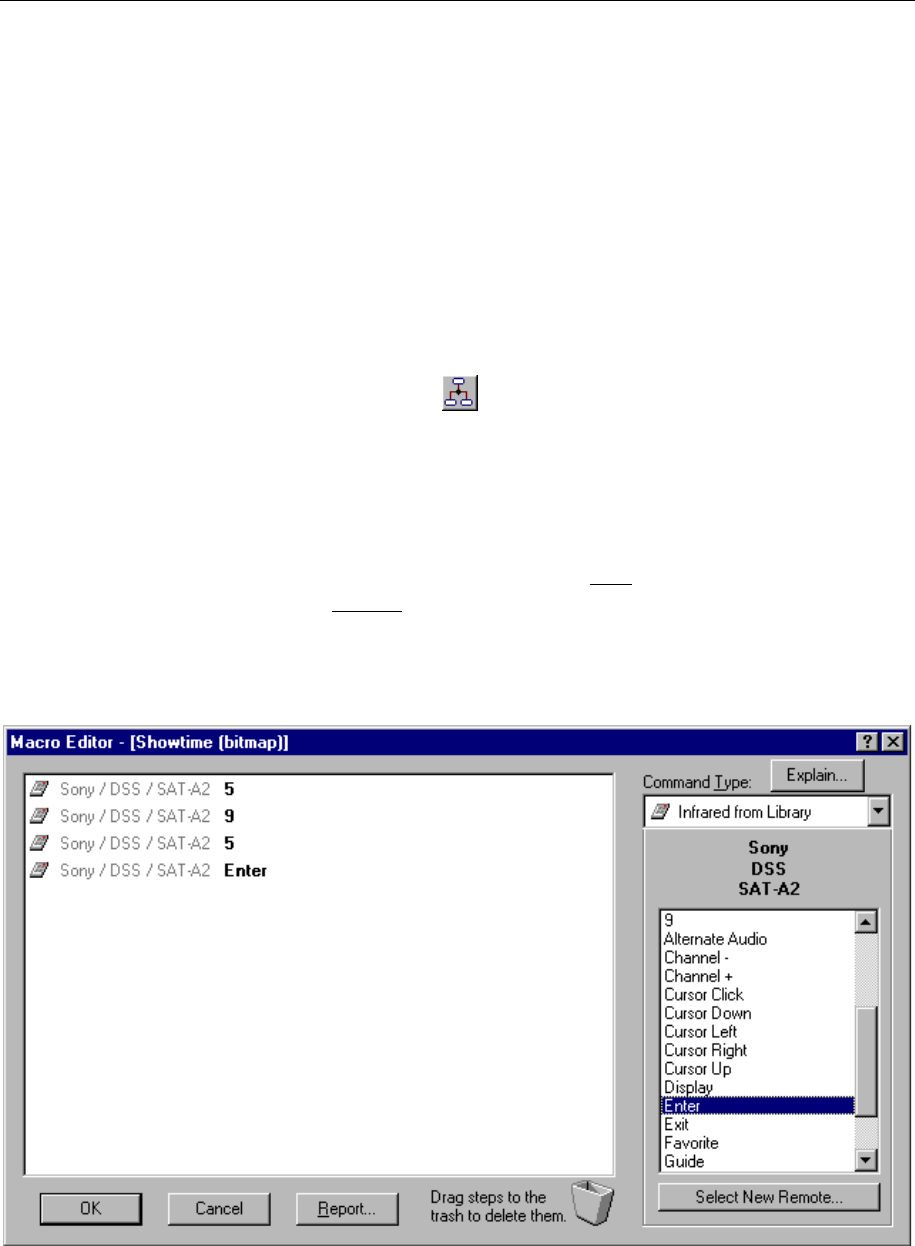
TheaterTouch System Controller
38
HOW TO USE THE MACRO EDITOR
Macros are a sequence of commands placed on any single button. Macros are placed
by using the Edit Macro application found on the Tool Palette.
Buttons with macros can be moved, cut, copied, and pasted to other pages without
discarding the codes attached to them.
Macros are indicated by a small black box with the letter ‘M’ in the upper left corner
of buttons.
EDITING MACROS
To add a new macro or edit an existing macro on a button:
1. Select the Edit Macro tool from the Tool Palette.
2. Click the button to which you would like to add a new macro or edit an
existing macro.
3. Use the tools in the Macro Editor window to add, insert, and delete
commands.
4. Click OK in the Macro Editor window to save changes to the macro, or
click Cancel to discard them.
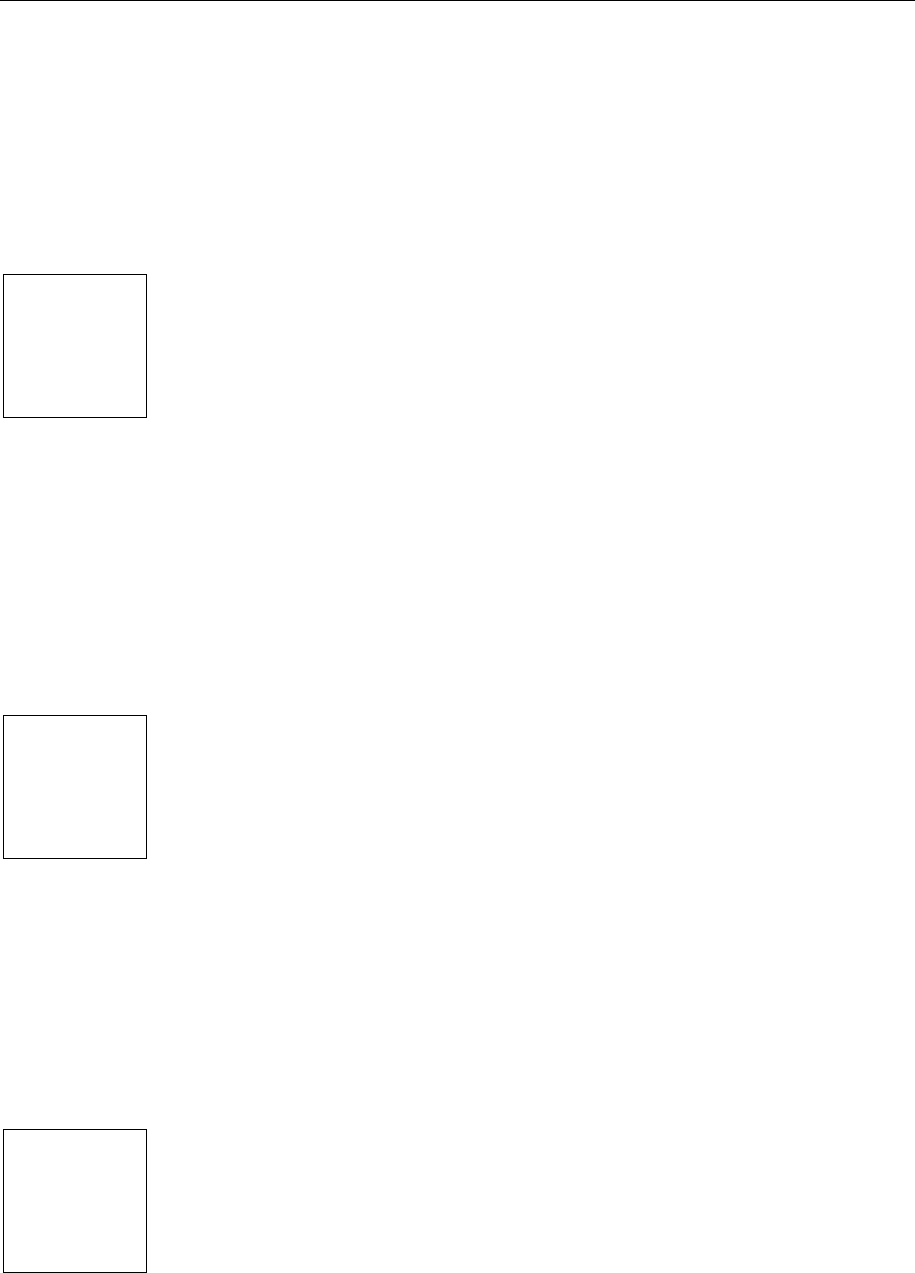
Chapter 5 • TheaterTouch Designer Advanced Features
39
Report command – The Report command button at the bottom of the macro editor
opens up your default web browser for viewing and printing of the open macro.
Trash Can – The Trash Can located at the bottom of the macro editor is used to
delete commands from a macro. Left click and hold the command you want to delete
and drag it to the Trash Can and release.
The Infrared from Library macro step type causes the macro to
output an Infrared command. Any number of Infrared commands can be added to
the macro by selecting the proper library and then dragging the desired function(s)
from the list on the right side to the macro display on the left side of the Macro
Editor.
If you do not have access to the Command Library with the desired function, but it is
assigned to a button in the current file, use the Infrared from Page step type to add it
to the macro.
The Infrared from Page macro step type causes the macro to
output an Infrared command. The command is taken from a button in the current
file. Select the page containing the desired code, and then drag the code from the
Available Buttons list on the right to the macro display on the left.
This should be used for maintaining files for which the Command Library is not
available. If the desired command is in a Command Library, use the Infrared from
Library step type.
The Time Delay step causes the macro to pause for the time
specified by the Delay Time spin box. The time can be adjusted from 0.1 to 9.9
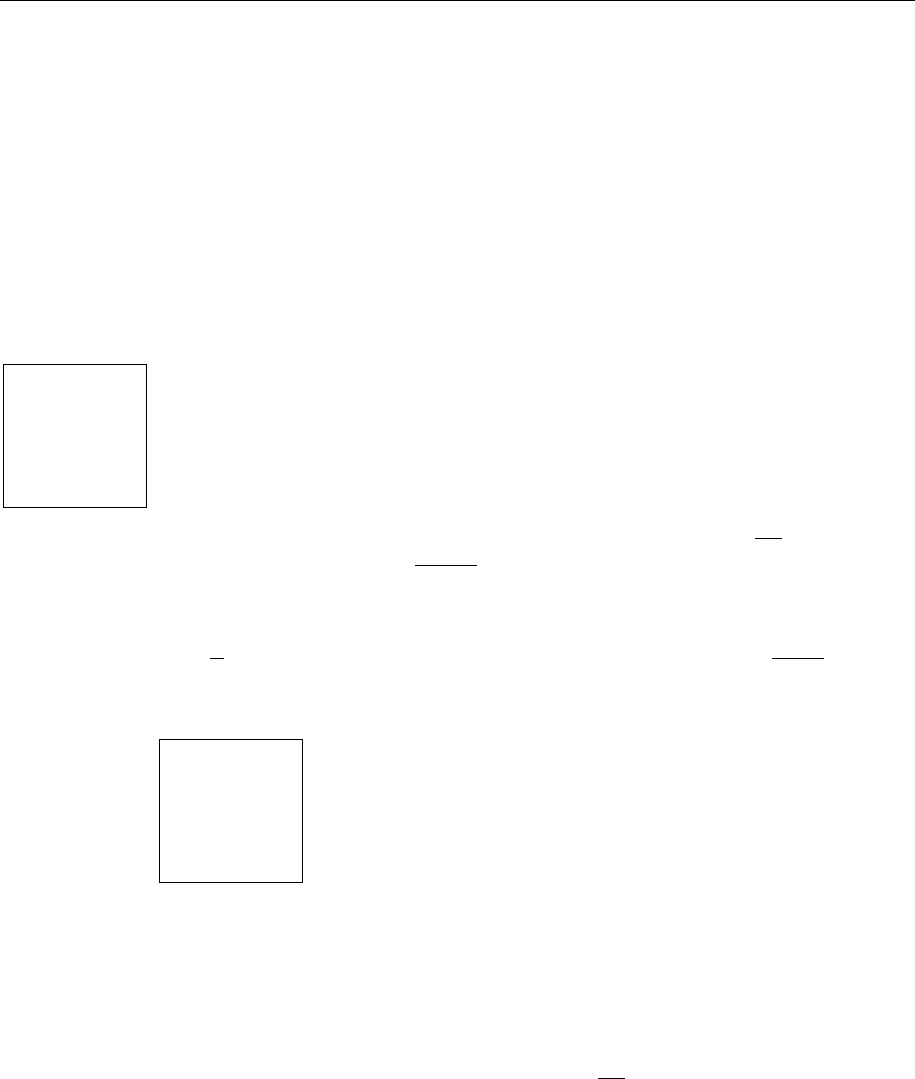
TheaterTouch System Controller
40
seconds. After you have set your desired delay time, drag the Time Delay icon from
the right to the macro display on the left.
Release the mouse button at the location where you would like to add the time delay
step.
The Button Test step causes the macro to execute the following
steps ONLY IF the button that the macro is attached to is Held Down for a specified
amount of time or Double-Clicked within a specified amount of time, depending on
the option selected.
The Button Test steps are conditional statements or “Else” commands meaning that if
the condition is met the first command will be sent and if the condition is not met the
second command will be sent.
Held Down - In the example above, if the button is held down for 0.3 seconds, the
ON command will execute. If the button is not held down for 0.3 seconds, the
command will not execute.
This can be used to make a source button that switches pages if pressed briefly, or
switches pages and turns equipment on if held down for the specified amount of
time. This can also be used to send a command when pressed briefly, or send a
different command when held down.

Chapter 5 • TheaterTouch Designer Advanced Features
41
Double-Clicked – In the example above, if the button is double-clicked within 0.3
seconds, the ON command will execute. If the button is not double-clicked within 0.3
seconds, the command will not execute.
This can be used to make a source button that switches pages if pressed once, or
switches pages and turns equipment on if double-clicked within the specified amount
of time. This can also be used to send a command when pressed once, or send a
different command when double-clicked.
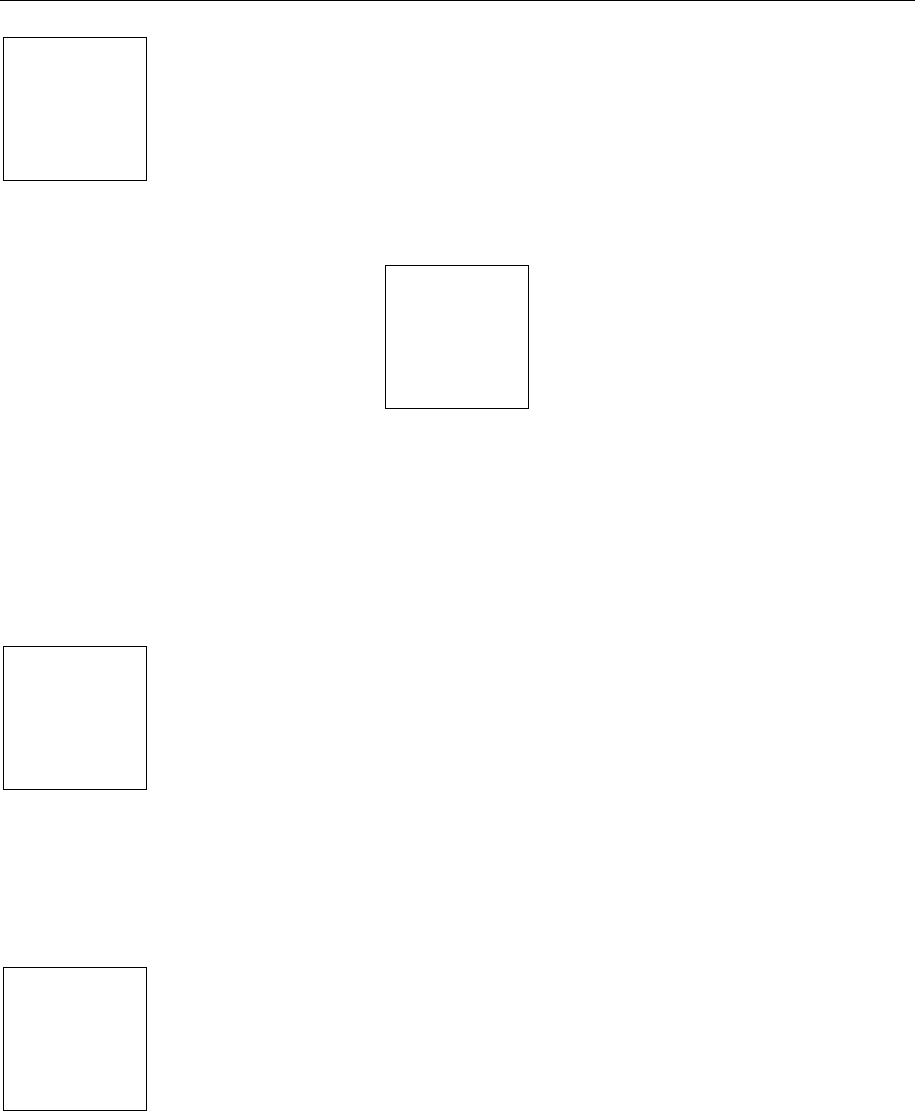
TheaterTouch System Controller
42
Button Pause – The Button Pause step causes the macro to stop
executing until the button it is attached to is released.
In the example above, if you press and hold the button that the macro is attached to,
the macro will execute the first command and pause until the button is released, then
execute the rest of the commands in the macro. This works well for commands like
Scan on some VCR’s and DVD players, which you need to send the play command to
stop the scan function.
Stop Macro - The Stop Macro step causes the macro to stop
executing at the point where it is inserted.
Macros automatically stop when they reach the end, so you should not normally
need to insert a Stop Macro step. It is intended for use in conjunction with the
Button Test step, where you can have the macro stop if a condition is met.
Toggle IR Code - The Toggle IR Code step causes the macro to
alternate between two different IR codes every other time the button is pressed.

Chapter 5 • TheaterTouch Designer Advanced Features
43
In the example above, each time the button that the macro is attached to is pressed,
the commands alternate. The initial button press executes the A command and the
second button press executes the B command.
If you have equipment that uses toggle codes, you must learn each code twice, and
then place the two codes within the Toggle IR Code step. Every time the macro is
run, it will send out only one of the two codes inside of the Toggle IR Code step,
switching back and forth each time the button is pressed.
The Toggle IR Code command is an advanced feature. If you have trouble with this
feature, contact Technical Support for help.
HOW TO DELETE A MACRO
To delete a macro from a button:
1. Select the Delete Macro tool from the Tool Palette.
2. Place the mouse cursor over the button with the macro you wish to delete.
3. Click the left mouse button.

TheaterTouch System Controller
44
HOW TO EDIT AN IR COMMAND IN A MACRO
1. To edit an individual command in a macro you must have the macro
displayed in the Macro Editor.
2. Double click on the command in the macro you want to edit to open the
Edit Infrared Command dialog box.
Note: Not all of the controls will be available simultaneously. Only the options
relevant to the default settings and command being edited will be shown.
The Edit Infrared Command options are:
Minimum Repeats - Enter in this box the number of times that the repeating
part of the IR code is sent by the remote. Some infrared receivers need a
command to be repeated a certain number of times to work properly, and
some may not work properly if the command is repeated at all. Even if a
command works properly, increasing the number of repeat times may be
necessary if the command is to be used in a macro. Since macro commands
are not automatically sustained while a button is pressed, they may need to
automatically repeat more times to be recognized.
Frequency – Shown in this box is the carrier frequency of the IR code, this is
set automatically. You should not need to change this value unless directed to
do so by Technical Support.
Repeat while button is pressed - Check this box to cause this IR code to be
repeated for as long as the button is held down.
Note: Only one command in any macro can have this property set.
Output Type:
Unless the system contains a mixture of direct IR and IRF-6/RF commands,
this option will not normally need to be changed.

Chapter 5 • TheaterTouch Designer Advanced Features
45
Default - Check this option to set the default output type for this
command to the button default. The button default is the option
selected on the Output tab of the Edit Button Properties command.
IR - Check this box to force this command to transmit IR directly out
the infrared window on the front of the remote, regardless of the
system setting.
RF - Check this box to force this command button to transmit IR via RF
through the IRF-6, regardless of the system setting.
RF ID Code:
Unless the system contains more than one IRF-6, this option will not normally
need to be changed.
Default - Check this option to set the default RF ID code for this
command to the button default. The button default is the ID code
selected on the Output tab of the Edit Button Properties command.
Code - Check this option and enter an ID Code in the box to force this
command to transmit a specific RF ID code when in RF mode,
regardless of the system default setting.

TheaterTouch System Controller
46
IR Outputs group box:
Check the box(s) that corresponds with the output(s) you wish to send
the command(s) on this button out of the IRF-6. Note that the labels
for the output can be changed with the Edit Remote Properties
command on the Edit menu.
The default is to have the command(s) come out of all of the outputs
on the IRF-6. This option will not normally need to be changed unless
you have multiple identical components or are using one of the power
sensor modules.
Send this code group box:
The options in this section require that a power sensor module be
plugged into the appropriate port on the IRF-6.
Always - Check this option to send the IR code regardless of the
power sensor state. This option should also be checked if no power
sensor is connected to the selected IR output.
Only when device is ON - Check this option to send the IR code only
if the power sensor in the specified port detects that the equipment it
is monitoring is ON.
Only when device is OFF - Check this option to send the IR code only
if the power sensor in the specified port detects that the equipment it
is monitoring is OFF.
Note: In order to use the power sensor options, exactly one IR output
must be selected in the IRF-6 IR Outputs box, and the power sensor
must be plugged into that IR output port.

Chapter 5 • TheaterTouch Designer Advanced Features
47
HOW TO USE THE CHANNEL MACRO WIZARD
TheaterTouch Designer comes with a feature called the Channel Macro Wizard. The
Channel Macro Wizard allows you to quickly and easily create macros for satellite
and cable channel presets.
To start using the Channel Macro Wizard:
1. Select Channel Macro Wizard from the Edit menu.
2. Click the Select New Remote button to select the remote that you will use
to enter to enter the channel numbers and click the Next >> button.
3. You have the option of adding commands before and/or after each macro
for things such as an IR router before each command or an Enter
command after.

TheaterTouch System Controller
48
4. Click the Add/Edit in the BEFORE or AFTER section if choose to add
commands. This will open the Macro Editor where you can select the
commands using the Marco Editor commands. If you need help with
these commands, see the “How to Use the Macro Editor” section.
5. Click the Next >> command button.
6. Select the page you wish to place macros on from the Page drop-down list
and then select the frame by clicking on the Left and Right frame arrows.

Chapter 5 • TheaterTouch Designer Advanced Features
49
7. Select the number of digits in the channel macro from the Spin box in the
lower right corner. If you enter more digits than selected the numbers will
wrap around.
8. Click the first button from the touchscreen grid on which you want to
place a macro.
9. Enter the channel numbers by either clicking the numbers in the Channel
Macro Wizard with the mouse or you can enter them with the numbers
on the keyboard.
10. Click Save after you enter each macro.
Click Close when finished with all your channel macros.
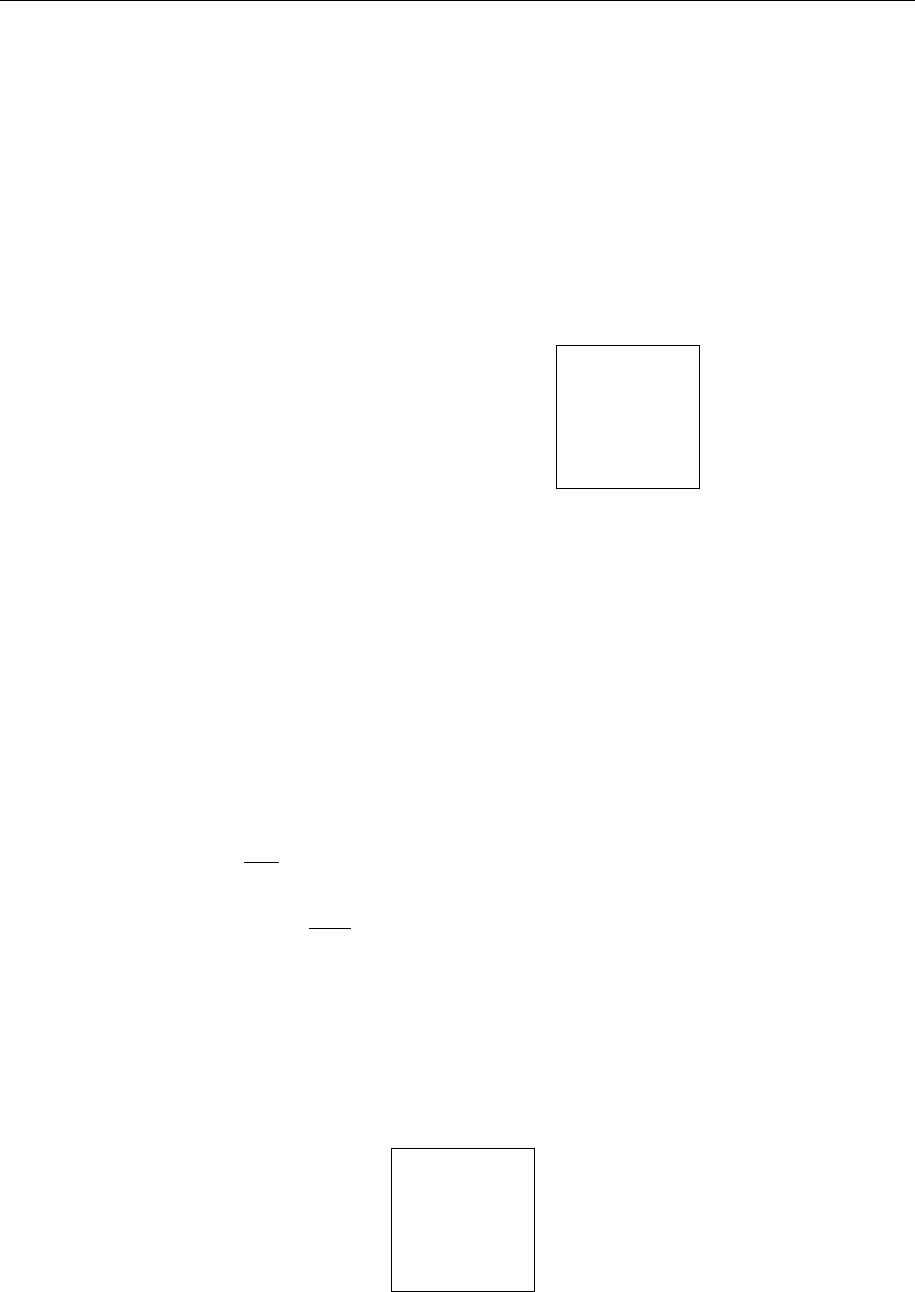
TheaterTouch System Controller
50
HOW TO EDIT THE REMOTE PROPERTIES
The Remote Properties dialog box allows you to change settings that affect the entire
remote.
To open the Remote Properties dialog box:
Choose Edit Remote Properties from the Edit menu.
POWER TAB
The Power tab options are:
Power Down Time: This allows you to adjust the to time the unit stays awake
after the last button press. The time is variable from 1 second to 60 seconds
(default is 10 seconds). During sleep mode, the TheaterTouch uses virtually no
battery power.
Display Mode: The option buttons allows you to adjust the settings of the display
and keypad backlight.
The options are:
1. Any keypress (default), which turns the display and button backlight on
when any button is pressed.
2. Touchscreen or backlight key, which turns the display and button
backlight on only when the touchscreen or backlight key is pressed. This
allows the volume/channel/etc. keys to be used without turning on the
display and backlight each time.
Tilt Switch: (default is: active) The Tilt Switch check box allows you to turn the
tilt switch on or off. When the box is checked, it means the tilt switch is active and
will turn on the display and button backlight when picked up.
MISC. TAB

Chapter 5 • TheaterTouch Designer Advanced Features
51
The Misc. tab options are:
Enable Beeper: Check the box to enable the beeper. If this box is checked, the
TheaterTouch will beep every time a button is pressed.
Scroll Rate: Slide this control to set how fast the frames scroll left and right when
the frame scroll arrows are pressed.
SECURITY TAB
The Security tab options are:
Passcode: (default is 0000) That allows you to set the passcode that is needed to
limit access to the Computer Link mode, the Clear All function on the control
panel page as well as the Button Lockout function that is available on all buttons.
Enable Programming Lockout: Check this box to require that the passcode be
entered before the TheaterTouch will go into Computer Link mode. This can be
used to prevent unauthorized modifications to the TheaterTouch programming.
OUTPUT TAB
The Output tab options are:
Default Output Type:
1. IR – (default) Check this option to set the remote's default output to IR.
Every key on the remote will output IR signals directly out the window on
the front of the remote unless the button properties for the individual
button are set to output RF.
2. RF - Check this option to set the remote's default output to RF. Every key
on the remote will output IR signals via RF to the IRF-6 unless the button
properties for the individual button are set to output IR directly.

TheaterTouch System Controller
52
Default RF ID Code: Use this to set the default RF ID code. This RF ID code will
be used for all RF buttons unless it is set differently in the properties for each
button. The ID code switch on the back of the IRF-6 must also be set to this
setting.
IRF-6 TAB
The IRF-6 tab lets you label the outputs of the IRF-6. Use the pull down list to choose
the IRF-6 ID code for which you wish to modify the labels. You can modify the labels
of all ten possible IRF-6 ID codes independently. The labels are optional and are only
used to make it easier for you to remember what equipment is plugged into each IRF-
6 output.
Send - Click this button to send the current settings directly to the remote.

Chapter 5 • TheaterTouch Designer Advanced Features
53
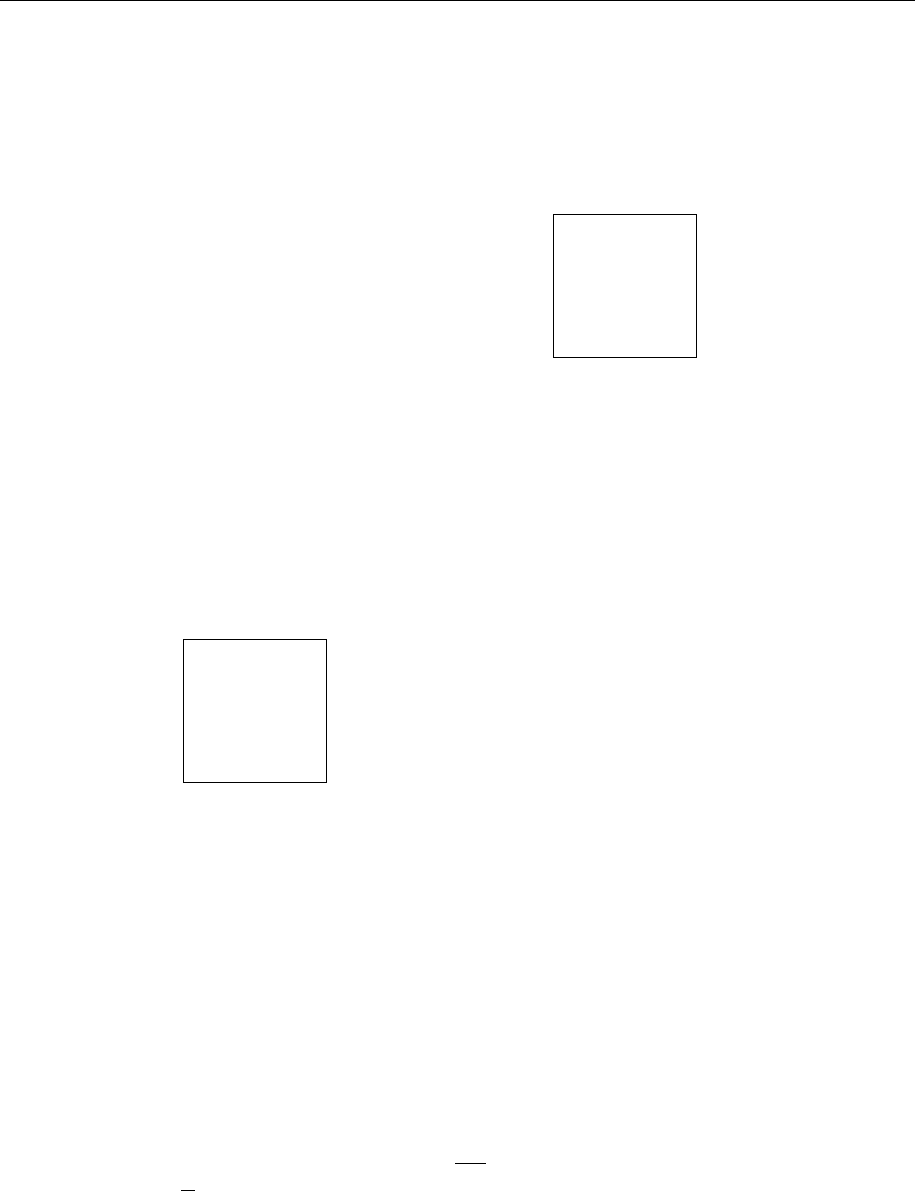
TheaterTouch System Controller
54
HOW TO EDIT BUTTON PROPERTIES
The Edit Button Properties dialog allows you to edit many different attributes of a
button or a group of buttons.
To open the Edit Button Properties dialog box:
1. Select the Edit Button Properties tool from the Tool
Palette.
2. Click the button you want to edit, either touchscreen or keypad buttons
Note: Not all of the tabs and/or controls will be available simultaneously. Only the
options relevant to the button being edited will be shown.
GENERAL TAB
The options on the General tab are:
Disabled - Check this box to prevent the button from responding (beeping or
reversing/pushing in) when it is touched.
Note: Disabled buttons can still have commands, macros and page links. The
disabled property refers only to the appearance of the button, not the
functionality.
Reversed - Check this box to cause the button to be displayed in a reversed or
pushed-in state when the button is not pushed and the normal state when the
button is pushed. The reversed state is: filled in for Rectangular, Radius, Oblong
and Borderless buttons; and Down for Custom Buttons.
Note: This property does not apply to 3D buttons.

Chapter 5 • TheaterTouch Designer Advanced Features
55
Secured - Check this box to require that the security code be entered before the
action (command, macro, or page link) associated with this button is run. The
security code is set with the Edit Remote Properties command on the Edit menu.
Special Functions group box
None - Check this option to cause this button to have no special function.
Power Down - Check this option to cause the remote to power down
immediately when this button is pressed, instead of waiting for the timer to
time out.
Contrast Up - Check this option to cause this button to increase the display
contrast when it is pressed.
Contrast Down - Check this option to cause this button to decrease the
display contrast when it is pressed.
Pause - Enter in this box the number of seconds for the remote to pause after the
button is released. This value will not usually need to be changed from 0.

TheaterTouch System Controller
56
OUTPUT TAB
The options on the Output tab are:
Output Type:
Unless the system contains a mixture of direct IR and IRF-6/RF commands, this
option will not normally need to be changed.
Default - Select this option to set the default output type for this button to the
system default. The system default is the option selected with the Edit
Remote Properties command on the Edit menu.
IR - Select this option to force this button to transmit IR directly out the
infrared window on the front of the remote, regardless of the system setting.
RF - Select this option to force this button to transmit IR via RF through the
IRF-6, regardless of the system setting.
RF ID Code:
Unless the system contains more than one IRF-6, this option will not normally
need to be changed.
Default - Select this option to set the default RF ID code for this button to the
system default. The system default is the ID code selected with the Edit
Remote Properties command on the Edit menu.
Code - Select this option to force this button to transmit a specific RF ID code
when in RF mode, regardless of the system default setting.
System Defaults - This section shows the global defaults for the output type and RF
ID code, for reference. If you wish to change these values, use the Edit Remote
Properties command on the Edit menu.

Chapter 5 • TheaterTouch Designer Advanced Features
57
IRF-6 TAB
The IRF-6 tab options are:
IR Outputs group box:
Check the box(s) that corresponds with the output(s) you wish to send the
commands on this button out of the IRF-6. Note that the labels for the output
can be changed with the Edit Remote Properties command on the Edit menu.
The default is to have the commands come out of all of the outputs on the
IRF-6. This option will not normally need to be changed unless you have
multiple identical components or are using one of the power sensor modules.
Send this code group box:
The options in this section require that a power sensor module be plugged into
the appropriate port on the IRF-6.
Always - Check this option to send the IR code regardless of the power
sensor state. This option should also be checked if no power sensor is
connected to the selected IR output.
Only when device is ON - Check this option to send the IR code only if the
power sensor in the specified port detects that the equipment it is monitoring
is ON.
Only when device is OFF - Check this option to send the IR code only if the
power sensor in the specified port detects that the equipment it is monitoring
is OFF.
Note: In order to use the power sensor options, exactly one IR output
must be selected in the IRF-6 Output box, and the power sensor must be
plugged into that IR output port.

TheaterTouch System Controller
58
INFRARED TAB
The Infrared tab options are:
Min. Repeats - Enter in this box the number of times that the repeating part of
the IR code is sent by the remote. Some infrared receivers need a command to be
repeated a certain number of times to work properly, and some may not work
properly if the command is repeated at all. Change this setting only if you are
having trouble with a command.
Frequency - This box shows the carrier frequency of the IR code. This is set
automatically. You should not need to change this value unless directed to do so
by Technical Support.
Sustain - Check this box to control whether or not the IR code should repeat if
the button is held down. Most infrared codes will transmit continuously as long
as the button is held down, but some infrared receivers may not work properly if
the command is repeated at all. If the Sustain button is checked, the code will be
transmitted for as long as the button is held down, or the Minimum Repeat times,
whichever is greater. If the Sustain button is not checked, the code will be
transmitted only the Minimum Repeat number of time regardless of how long the
button is held down.

Chapter 5 • TheaterTouch Designer Advanced Features
59
COMMAND TAB
The Command tab displays the manufacturers name, type of equipment, model
number and function of the command on a button.
WAVEFORM TAB
The Waveform tab displays the waveform of a command for advanced
troubleshooting or if you would just like to see what Infrared data looks like.
HOW TO EDIT THE PROPERTIES OF MULTIPLE BUTTONS
The Edit Button Properties dialog allows you to edit many different attributes of a
button or a group of buttons.
To edit the properties of multiple buttons at once:
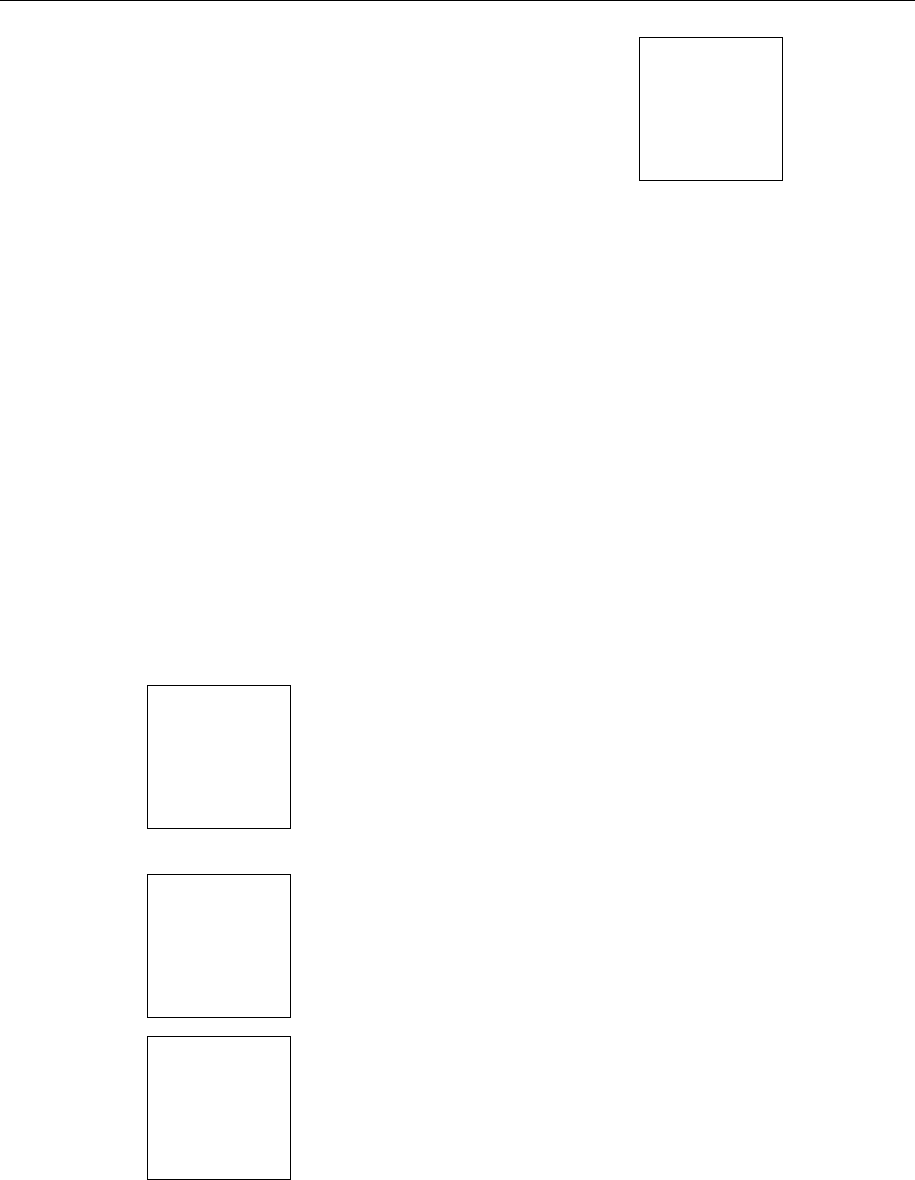
TheaterTouch System Controller
60
1. Select the buttons using the Select Button tool from the
Tool Palette.
2. Click the right mouse button on one of the selected buttons, either
touchscreen or keypad buttons and choose Edit Properties.
For an explanation of all the button properties, see the “How to Edit Button
Properties” section.
Note: Not all of the tabs and/or controls will be available simultaneously. Only the
options relevant to the button(s) being edited will be shown.
A note about Multiple Selections
If you have more than one button selected, it is possible that they will initially
have different settings.
The following meanings apply to options with a check box:
All buttons in the selection will retain their original values for
the setting.
All buttons in the selection will have the setting set to TRUE
All buttons in the selection will have the setting set to FALSE
If options with numerical fields have different values, they will be left blank.
If you DO NOT enter a number, all the buttons will retain their original
setting. If you DO enter a number, all the buttons will be set to that value.

Chapter 5 • TheaterTouch Designer Advanced Features
61
If options with radio buttons have different settings, NONE of the radio
buttons will have a dot next to them. In that case, each button will retain its
original function. If you do wish to assign the SAME function to EVERY
button, select one of the functions from the dialog.

TheaterTouch System Controller
62
HOW TO PRINT SCREENSHOTS
TheaterTouch Designer comes with the ability to print screenshots of the individual
frames of your remote file for reference purposes.
To print screenshots of the open remote file:
1. Choose Print from the File menu.
2. Choose whether you want to
a) Print Current Page Only – Prints a life-sized image of all of the frames
of the currently displayed page.
b) Print All Pages on One Sheet – Prints all of the frames from all of the
pages in the current file on a single sheet of paper, scaling them if
necessary.
c) Print All Pages, 1 Per Sheet – Prints life-sized images of all of the
pages in the current file, with all of the frames from each page
grouped together on individual sheets of paper.
3. Click OK.
HOW TO PRINT SYSTEM CONFIGURATION REPORTS
TheaterTouch Designer comes with the ability to create System Configuration Reports.
This report is for archival purposes as well as a visual reference guide of the system
options and each IRF-6 configuration.
To print the Configuration Report of the open remote file:
1. Choose System Configuration Report from the File menu.
2. Click the Print command button.
3. Click OK to close.
To copy the Configuration Report of the open remote file to the Windows clipboard:
1. Choose System Configuration Report from the File menu.
2. Click the Copy command button.
3. The System Configuration Report is now on the Windows clipboard.
4. Click OK to close.

Chapter 5 • TheaterTouch Designer Advanced Features
63
HOW TO CHECK MEMORY USAGE
It is possible, though not likely, to create a file in TheaterTouch Designer with more
information than the TheaterTouch can hold. To make sure this does not happen, use
the Check Memory Usage command on the Edit menu to see how large the current
file is.
The Remote Memory Used dialog displays the amount of space that buttons,
bitmaps, custom buttons, commands, and macros take up in the TheaterTouch system
controller’s 128KB of memory. The pie chart in the dialog represents the amount of
memory that each of the object types uses.
If the memory is more than 100% full, the Free line will show a negative amount of
memory, and will be flashing red. In this case, the following warning will be
displayed in the dialog box:
You will have to delete enough objects so that the Free line is not flashing red before
you can send this file to the TheaterTouch.

TheaterTouch System Controller
64
HOW TO CREATE A “SELF-DOWNLOADING .EXE”
This command creates an executable from the current file that will automatically
download itself to the remote when run. These executables can be distributed to
client sites to simplify the process of updating remotes in the field.
TheaterTouch Designer does not need to be installed for the self-contained executable
to work.
To make a Self-Downloading .EXE of the current file:
1. Choose Create Self-Downloading .EXE from the Communications menu.
2. Choose the location you want to save the file in the Save in address box.
3. Enter the name of the file in the File Name box.
4. Click the Save button to save and close.
You can now put the .EXE file on a diskette or E-Mail it.
HOW TO USE THE “SEND” COMMAND
This command sends the current file through electronic mail. This command is only
available if your computer has a properly configured e-mail client that is compatible
with the Microsoft MAPI specification. Microsoft Exchange and Microsoft Outlook
are two examples of MAPI-compliant e-mail clients.
TheaterTouch Designer does need to be installed for the file to work.
To send the current file via E-Mail:
1. Choose Send from the File menu.
2. The default E-Mail program will open with the current file inserted as an
attachment with the extension .rti.
3. Send the E-Mail as required by you E-Mail program.

Chapter 6 • IR Library Manager
65
Chapter 6. IR Library Manager
The TheaterTouch reproduces the infrared commands of other remote controls. Each
of these infrared commands must be captured (learned) and placed into the
TheaterTouch Designer Command Library.
This is done by using the original remote control (the donor) from a piece of
equipment to teach its commands to the TheaterTouch. The TheaterTouch then
transfers the captured command to the Infrared Library Manager software through
its RS-232 serial port. Once a command is placed in the infrared library, it never has
to be captured again.
Before you can send infrared commands to the PC, you need to create a new remote
file by going to the IR Library Manager in the TheaterTouch Designer software.
INFRARED CODES
There are two types of infrared codes that are commonly used for consumer
electronics products: Frequency Modulated and Pulsed.
FREQUENCY MODULATION
This type of transmission modulates the IR energy at a fixed carrier frequency. The
vast majority of consumer electronics remote controls use a carrier frequency around
40kHz, although the carrier can range from 15kHz to 455kHz or higher. The
TheaterTouch is designed to reproduce carrier frequencies between 15kHz and 460kHz.
The actual code consists of bursts of IR energy modulated at the carrier frequency,
separated by pauses.
The code is defined by the length of each burst and each pause, as well as by the
carrier frequency.

TheaterTouch System Controller
66
PULSED IR CODES
This type of transmission does not use a carrier frequency.
Pulsed codes are quite common in cable TV converter boxes.
HOW THE THEATERTOUCH LEARNS IR CODES
There are many different encoding schemes used for IR codes. The burst and pause
times have fixed lengths, variable lengths, or some combination of the two. To learn
the code, the TheaterTouch “records” a sample of the code in a manner similar to the
way a tape recorder records sound. Once a sample of the code has been taken, it is
analyzed to find any repeating patterns.
Some codes continuously repeat themselves for as long as the button is pressed.
Others send a code followed by a “keep alive” pattern. Some codes don’t repeat at
all. Any of the above types of codes can also have some sort of preamble in front of
them. It is very important to capture the preamble in this type of code. The IR
learning buffer of the TheaterTouch is large enough to accommodate the preamble.
When a repeating pattern is found, extra repeats are stripped off before the code is
stored in memory. The number of repeats is also stored so the code can be
reproduced accurately.
If the buffer was filled up during learning, it is assumed that the pattern should be
repeated for as long as the key is pressed. This is common for commands such as
Volume, Balance, and Scan— functions that may need to be continuously repeated.
For these types of commands, Sustain is set ON as the Edit IR default. If the buffer is
not filled, Sustain is set OFF and the repeat pattern is displayed as the Minimum
Repeats.
The default Minimum Repeats for a code with Sustain ON is one. This means the
repeating pattern will repeat at least one time when the button is pressed. You can
edit this if necessary, in the Edit IR mode of Infrared Library Manager software.
If the code uses a carrier frequency, that frequency is also stored with the code.

Chapter 6 • IR Library Manager
67
HINTS FOR LEARNING IR CODES
Always place the TheaterTouch and the donor remote control on a flat surface. You
may find it necessary to elevate the donor or the TheaterTouch with a book or similar
object to align them vertically.
Once you have learned and tested a code from a remote, try not to move it until you
have learned all the codes. If you do accidentally move either remote, you should re-
align them.
It is VERY IMPORTANT to make sure the donor remote is using fresh batteries. The
TheaterTouch needs a strong IR signal to properly learn a code. If the frequency read-
out in the ALIGN mode is 0.0 kHz, then the code is a pulsed type. In this case, you
should transmit the commands to the TheaterTouch from the longest distance you can
without getting an error message.
If you always get an error message when trying to learn a code, you should try
moving the donor remote up and down or back and forth. If this does not help, try
tapping the buttons on the donor instead of holding them down.
Many commands can be made more reliable if the number of repeat times is
increased. This is especially true for commands assigned to buttons that are likely to
be briefly “tapped” or for commands that are part of a macro.
Increasing the number of repeat times increases the probability of the command
“getting through.” This is essentially a trade-off between increased reliability and an
increase in the length of time required to transmit a command. This can take a bit of
fine-tuning on complicated macros.
Keep in mind that the IR transmit LEDs may not be located in the center of the donor
remote. It may be necessary to place the remote off-center to get a reliable capture.

TheaterTouch System Controller
68
HOW TO OPEN THE IR LIBRARY MANAGER
1. Choose IR Library Manager from the Library menu from the
TheaterTouch Designer toolbar.
2. From here, you can decide to create a new library of commands or add to
an existing library by choosing from the File menu either New or Open.
HOW TO CREATE A NEW IR LIBRARY
1. Choose New from the File menu, the Create IR Library dialog box will
open.
2. Enter the name of the new library in the File name box.
3. Be sure to save your new file in the Command Libraries folder of the
TheaterTouch Designer software folder.
4. Click the Save button to create the library.

Chapter 6 • IR Library Manager
69
Once you click the Save button, the Edit View dialog box will open showing you the
remotes that are in that particular library. If there are no remotes in that library, such
as after creating a new library, the fields will be empty.
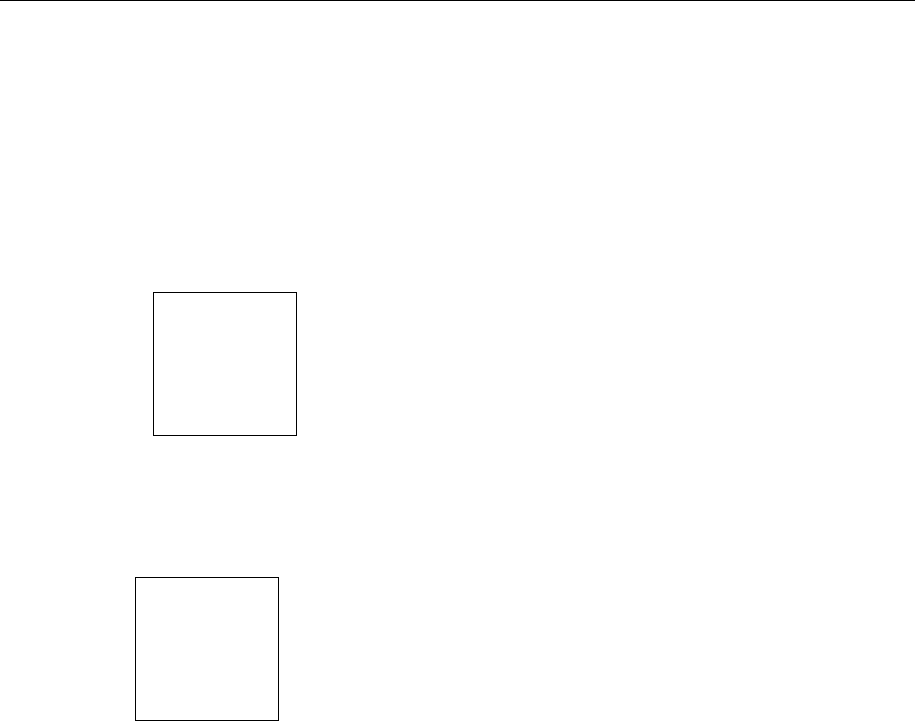
TheaterTouch System Controller
70
HOW TO OPEN AN EXISTING IR LIBRARY
1. Choose Open from the File menu.
2. When the Open IR Library dialog box opens, select the file you wish to
open.
3. Click the Open button.
Once you click the Open button, the Edit View dialog box will open showing you the
remotes that are in that particular library.

Chapter 6 • IR Library Manager
71
HOW TO ADD A NEW REMOTE TO AN IR LIBRARY
1. Click on the New button on the upper right hand side of the Edit View
dialog box.
2. This will open the Create New Remote dialog box.
3. Enter the manufacturer’s name, type of equipment, (such as TV, VCR,
Drapes, Lights and so on) and model number of the component or remote
in the appropriate fields.
4. In the function field, enter the name of the actual commands you are
going to learn (such as Channel+, Channel-, Volume+, Volume-, Power, 1,
2, 3 and so on).
5. After you enter each function name click on the Add command button to
save, you can always edit the name of a function later if you make a
mistake or add a function.
6. Repeat steps 4 and 5 for each button on the remote.
7. When done entering information about new remote, click on the OK
command button to save and close.

TheaterTouch System Controller
72
HOW TO USE THE NEW REMOTE WIZARD
If you are entering a commonly used component to the IR Library, you can use the
New Remote Wizard to enter the titles of commonly use commands for that type of
equipment.
1. Open the Create New Remote dialog box.
2. Enter the information on the equipment you are about to learn commands
from. The manufacturers name, type of equipment, (such as TV, VCR,
Drapes, Lights and so on) and model number of the component or remote
in the appropriate fields.
3. Click the Wizard command button; this will open the New Remote
Wizard dialog box.
4. Check or uncheck the function titles you wish to insert and click OK.
5. You can always edit the name of a function later if you make a mistake or
add a function.
6. When done entering information about new remote, click on the OK
command button to save and close.

Chapter 6 • IR Library Manager
73
HOW TO ALIGN A DONOR REMOTE CONTROL
To ensure that a valid signal is being received, all donor remote controls must be
properly aligned with the TheaterTouch learning window. This is the window located
on the front of the unit.
The TheaterTouch has an ALIGN function to help determine the correct position in
front of the learning window, and determine the modulation frequency of the donor
remote’s infrared signal. This function is invoked upon entering the IR CAPTURE
mode from the CONTROL PANEL page.
IMPORTANT: The Align function determines the modulation frequency of the
donor remote’s infrared signal; so all donor remote controls must be aligned before
being captured.

TheaterTouch System Controller
74
To properly align a donor remote control with the TheaterTouch:
1. Make sure the donor remote has fresh batteries then line up donor remote
so that is at the same height as the learning window on the TheaterTouch.
It may be necessary to place the donor remote control on a higher surface
than the TheaterTouch, or vice-versa.
2. Press any key on the donor remote control, moving the remote back and
forth in front of the learning window. The donor remote control is located
at the proper distance from the TheaterTouch when the Signal box is on
(darkened) and the frequency read-out is stable. The frequency readout
should not be 0.0kHz if it is possible to get it to read any other number by
moving the donor remote around. If the Signal box is off (white), the
TheaterTouch is not detecting any infrared signal.
3. If the Overload box is darkened, the donor remote is too close to the
TheaterTouch. Move the donor remote away from the TheaterTouch until
the Overload indicator turns white.

Chapter 6 • IR Library Manager
75
HOW TO CAPTURE INFRARED COMMANDS
Once a donor remote control is properly aligned, the TheaterTouch is ready to start
capturing the IR commands and transferring them to the Infrared Library Manager
Software.
1. Make sure the TheaterTouch is in the IR CAPTURE LEARN MODE on
frame 2 of the IR CAPTURE page and says STATUS: READY.
The last frequency measured with the ALIGN function should be
displayed at the bottom of the screen. If it is not, you must go through the
Align Procedure again.
2. The communications cable should be connected to the TheaterTouch and
the PC. The TheaterTouch Designer software needs to be running with the
Infrared Library Manager window open.
The dialog box should say Edit View on the title bar with the name of the
infrared library you are working in after it.
3. Click on the Learn IR command button and if you are still properly
aligned, you are ready to start capturing codes.

TheaterTouch System Controller
76
4. Now press and hold the key on the donor remote control that transmits
the command that you want the TheaterTouch to learn. Continue to hold
the key down until the TheaterTouch displays OK.
After the command has been processed, the TheaterTouch will display
Captured then Sending. If an error message is displayed, realign the
donor remote control and try again.
If the IR command was captured properly, it will be stored in a temporary
memory buffer, and transferred to the Infrared Library Manager software
automatically. A red dot will be placed in front of the function text to let
you know that the function has been learned.
The command will remain in memory (for testing) until it is overwritten
by the next captured command. The software will prompt you for each
function command to be learned.
5. To close the IR Capture window in the software click on the Close button.
6. To close the IR Capture page on the remote, press the Main Menu button
on the keypad. The remote will stay in the IR Capture mode until you
manually press the Main Menu button.
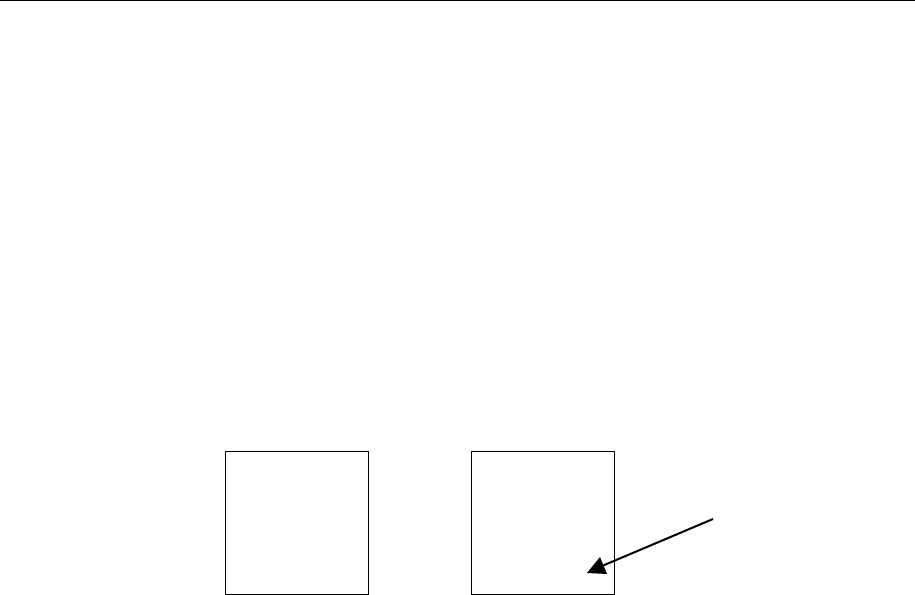
Chapter 6 • IR Library Manager
77
HOW TO TEST INFRARED COMMANDS
After the TheaterTouch has learned a command, you can test it to make sure it
behaves properly.
1. Press the SELECT button while in the IR Capture Test Mode on frame 3 of
IR Capture page, this will test the last captured IR command.
The command will remain in memory (for testing) until it is overwritten
by the next captured command.
2. Make sure you point the TheaterTouch at the equipment to be controlled
when you press the SELECT button.
If the command does not work properly, it may need to be edited or re-
learned.
3. To close the IR Capture window on the remote press the MAIN MENU
button.
SELECT Button

TheaterTouch System Controller
78
HOW TO EDIT INFRARED COMMANDS
Most infrared commands will transmit continuously as long as the remote control key
is held down. This means that either the entire command or some part of it is being
repeated over and over.
The Infrared Library Manager software allows you to adjust the number of command
repeat times and to enable or disable continuous transmission.
Min. Repeats - Enter in this box the number of times that the repeating part of the IR
code is sent by the remote. Some infrared receivers need a command to be repeated
a certain number of times to work properly, and some may not work properly if the
command is repeated at all. Change this setting only if you are having trouble with a
command.
Frequency - This box shows the carrier frequency of the IR code. This is set
automatically. You should not need to change this value unless directed to do so by
Technical Support.

Chapter 6 • IR Library Manager
79
Sustain - Check this box to control whether or not the IR code should repeat if the
button is held down. Most infrared codes will transmit continuously as long as the
button is held down, but some infrared receivers may not work properly if the
command is repeated at all. If the Sustain button is checked, the code will be
transmitted for as long as the button is held down, or the Minimum Repeat times,
whichever is greater. If the Sustain button is not checked, the code will be
transmitted only the Minimum Repeat number of time regardless of how long the
button is held down.
Apply – Use this to save any changes you have made.
Test – Use this to test any changes you have made to a command. Make sure to have
the TheaterTouch hooked up to the computer with the serial cable and have the
remote in Test IR Mode on frame 3 of the IR Capture page in the Control Panel.

TheaterTouch System Controller
80

Chapter 7 • Image Editors
81
Chapter 7. Image Editors
The TheaterTouch Designer software comes with two additional programs for creating
custom graphics. These programs are very similar in appearance and functionality
and both programs can be accessed from the Library menu within the TheaterTouch
Designer program.
The Button Bitmap Editor is for creating and editing button bitmaps for such things
as channel and transport icons.
The Custom Button Editor is for creating and editing custom buttons for such things
as company logos or complex groups of controls.
THE DIFFERENCE BETWEEN CUSTOM BUTTONS AND BITMAPS
Custom Buttons have several fundamental differences from Bitmaps:
1. Custom Buttons must specify an image of the entire button. Bitmaps are
smaller, and therefore can be placed on buttons with the standard border
styles.
2. Custom Buttons can contain more than one active button area, so a whole
group of related controls can be created as a single Custom Button.
Bitmaps are indivisible, and must be placed separately onto individual
buttons.
3. Custom Buttons must provide an image for both the Up (normal) and
Down (pressed) states of the button. Bitmaps provide only the Up image.
The Down image of a Bitmap is created by simply inverting it.
4. Custom Buttons can be any size, up to the entire display size. Bitmaps are
limited to a handful of pre-defined sizes.
Given these characteristics, Custom Buttons are most appropriate for complex or
large groups of controls, such as a customized set of transport controls for a VCR, or
a large company logo.
Bitmaps are most appropriate for small pictures that don’t need a full button to
display, such as TV channel icons or small logos. Since Bitmaps don’t have a Down
image, they take half as much memory to store in the TheaterTouch, so more Bitmaps
can be created.
Both Custom Buttons and Bitmaps are stored within Libraries, not as individual files.
Before you can design your own Custom Buttons or Bitmaps, you must create a new
library file using the Custom Button Editor or Button Bitmap Editor. The library file
can have many Custom Buttons or Bitmaps within it.

TheaterTouch System Controller
82
BUTTON BITMAP EDITOR SCREEN
To open the Button Bitmap Editor, select Button Bitmap Editor from the Library
menu in the TheaterTouch Designer program.
CUSTOM BUTTON EDITOR SCREEN
To open the Custom Button Editor, select Custom Button Editor from the Library
menu in the TheaterTouch Designer program.
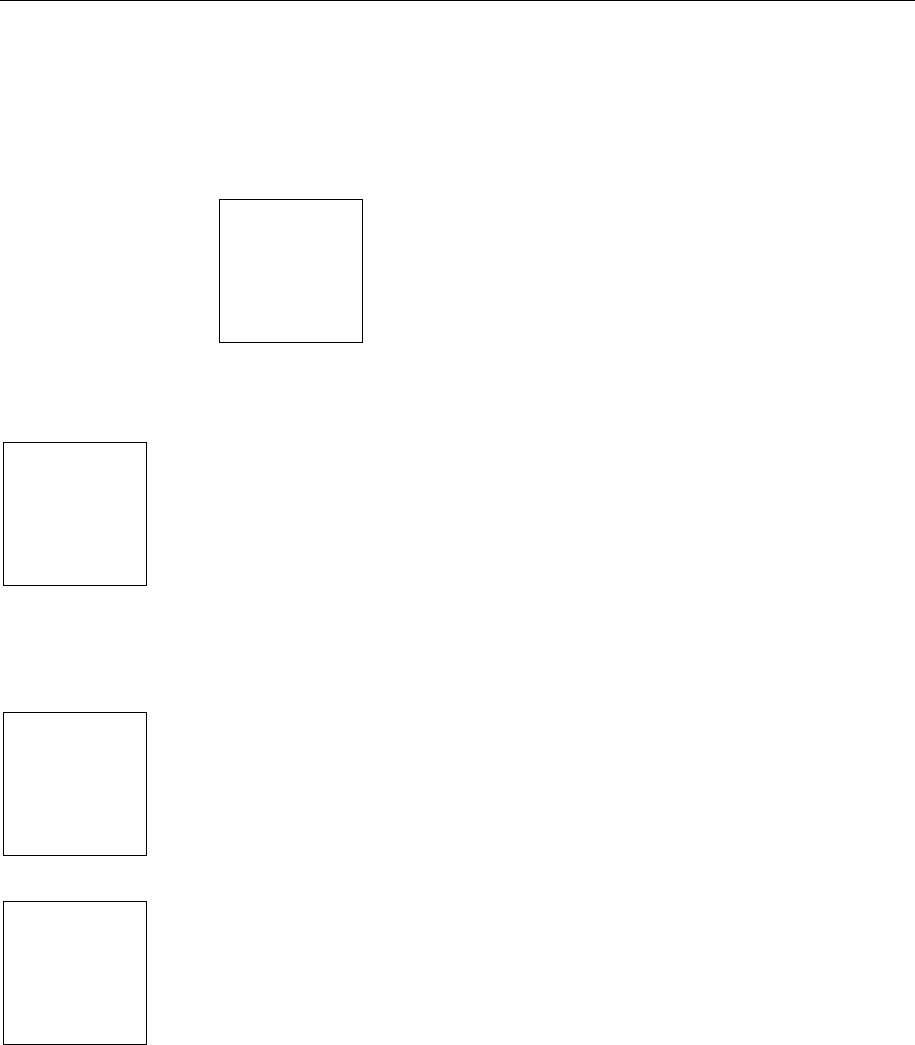
Chapter 7 • Image Editors
83
TOOLBAR
The toolbar provides instant access to commonly used Button Bitmap Editor and
Custom Button Editor functions.
Create New Library Command – Use this command to create a
library to hold your custom buttons or bitmaps. The built in libraries that come with the
software are read-only and new images cannot be saved to them. This
command should only be used when a new library is desired. If you want to create a new
image, use the Create New Image Command.
Open Library Command – Use this command to open existing
libraries. The currently open library, if any, will be closed.
Edit Library Command – Use this command to rename or delete a
custom button or bitmap in a library that you created. The built in libraries that come
with the software are read-only and images cannot be edited. This command is not
available unless a Bitmap Library is open.

TheaterTouch System Controller
84
Create New Image Command – Use this command to create a new
image in the currently open library in the Bitmap Editor, the New Bitmap Size
dialog will be displayed, where you can select the size for the new Bitmap. The
built in libraries that come with the software are read-only and new images cannot be
saved to them.
Open Image Command – Use this command to open an existing
image in the currently open library for editing. When you choose the Open Image
command, the Open Image dialog box is displayed to allow you to select which
image to edit. This command is not available unless a Bitmap Library is open.
Save Image Command – Use this command to save the current
image to the currently open library. If the image has already been saved, this
command updates the existing version. If the image has never been saved before,
this command is the same as the Image Save Image As command, and displays the
Edit Title dialog for you to enter a name. This command is not available unless a
library is open and an image is being edited.
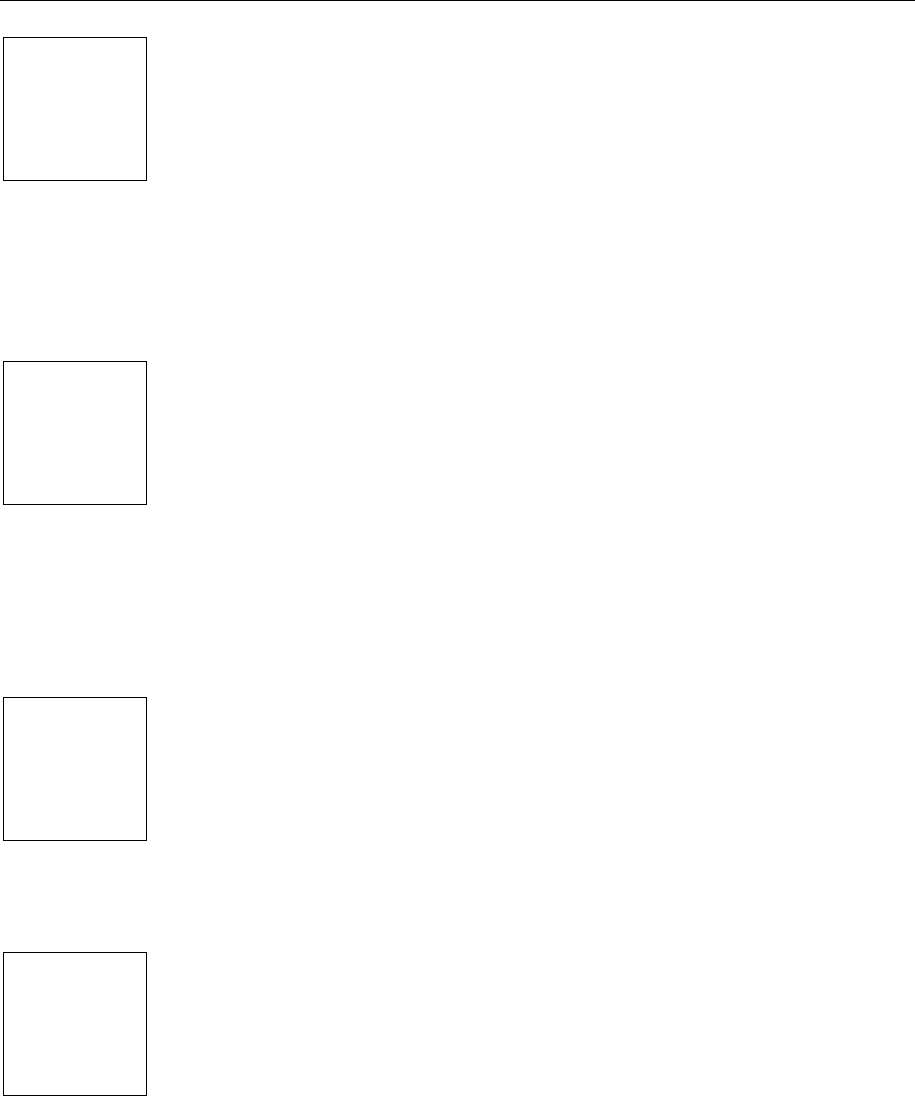
Chapter 7 • Image Editors
85
Undo Command – Use this command to reverse the last change
you made to the image. Choose the Undo command again to reverse the previous
change. A maximum of 64 changes are reversible with the Undo command. The
Undo command can only reverse editing changes to the current image. It cannot
undo changes to a library, and the Undo information is destroyed when the image is
closed or the view is toggled between the Up and Down images in the Custom Button
Editor.
Redo Command – Use this command to cancel the effect of the last
Undo command. Choose the Redo command again to cancel the next Undo. A
maximum of 64 changes can be canceled with the Redo command. The Redo
command can only cancel Undo commands to the current image. The Redo
information is destroyed when the image is closed, when the view is toggled between
the Up and Down images, or when other editing changes are made to the image.
Cut Command – Use this command to move the selected
sections to the Clipboard, this replaces the selection with solid white. You can use
this to move images between the Button Bitmap Editor and the Custom Button Editor.
Copy Command – Use this command to copy selected sections
to the Clipboard. This command does not alter the current image. You can use this to
move images between the Button Bitmap Editor and the Custom Button Editor.

TheaterTouch System Controller
86
Paste Command – Use this command to place previously cut or
copied sections from the clipboard back onto the touchscreen grid and switches the
Button Bitmap Editor or Custom Button Editor into Selection mode. You can drag the
pasted sections to the desired position on the page. You can use this to move images
between the Button Bitmap Editor and the Custom Button Editor. This command is
not available if the data on the Clipboard is not in bitmap format.
Help Topics – Use this command to open the Help Topics
dialog box for more help.
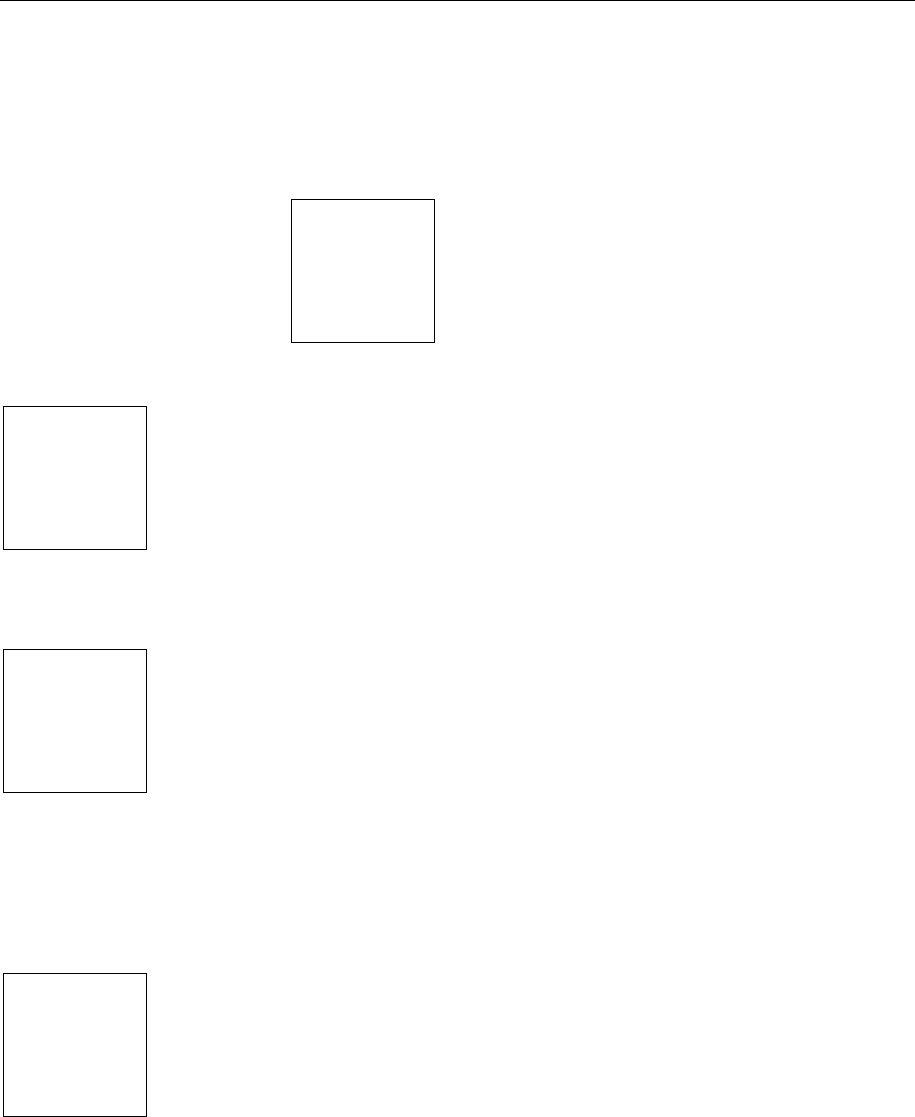
Chapter 7 • Image Editors
87
TOOL PALETTE
The Tool Palette provides access to all the drawing tools used by the Button Bitmap
Editor and Custom Button Editor.
Selection Tool - The Selection Tool is used to define a rectangular
selection region on the image. To define a selection, click the left mouse button in the
Drawing Area where one corner of the selection rectangle should be placed, drag the
mouse to the opposite corner, and release the mouse button.
Button Selection Tool (Custom Button Editor only) - The Button
Selection Tool defines the active button areas on a Custom Button image. To define a
button selection, click the left mouse button in the Drawing Area where one corner
of the selection rectangle should be placed, drag the mouse to the opposite corner,
and release the mouse button. To remove an existing button selection, place the
mouse cursor inside of the selection you wish to remove and click the right mouse
button.
Zoom Tool - The Zoom Tool is used to magnify portions of the
image. Click the left mouse button over a spot in the Drawing Area to “Zoom In”
(make the image larger) or click the right mouse button over a point to “Zoom Out”
(make the image smaller). The Zoom commands on the View menu can also be used
to change the Zoom level.
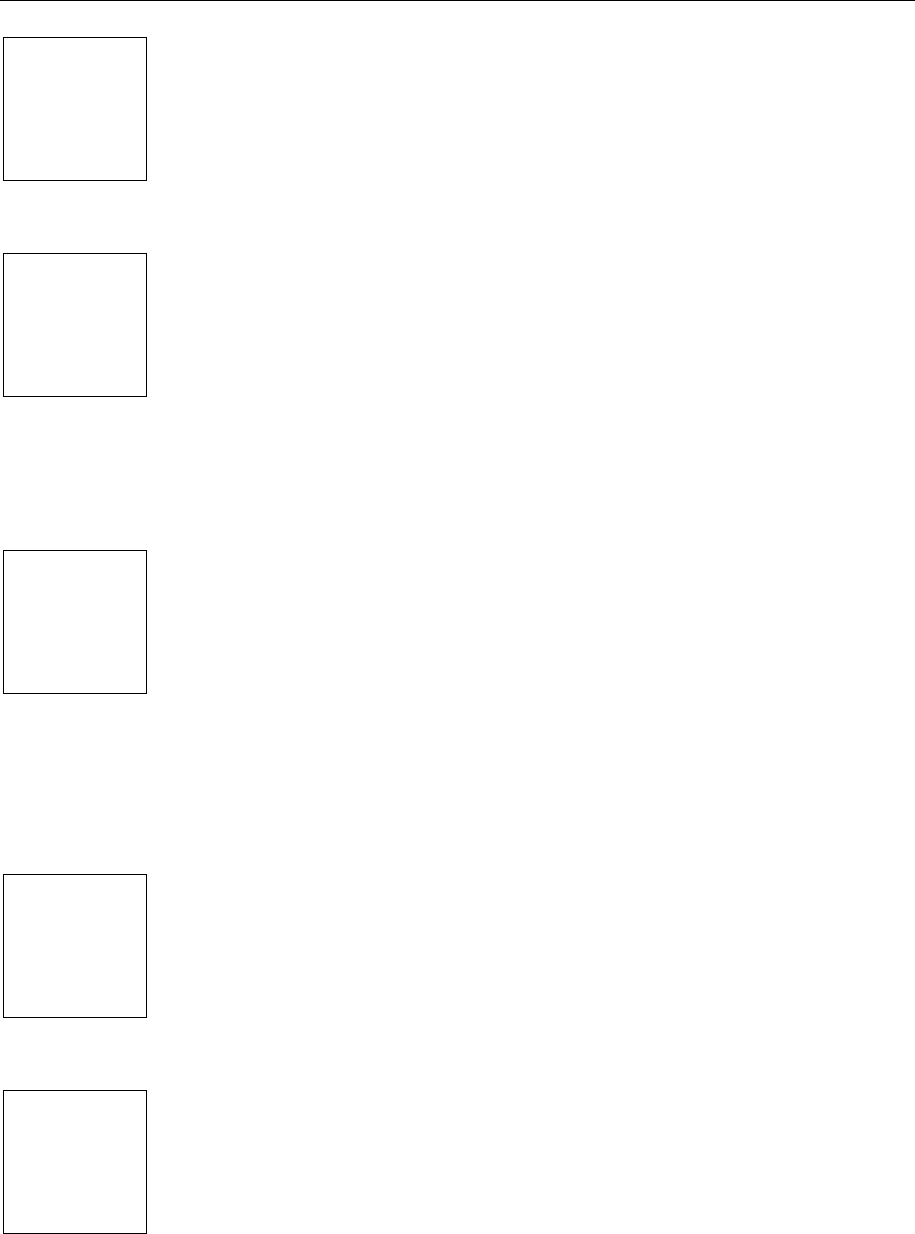
TheaterTouch System Controller
88
Pencil Tool - The Pencil Tool is used to color individual pixels on
the image. Click the left mouse button in the Drawing Area to turn the pixel under
the Pencil point black, and click the right mouse button to turn the pixel white.
Brush Tool - The Brush Tool acts like the Pencil Tool, but colors a
larger portion of the image. The Brush Size, the size of the shape that the Brush
draws, can be changed by clicking on a different sized brush in the rectangular area
below the drawing tools, or by choosing a size from the Brush Size menu under the
View menu. Click the left mouse button in the Drawing Area to turn the pixels
under the Brush black, and click the right mouse button to turn the pixels white.
Fill Tool - The Fill Tool is used to color large portions of the image.
Several Fill Patterns are available in the rectangular area below the drawing tools. To
use the Fill Tool, choose the desired Fill Pattern, and then click the left mouse button
inside of the area to fill. The Fill Tool will color the image with the Fill Pattern in all
directions until it encounters a black line or the edge of the image. If the fill is to be
contained to the inside of a shape, be sure that there are no gaps in the shape’s
border.
Eraser Tool - The Eraser Tool is identical to the Brush Tool except
that clicking the left mouse button draws in white, and clicking the right mouse
button draws in black.
Line Tool - The Line Tool is used to draw straight lines on the
image. To draw a black line, click and hold the left mouse button in the Drawing
Area where one end of the line should go, move the mouse to the other end of the
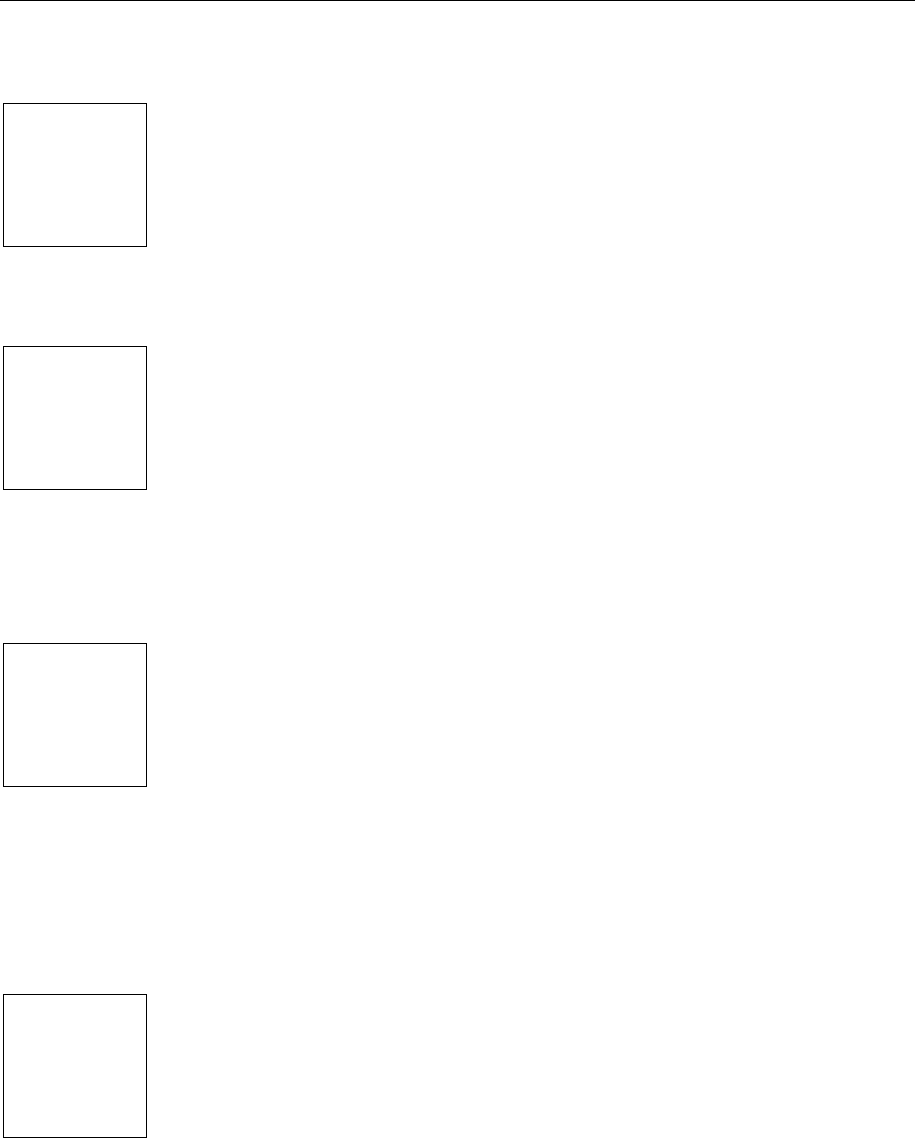
Chapter 7 • Image Editors
89
line, and release the mouse button. To draw a white line, follow the same steps but
click the right mouse button instead of the left.
Text Tool - The Text Tool is used to place text on the image. To
place text, click the left mouse button in the Drawing Area, and the Place Text dialog
will appear. Enter the desired text in the dialog and click OK. The text will appear in
a blue selection rectangle, where it can be placed precisely on the image.
Rectangle Tool - The Rectangle Tool is used to draw rectangles on
the image. Click the left mouse button in the Drawing Area where one corner of the
rectangle should be placed, drag the mouse to the opposite corner, and release the
mouse button. To draw a white rectangle, follow the same steps but click the right
mouse button instead of the left. The portions of the image in the center of the
rectangle are not affected by this tool.
Rounded Rectangle Tool - The Rounded Rectangle Tool is used to
draw rectangles with rounded corners on the image. The radius of the corners is the
same as that of “Radius” buttons on the TheaterTouch. Click the left mouse button in
the Drawing Area where one corner of the rounded rectangle should be placed, drag
the mouse to the opposite corner, and release the mouse button. To draw a white
rounded rectangle, follow the same steps but click the right mouse button instead of
the left. The portions of the image in the center of the rounded rectangle are not
affected by this tool.
Circle Tool - The Circle Tool is used to draw circles and ovals on
the image. Click the left mouse button in the Drawing Area where one corner of the
imaginary rectangle that bounds the circle should be placed, drag the mouse to the
opposite corner, and release the mouse button. To draw a white circle, follow the
same steps but click the right mouse button instead of the left. The portions of the
image in the center of the circle are not affected by this tool.
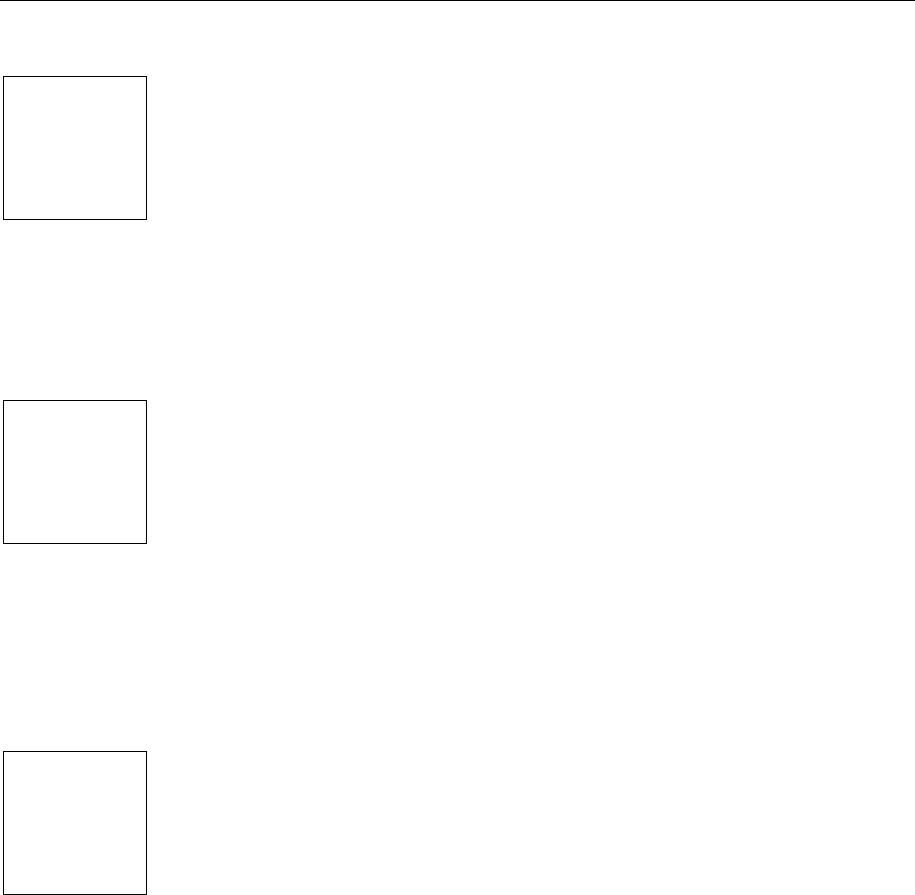
TheaterTouch System Controller
90
Filled Rectangle Tool - The Filled Rectangle Tool is used to draw
rectangles filled with a Fill Pattern on the image. Several Fill Patterns are available in
the rectangular area below the drawing tools. To use the Filled Rectangle Tool,
choose the desired Fill Pattern, click the left mouse button in the Drawing Area
where one corner of the rectangle should be placed, drag the mouse to the opposite
corner, and release the mouse button. To draw a solid white rectangle, follow the
same steps but click the right mouse button instead of the left.
Filled Rounded Rectangle Tool - The Filled Rounded Rectangle
Tool is used to draw rectangles with rounded corners filled with a Fill Pattern on the
image. Several Fill Patterns are available in the rectangular area below the drawing
tools. To use the Filled Rounded Rectangle Tool, choose the desired Fill Pattern,
click the left mouse button in the Drawing Area where one corner of the rectangle
should be placed, drag the mouse to the opposite corner, and release the mouse
button. To draw a solid white rounded rectangle, follow the same steps but click the
right mouse button instead of the left.
Filled Circle Tool - The Filled Circle Tool is used to draw circles
and ovals filled with a Fill Pattern on the image. Several Fill Patterns are available in
the rectangular area below the drawing tools. To use the Filled Circle Tool, choose
the desired Fill Pattern, click the left mouse button in the Drawing Area where one
corner of the imaginary rectangle bounding the circle should be placed, drag the
mouse to the opposite corner, and release the mouse button. To draw a solid white
circle, follow the same steps but click the right mouse button instead of the left.
UP IMAGE-DOWN IMAGE TOOL (Custom Button Editor Only):

Chapter 7 • Image Editors
91
Click on the Up Image button to display the Up Image in the Drawing Area, or click
on the Down Image button to display the Down Image.
All Custom Buttons have two totally separate images, an Up image, which represents
the button in its normal state; and a Down image, which represents the button in its
pressed state. The Up image is the picture that is normally displayed by the
TheaterTouch, unless the button has its Reversed property set, in which case the
Down image is normally displayed.

TheaterTouch System Controller
92
In most cases, you will find it easiest to create the Up image first. As a starting point
for creating the Down image, you may want to select the whole Up image, copy it to
the Clipboard, switch to the Down image, and paste the image from the Clipboard.
At this point, you can use the editor to modify the image you pasted to make it the
Down image. If a simple reversal is all you need, the Invert Selection command on
the Edit menu will do the trick.
NEW BITMAP SIZE DIALOG BOX (Button Bitmap Editor Only):
The New Bitmap Size dialog box opens when you select the Create New Image
command. You can choose from the five sizes listed in the dialog box, a sample of the
size will be displayed in the Sample section.
26 by 10 pixels = 1 section wide by 1 section high, which is the smallest button
bitmap size.
26 by 26 pixels = 1 section wide by 2 sections high, which is the standard channel
icon size.
58 by 26 pixels = 2 sections wide by 2 sections high, which is one-third of the
touchscreen
58 by 42 pixels = 2 sections wide by 3 sections high, which is half of the touchscreen.
58 by 58 pixels = 2 sections wide by 4 sections high, which is two-thirds of the
touchscreen.

Chapter 8 • Troubleshooting
93
Chapter 8. Troubleshooting
If you have difficulty with your TheaterTouch universal system controller, read
through these troubleshooting tips and common questions before contacting technical
support.
If you continue to have difficulties, do not hesitate to contact technical support. See
chapter 9 for more information on contacting RTI.
DISPLAY IS DIM, BLANK OR UNREADABLE
Make sure the battery pack is snapped on the remote properly and that the battery is
charged.
Try adjusting the contrast of the touchscreen on the Control Panel page of the
remote. By nature, the contrast of an LCD screen changes with temperature, so if the
remote is cold the display will be dark and will lighten as it warms. (Refer to Chapter
2 for more details)
The remote may have timed out, turning off the display. You can change the Time
Out time on the Control Panel page of the remote to your liking. (Default time is 10
seconds) (Refer to Chapter 2 for more details)
COMMUNICATION PROBLEMS
Make sure the Computer Link button on frame 3 of the Control Panel page of the
TheaterTouch is pressed before beginning the communication operation.
Make sure you are using the programming cable that was supplied with the unit and
that both ends are connected securely.
If the only serial port on your computer has a serial mouse plugged into it, you can
disconnect the mouse and use that port with the TheaterTouch Designer software. If
you do this, you MUST restart Windows with the mouse unplugged before
TheaterTouch Designer will be able to use the port.
If the serial port you are trying to use is COM 3 or COM 4, make sure that it is not
sharing an interrupt request (IRQ) line with COM 1 or COM 2. The default
configuration for COM 1 and COM 3 both share IRQ 4, and COM 2 and COM 4 both
share IRQ 3. Contact your computer manufacturer for more information on
configuring your serial ports.

TheaterTouch System Controller
94
If you are trying to use the second serial port on your computer, it is possible that it is
disabled in the computer’s CMOS (or BIOS) setup. Consult your computer’s
documentation or contact your computer manufacturer for more details.
If your computer is a notebook or laptop, be sure that the external serial port is
enabled properly. Some laptops, especially (but certainly not limited to) IBM
ThinkPads, have their external ports disabled by default.
• If your computer has an IrDA infrared port, there may be a setting where you
can choose between the infrared port and the serial port.
• Some portable computers with Advanced Power Management disable the
external serial ports to conserve battery power.
• Some with PCMCIA card sockets reserve the COM 2 connector for use with a
PCMCIA card.
• You may need to run your computer’s setup or configuration program to
enable the port. Consult your computer’s documentation or contact your
computer manufacturer for more details.
Make sure no other software running on your computer is trying to access the serial
port. If you have a PDA (such as a 3COM Palm Pilot or Apple Newton), scanner
(such as a Visioneer PaperPort), graphics tablet, fax modem or other serial devices
that plug into the same serial port, you need to disable its software and restart
Windows before TheaterTouch Designer can use that serial port.
If you have an internal modem and an external COM port at the same address, the
external COM port will not work and must be reconfigured. For example, if the
internal modem is set to use COM 2, the computer’s built in COM 2 port will not
function correctly.
Use the Auto Detect option in the Communication Setup dialog box. Use the Set
COM Port command on the Options menu to display the Communication Setup
dialog box and then click the Auto Detect command button to determine which serial
port the remote is connected to. The serial port on your computer may be mislabeled.
If you are communicating with the TheaterTouch and the transfer fails after some data
has been transferred, your computer may not support TheaterTouch Designer’s high-
speed communication protocol. Use the Set COM Port command on the Options
menu to display the Communication Setup dialog box and select the “Medium” or
“Low” communication speed.

Chapter 8 • Troubleshooting
95
INFRARED PROBLEMS
The TheaterTouch and TheaterTouch Designer software are compatible with infrared
(IR) commands with carrier frequencies between 15kHz and 460kHz. This covers the
vast majority of remotes available to date, including Bang & Olufsen® (most of which
use 455kHz) and Vidikron® (some of which use 333kHz).
However, some older Pioneer® Elite remotes have a carrier frequency of 1.125MHz
and are not compatible with most IR products, including the TheaterTouch and
TheaterTouch Designer software. You can however use IR commands from regular
(non-Elite) Pioneer® remotes, which have a carrier frequency of 40kHz. These
regular Pioneer® IR commands operate the basic functions of the Elite products.
When learning IR commands, use fresh batteries in the donor remote. Even if the
donor remote still operates the equipment, using fresh batteries will ensure good,
strong, clean signals.
• Keep ambient light to a minimum. Avoid bright overhead lighting such as
fluorescent and neon lighting or direct sunlight.
• Make sure the donor remote is positioned properly. The TheaterTouch has
a signal level display that indicates when the donor remote is too close or
too far away from the learning window. Just the Signal box should light
(go dark) when you have the proper level.
• Once you have proper alignment, do not move either the TheaterTouch or
the donor remote until done learning all the commands you wish to learn.
• Because every remote is different, you must go through the alignment
procedure every time you learn any new commands to insure the best
possible range and consistency of each IR command.
If a learned command is not working properly, try relearning the command making
sure to go through the entire alignment procedure.
If you are using an IR repeater system, make sure it is working flawlessly with the
donor remote, if not you need to fix or repair the IR system. The TheaterTouch remote
even with its advanced features cannot overcome these kinds of problems.
If you are still having problems, try using the Edit IR function in the Infrared Library
Manager to adjust the frequency up or down in small steps you should retest the
command after each change. This can be done by clicking on the Test command
button on the bottom of this page.

TheaterTouch System Controller
96
UNABLE TO LEARN COMMANDS
If for some reason you are unable to learn commands into the TheaterTouch, or you
cannot get commands to work, contact Technical Support to see if we can help you.
You may wish to check our web site to see if the codes are already available.
If need be we can try to learn the commands for you at our factory by sending us the
donor remote.
If successful, we can send you the commands via E-Mail or on diskette so you can
insert them into your remote file. It will also be posted on our web site for others to
use.
MACRO PROBLEMS
If you are having problems with missed commands in macros but the IR commands
work fine when placed on individual buttons try editing the Minimum Repeats in
the Macro Editor to increase the number of times the command is repeated.
Click on the Edit Macro tool from the Tools dialog box on the bottom of the main
screen, click on the button on which the macro you are having trouble with is. When
the Edit Macro dialog box opens, double-click on the specific IR command you are
having the trouble with, when the Edit Infrared Command dialog box opens, change
the number of repeats to 4 or 5 to start with and if that doesn’t work, bump it up to 7
or 8.
As always, when you make any changes to your file, be sure to send the new file to
the remote and thoroughly test your changes.
Minimum Repeats is usually set between 0 and 3, but some commands may need to
be repeated more times. You can set the number of repeats as high as you need to get
consistent results.

Chapter 9 • Service and Support
97
Chapter 9. Service and support
UPDATES AND NEW PRODUCTS
For news about the latest updates, new product information and accessories, please
visit our web site at:
www.TheaterTouch.com
CONTACTING REMOTE TECHNOLOGIES INCORPORATED
For general info, you can contact RTI at:
Info@rticorp.com
Remote Technologies Incorporated
Tel. (612) 253-3100
Fax (612) 253-3131
www.rticorp.com
RTI TECHNICAL SUPPORT
At RTI, customer service and satisfaction is an utmost priority. If you are
encountering any problems or have a question about your RTI product, please
contact RTI Technical Support for assistance.
RTI provides technical support by telephone, fax or E-mail. For the highest quality
service, please have the following information ready, or provide it in your fax or E-
mail.
♦ Your Name
♦ Company Name
♦ Telephone Number
♦ E-mail Address
♦ Product model and serial number (if applicable)

TheaterTouch System Controller
98
If you are having a problem with hardware-note the equipment you are using, what
the problem is you are having and any troubleshooting you have tried.
If you are having a problem with software-note what version software you are using,
the operating system on your PC, what the problem is you are having and any
troubleshooting you have tried.
If you are calling in regards to a software or programming question or problem,
please be at you computer when you place your call, this will considerably speed up
the troubleshooting process.
For technical support or assistance with your TheaterTouch remote, software or
accessories, contact RTI at:
(612) 253-3137
support@rticorp.com
www.rticorp.com/support
For questions regarding service or repair of your TheaterTouch remote control, contact
RTI at:
(612) 253-3136
service@rticorp.com
www.rticorp.com/service
Please do not return products to Remote Technologies Incorporated without return
authorization.

Chapter 9 • Service and Support
99
SHIPMENT OF REMOTE FOR SERVICE
Remote Technologies Incorporated will pay all labor and material expenses for all
repairs covered by this warranty. If necessary repairs are not covered by warranty,
or if a unit is examined which is not in need of repair, you will be charged for the
repairs or examination.
If it is necessary to ship the TheaterTouch system controller for service:
Please pack it securely and we suggest that it be insured.
Do not include accessories such as power cords or manuals.
Please back up your internal program. Although every effort is made to save this
data and reload it after repair, Remote Technologies Incorporated is neither liable
for its loss, nor responsible for providing a back up for you.
You must pay any shipping charges incurred in getting your TheaterTouch system
controller to Remote Technologies Incorporated. Remote Technologies Incorporated
will pay reasonable return shipping charges via a carrier of our choice to any
destination within the United States if the repairs are covered under warranty.
A copy of the original dated sales receipt must be provided whenever warranty
service is required. You will need this receipt to establish the date of purchase.

TheaterTouch System Controller
100
Specifications
Power: 4.8 VDC, 900 mA NiMH Battery Pack
Power Management: Automatic on/off (tilt switch)
Infrared Control Range: 30 Feet (9.1m) @ 60 Degrees
Infrared Frequency Range: 15kHz – 460kHz
(learning and transmission)
Radio Frequency Control Range: Up to 100 Feet (30.5m)
(with optional IRF-6 System Interface)
Radio Frequency Carrier: 418MHz (U.S. Model)
Operating Temperature: +32°F to +122°F (+0°C to +50°C)
Operating Humidity: 5% to 95% Non-condensing
Touch Panel Display: High-resolution STN LCD Digital Matrix
128 x 64 pixels (Blue on Paper White)
Touchscreen never needs calibrating
Display size (HW): 2.4 in. x 1.3 in. (61mm x 33mm)
Backlights: White EL (Display), Blue EL (Keypad)
Nominal Run Time on Full Charge: 6.5 hours minimum, continuous use
(10 to 15 days on average use)
Standby Time on Full Charge: 30 Days
Battery Charge Time: 3-4 Hours
Total System Memory: 128K Bytes Flash (non-volatile) memory
Device Capability: Total number of devices is limited only
by memory
Macro Capability: Up to 64 steps in a single macro
-Total number of macros is limited
only by memory
-Macro capability on every button

Specifications
101
Communications: PC compatible RS-232 port
TheaterTouch Device ID: 10 unique ID codes available
Optional IRF-6 System Interface ID: 10 unique ID codes available
Dimensions- Length: 9.9 in. (251mm)
Width: 2.4 in. (61mm) body, 2.9 in. (74mm) center
Height: 1.1 in. (28mm)
Enclosure: High impact molded ABS with textured finish
Weight: 11 oz. (312g) with battery pack
8 oz. (227g) without battery pack
All specifications subject to change without notice.

TheaterTouch System Controller
102
Appendix
SOFTWARE LICENSE AGREEMENT
(SINGLE USER PRODUCTS). This is a legal agreement between you (either an
individual or an entity) and Remote Technologies Incorporated. By installing the
software accompanying this guide you are agreeing to be bound by the terms of the
agreement. If you do not agree to the terms of this agreement, promptly return the
software CD-ROM and the accompanying items to the place you obtained them for full
refund.
SOFTWARE LICENSE
GRANT OF LICENSE. This License Agreement permits you to use one copy of the
Remote Technologies Incorporated software program (the “SOFTWARE”) on a single
computer. The SOFTWARE is in “use” on a computer when it is loaded into temporary
memory (i.e. RAM) or installed into permanent memory (e.g. hard disk, diskette, CD-
ROM or other storage device) of that computer. However, installation on a network
server for the sole purpose of internal distribution shall not constitute “use” for which a
separate license is required, provided you have separate license for each computer to
which the SOFTWARE is distributed.
COPYRIGHT. The SOFTWARE is owned by Remote Technologies Incorporated and
is protected by United States copyright laws and international treaty provisions.
Therefore, you must treat the SOFTWARE like any other copyrighted material (e.g. a
book or musical recording) except that you may either (a) make one copy of the
SOFTWARE solely for backup or archival purposes, or (b) transfer the SOFTWARE to a
single hard disk provided you keep the original solely for backup or archival purposes.
You may not copy the written materials accompanying the SOFTWARE.
LIMITED WARRANTY. Remote Technologies Incorporated guarantees that the disks
on which the software is distributed are free from defects in materials and workmanship
for a period of ninety (90) days from the date of purchase. Any written or oral
information or advice given by Remote Technologies Incorporated distributors, dealers,
agents or employees will in no way increase the scope of this warranty. If the software
fails to meet the specifications of the warranty set forth above, Remote Technologies
Incorporated liability and your exclusive remedy will be replacement of the CD-ROM or
reasonable effort to make the product meet the above warranty specification.
LIABILITY. In no event shall Remote Technologies Incorporated or its suppliers be
liable for any damages (including but not limited to damages for loss of profits, business
interruption or loss of information) arising out of the use of or inability to use this
software. Because some states do not allow for the exclusion or limitation of liability for
consequential or incidental damages, the above limitation may not apply to you.

Appendix
103
OTHER RESTRICTIONS. You may not rent or lease the SOFTWARE, but you may
transfer the SOFTWARE accompanying written materials on a permanent basis
provided you retain no copies and the recipient agrees to the terms of this Agreement.
You may not reverse engineer, decompile or disassemble the SOFTWARE. If the
SOFTWARE is an update or has been updated, any transfer must include the most
recent update and all prior versions.

TheaterTouch System Controller
104
Index
—A—
Adding Text, 21
—B—
Battery Recharging, 5
BEEPER, 10
Bitmap Library, 22
—C—
Change passcode, 12
Changing Button Styles, 33
Checking Memory Usage, 59
Clear all, 14
COMPUTER LINK, 13
CONTRAST, 9
Control Panel Page, 8
—D—
Deleting Commands from Buttons, 26
Deleting Macros from Buttons, 40
Design Guidelines, 17
difference between Custom Buttons and
Bitmaps, 77
Duplicating Pages, 31
—E—
Edit Button Properties dialog, 51, 57
Editing Macros, 36
—I—
Inserting a Predefined Page, 33
installing TheaterTouch Designer 1.0, 15
—L—
Linking Pages, 23
—M—
Merge Pages dialog, 32
Merging Pages, 32
—P—
PageWizard, 33
Pasting Buttons, 34
Product Contents, 2
Programming Overview, 15
—R—
Remote Memory Used dialog, 59
Removing Page Links, 24
Renaming a Page, 31
Resizing Buttons, 35
—S—
Software Requirements, 2
—T—
The Difference Between Custom
Buttons and Bitmaps, 77
Tilt switch, 11
Time Out, 10
TouchScreen Display, 8
—W—
Working With Files, 26
Working with Pages, 19